- Analytics
- News and Tools
- Market News
CFD Markets News and Forecasts — 11-01-2022
- Gold prices retreat from two-month-old descending resistance line.
- Cautious sentiment ahead of crucial inflation, World Bank forecsts test gold buyers.
- Fed’s Powell backed rate hikes but balance sheet normalization, demand-supply issues drowned yields, USD.
- Gold Price Forecast: Gold picks up momentum on dollar’s weakness
Gold (XAU/USD) bulls take a breather around the weekly top, recently easing to $1,820, amid an early Asian session on Wednesday. The yellow metal jumped the most since mid-December the previous day after the upbeat market sentiment drowned the US Treasury yields and US dollar.
Fed Chair Jerome Powell during testimony before the Senate Banking Committee could be cited as the major factor that favored the gold prices of late. However, the market’s anxiety ahead of the US Consumer Price Index (CPI) for December joins downbeat World Bank (WB) economic forecasts and virus woes to challenge the gold buyers.
Fed’s Powell showed readiness to hike interest rates to stop inflation from being entrenched but concerns over supply-demand mismatch and balance-sheet runoff weighed poured cold water on the face of US dollar bulls. The Fed Boss said that the balance sheet runoff could happen "perhaps later in the year," while also expecting that the supply crunch will ease somewhat and the economic impact of the Omicron variant will be short-lived.
Additionally, WB’s latest economic forecasts cited coronavirus woes to cut the global GDP expectations for 2022 to 4.1% from 4.3% previous estimations. The World Bank also trimmed economic forecasts for the US and China, by 0.5% to 3.7% and by 0.3% to 5.1% in that order.
Other than Powell’s testimony, US economic calendar was mostly silent with NFIB Business Optimism Index rising past 98.4 to 98.9 for December while IBD/TIPP Economic Optimism for January eased to 44.7 versus 48.4 previous readouts.
Elsewhere, record top daily covid infections in the US also tests the market sentiment and weigh on the gold prices. It’s worth noting, however, that Merck’s update, suggesting its covid treatment pill’s ability to tame coronavirus and all variants, placates the virus fears.
Against this backdrop, the US Dollar Index (DXY) dropped around 0.35% to poke December’s low around 95.60 whereas the Wall Street benchmarks cheered the second consecutive daily fall in the US 10-year Treasury yields by the end of Tuesday’s North American session. That said, S&P 500 Futures and the US Treasury yields remain sluggish at the latest.
Looking forward, US CPI will be crucial for gold prices as market players weigh on the Fed’s pace of rate hikes and balance sheet normalization. Should the headlines inflation figures match 7.0% YoY forecasts, versus 6.8% prior, the metal should extend the latest weakness.
Read: US Inflation Preview: Dizzying heights of 7% would cement a March hike, supercharge the dollar
Technical analysis
Although a clear upside break of the 200-DMA helped gold prices to jump the most in a month the previous day, a downward sloping trend line from mid-November, around $1,825, challenges bulls.
It should be noted, however, that the MACD remains sluggish but the higher low formation and recently improving RSI hints at the metal’s further upside past the immediate resistance line.
Following that, tops marked during July and September, close to $1,834, will be in focus ahead of directing gold buyers towards the $1,850 hurdle.
Meanwhile, a downside break of the 200-DMA level surrounding 1,802 will need validation from the $1,800 threshold to convince gold sellers.
Even so, an upward sloping support line from August, near $1,787 at the latest, will be a tough nut to crack for the gold bears.
To sum up, gold prices are likely to witness further upside, at least technically, but the fundamentals are far more important during the crucial day.
Gold: Daily chart
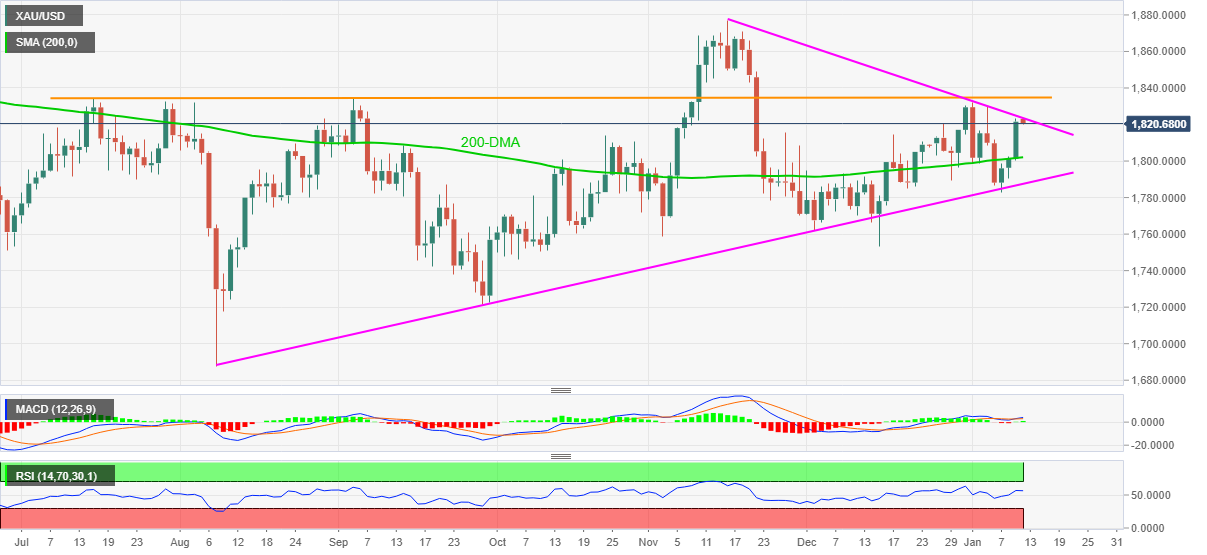
Trend: Further upside expected
- The Australian dollar grinds higher as the Asian Pacific session begins.
- AUD/JPY Technical Outlook: The downward move capped at the 200-DMA spurred the AUD surge above the 83.00 figure, so the pair is upward bias.
As the Asian Pacific session began and the New York session ended, the Australian dollar recovered some ground against the so-called safe-haven Japanese yen. At press time is trading at 83.19. US equity indices finished the Wall Street session in the green, recording gains between 0.51% and 1.47%, whereas Asian stock futures point to a higher open.
AUD/JPY Price Forecast: Technical outlook
On Tuesday, the cross-currency pair was subdued in the 83.50-90 range during the overnight session. But an improvement in the market mood late in the Asian session, early Europe, alongside a rebound from tech-stocks, spurred demand for risk-sensitive peers, benefitting the Antipodeans, alongside the CAD.
That said, the NZD/JPY broke the top of the trading range and reclaimed the 83.00 figure.
The NZD/JPY is bullish biased. The pair dipped to the 200-day moving average (DMA) but was rejected, rallying towards resistance above 83.00. The first resistance would be the January 10 daily high at 83.36. A clear break above it would expose a four-month-old downslope trendline drawn, from October 2021 highs, near the psychological 84.00 area.
Conversely, the immediate support would be 83.00. A breach of the latter could send the NZD/JPY tumbling to the 200-DMA at 82.65. Once the level gives way to JPY bulls, the next stop would be the confluence of the 100-DMA and the January 10 daily low around 82.33, followed by 82.00.
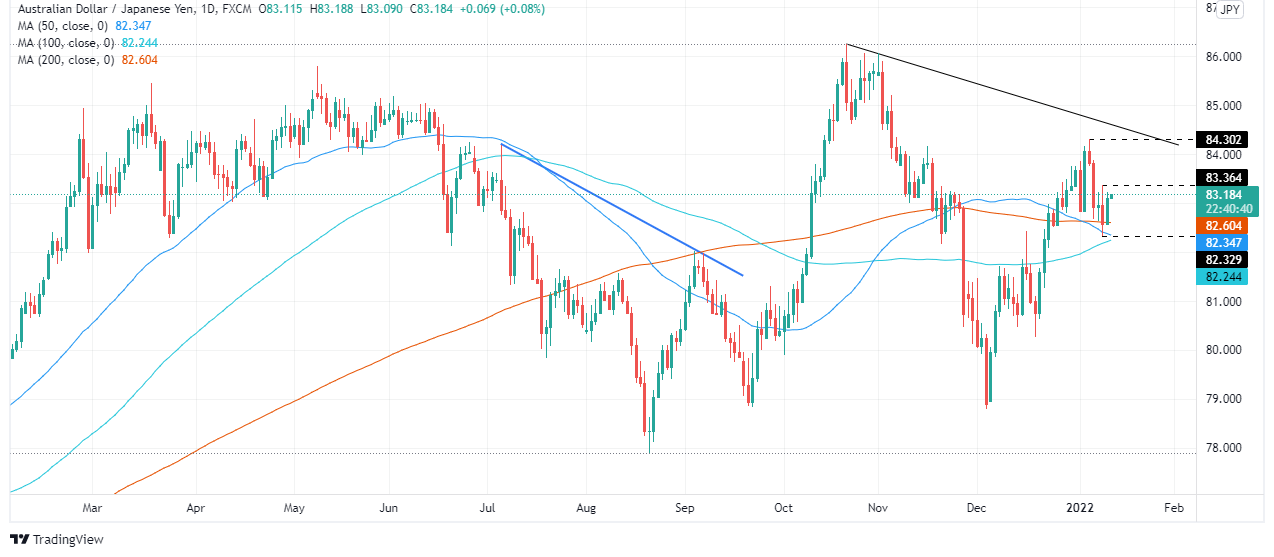
Morgan Stanley (MS) came out with hawkish expectations for the January monetary policy meeting of the Bank of Canada (BOC) while forecasting a surprise rate hike boosting the Canadian Dollar (CAD).
The investment bank highlights recently strong employment figures as the key factor behind the upbeat consensus. “The December employment report was very strong (headline employment, full-time vs. part-time jobs, and the regional breakdown indicated a robust labor market), which should contribute to a repricing in near-term rates and support CAD.”
On the same line is the Fed’s shift towards the tighter monetary policy as the MS said, “The Fed's ongoing shift towards a tighter policy stance should spill over to Canadian real yields - the 10y inflation-linked Canadian is at a post-COVID high. Higher real yields in Canada, in turn, should support CAD as oil prices continue to grind higher to our 3Q 22 $90bbl Brent oil forecast."
It’s worth noting the BOC’s first monetary policy meeting of 2022 is on January 26.
Read: USD/CAD Price Analysis: Bears to target 1.2480 on a breakout below daily H&S neckline
- GBP/USD bulls take a breather around multi-day top after rising the most in a fortnight.
- Clear break of the descending trend line from June joins bullish MACD signals to keep buyers hopeful.
- Overbought RSI tests further advances but 100-DMA adds to the immediate challenges for sellers.
GBP/USD seesaws near November highs after crossing the key resistance line to refresh multi-day peak the previous day. That said, the cable pair makes rounds to 1.3630-35 during the initial Asian session on Wednesday.
Although nearly overbought RSI challenges the pair buyers, a clear upside break of the seven-month-old resistance line, now support around 1.3595, hints at the pair’s further advances.
Even if the pullback move recalls the 1.3595, the 100-DMA level of 1.3550 and November 18 swing high near 1.3515 will challenge the GBP/USD sellers.
Should the quote drops below 1.3515, the 23.6% Fibonacci retracement (Fibo.) of June-December downside, near 1.3415, should return to the chart.
Alternatively, GBP/USD buyers are up for challenging the 50% Fibo. level surrounding the 1.3700 threshold. Though, the 200-DMA near 1.3740 will test the quote’s additional run-up.
Also acting as the upside filter is the 61.8% Fibonacci retracement level of 1.3835.
GBP/USD: Daily chart
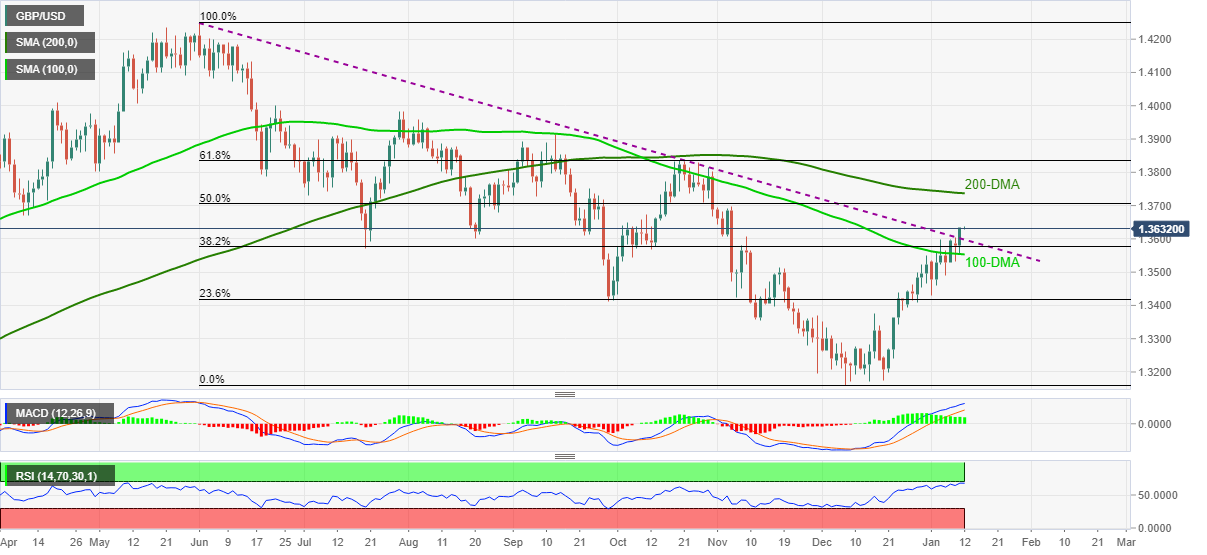
Trend: Further upside expected
- NZD/USD grinds higher around weekly top as the key day begins.
- Powell’s Testimony weighed down the USD due to cautious comments over supply crunch, balance sheet normalization.
- US Treasury yields drops for the second day, equities rose despite World Bank cut global growth forecasts for 2022.
- Inflation figures from China, US will be crucial for fresh impulse.
NZD/USD stays on the way to 0.6800, taking rounds to weekly top surrounding 0.6785 during early Wednesday morning in Asia.
The kiwi pair witnessed a notable buying pressure amid a broad US dollar weakness, as well as the market’s rush towards the riskier assets, following the comments of Fed Chair Jerome Powell during testimony before the Senate Banking Committee. In doing so, the NZD/USD prices ignored downbeat growth forecasts from the World Bank (WB). However, the cautious sentiment ahead of the key inflation figures from China and the US, for December, seems to probe the bulls of late.
Although Fed’s Powell showed readiness to hike interest rates to stop inflation from being entrenched, concerns over supply-demand mismatch and balance-sheet runoff weighed down the US dollar. The Fed Boss said that the balance sheet runoff could happen "perhaps later in the year," while also expecting that the supply crunch will ease somewhat and the economic impact of the Omicron variant will be short-lived.
That said, the US Dollar Index (DXY) dropped around 0.35% to poke December’s low around 95.60 by the end of Tuesday’s North American session.
Elsewhere, the World Bank cut the global growth forecast for 2022 from 4.3% previous forecasts to 4.1%. The Geneva-based institute also trimmed China’s 2022 GDP expectations to 5.1% versus 5.4% earlier consensus.
Talking about data, US NFIB Business Optimism Index rose past 98.4 to 98.9 for December while IBD/TIPP Economic Optimism for January eased to 44.7 versus 48.4 previous readouts.
Amid these plays, the Wall Street benchmarks cheered the second consecutive daily fall in the US 10-year Treasury yields.
Moving on, new Zealand’s ANZ Commodity Price Index for December may offer immediate direction, expected 3.4% versus 2.8% prior but major attention will be given to Consumer Price Index (CPI) for the said month from China and the US. Forecasts suggest China’s headline CPI ease from 2.3% to 1.8% YoY while the Producer Price Index (PPI) may witness ease from 12.9% to 11.1% for the said month, suggesting a pullback into the NZD/USD prices. However, anticipated strength in the US CPI for December, to 7.0% YoY versus 6.8% prior, will be a crucial number to watch as higher inflation can renew the US dollar buying and weigh on the Kiwi prices.
Read: US Inflation Preview: Dizzying heights of 7% would cement a March hike, supercharge the dollar
Technical analysis
NZD/USD battles a convergence of the 100 and 200-SMA around 0.6790-95, following a bounce off the monthly horizontal support near 0.6730 the previous day. Given the bullish MACD signals and firmer RSI, not overbought, the Kiwi pair is likely to cross the immediate hurdle to challenge a downward sloping resistance line from January 03, close to 0.6810. Should the NZD/USD bulls keep reins past 0.6810, then the prices will rise towards an area comprising multiple levels marked since September, around 0.6855-60.
Alternatively, a clear downside break of 0.6730 will highlight the 2021 bottom surrounding the 0.6700 threshold ahead of the 61.8% Fibonacci Expansion (FE) of the pair’s moves between November 15 and December 24, around 0.6650.
- The NZD/JPY climbs from weekly lows around 77.80s as market mood improves.
- NZD/JPY Technical Outlook: The pair is upward biased, but downside risks remain as the 200-DMA is near to the current spot price.
The NZD/JPY jumps from weekly lows on Tuesday as the New York session finishes. At the time of writing, the cross-currency is trading at 78.25. The market mood remains upbeat, as portrayed by US equities finishing in the green. Meanwhile, Asian stock futures point to a higher open, led by the Nikkei 225 and the Australian ASX/S&P, up some 0.81% and 0.86%, respectively.
NZD/JPY Price Forecast: Technical outlook
On Tuesday, the NZD/JPY pair dipped to 77.84 but gained traction immediately as the market mood improved. The NZD/JPY is mainly used as a pure market sentiment play. Any risk-off mood propels investors towards the security of the low-yielder Japanese yen, thus depreciating the NZD and risk-sensitive currencies.
So the pair bounced off weekly lows, reaching a daily high at 78.34, though it failed to gain traction, towards an attempt of the 1-hour 200-simple moving average (SMA), retreating to current price levels.
The NZD/JPY daily chart depicts an upward bias, as Tuesday’s price action broke above the 200-day moving average (DMA). However, the presence of the 50 and the 100-DMA above the spot price could exert downward pressure on the pair. To the upside, the first resistance would be the 50-DMA at 78.43. A decisive break of that level would expose the 100-DMA at 78.65, followed by a three-month-old downslope trendline around the 78.75-90 area.
Conversely, the first line of defense for NZD bulls would be the 200-DMA at 78.15. A crucial break would open the door for further downward pressure. The following support would be 78.00, followed by the January 10 pivot low at 77.58, and December 20, 2021, daily low at 76.02.

- AUD/USD has been moving in on the higher liquidity mid-week.
- Bears need a break below 0.7190 for downside prospects.
As per the start of the week's analysis, AUD/USD Price Analysis: Bears moving in, eyes for restest of H1 lows, the price is moving in on higher liquidity as follows:
Prior analysis, AUD/USD H4 chart
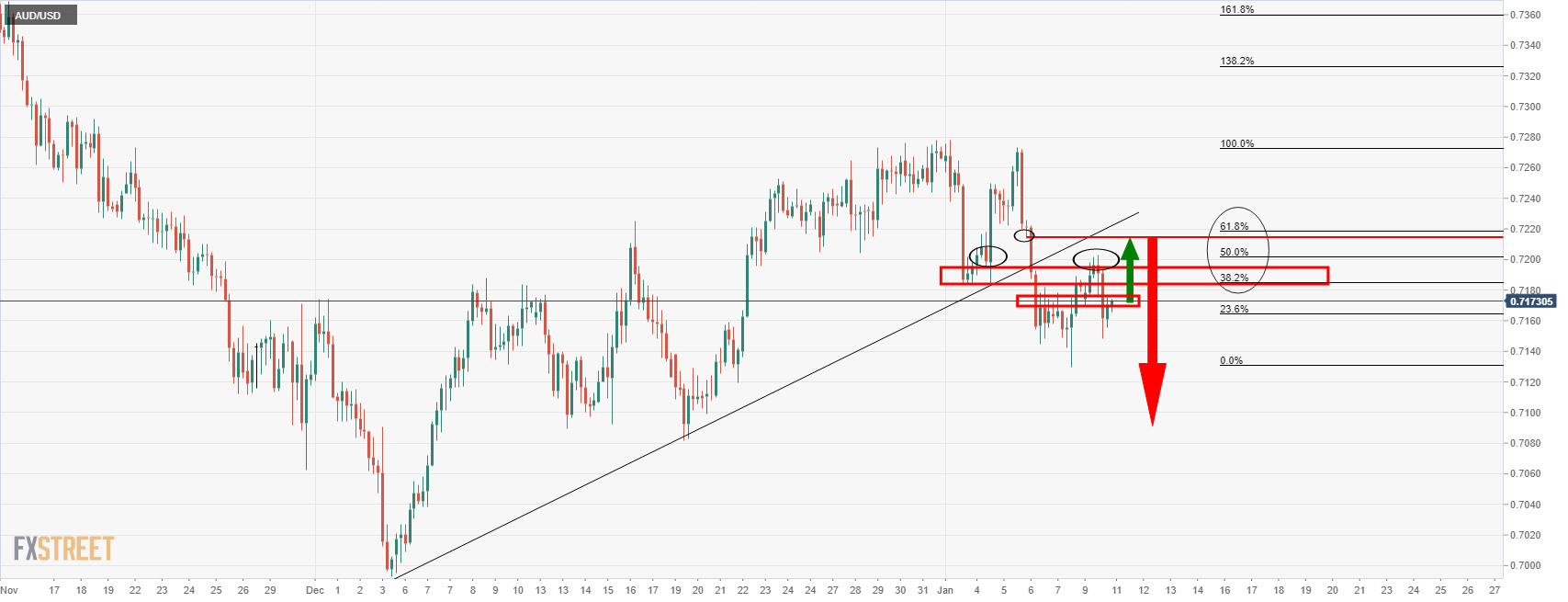
In the above chart from yesterday, the liquidity near the 61.8% ratio was identified and has been tested in price action today as follows:
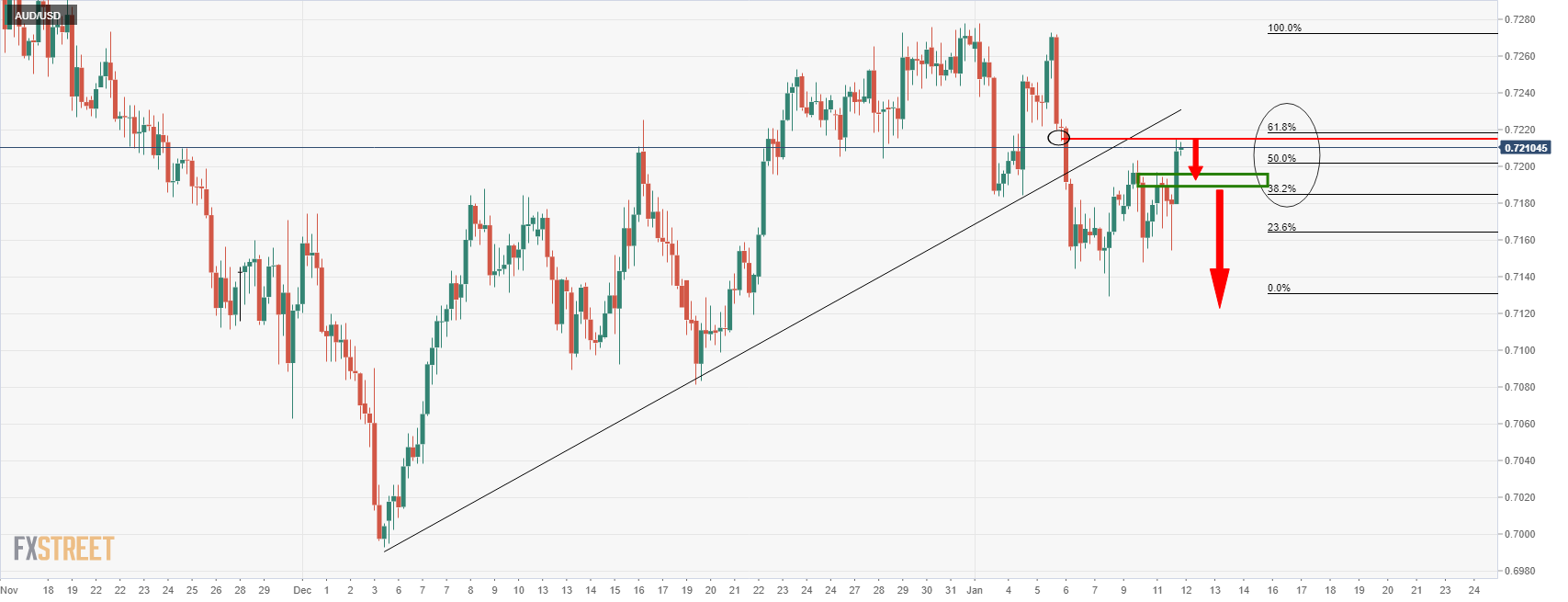
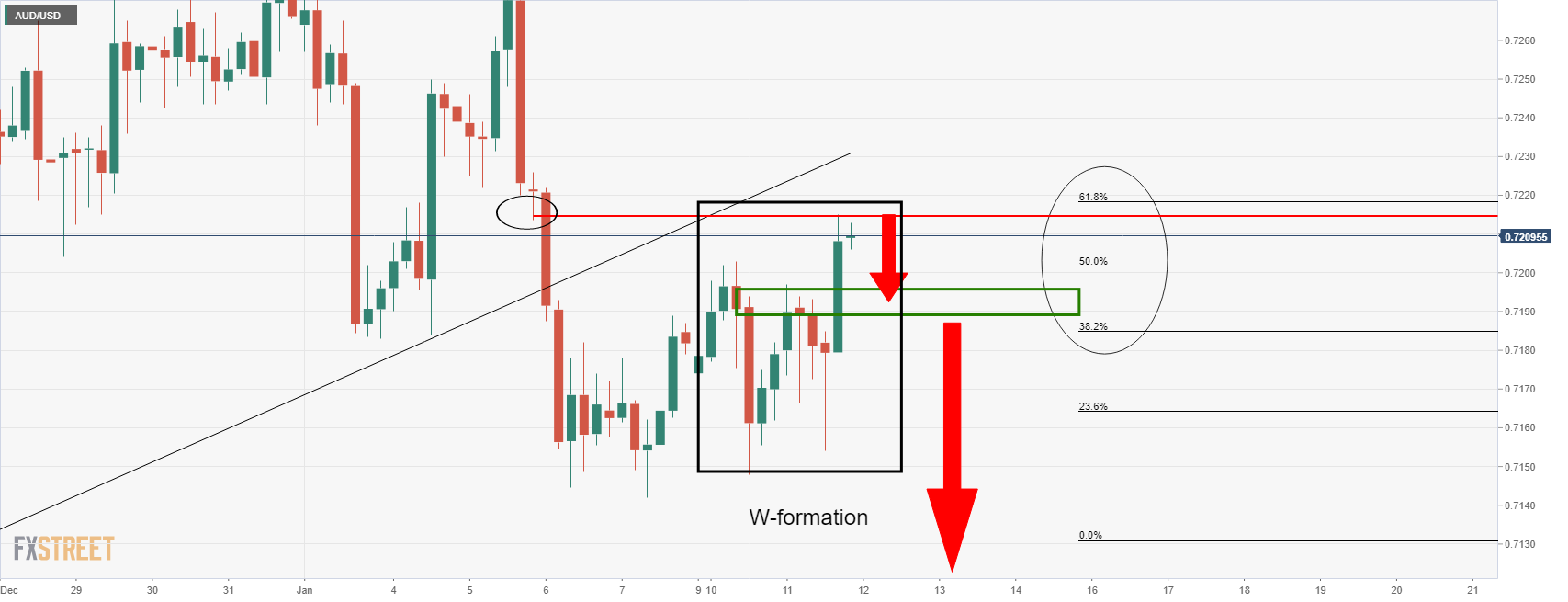
The W-formation might be expected to pull in the price to the neckline and if the bears take over there, then the downside will be to play for.
- The USD/CHF losses some 0.39% in the New York session.
- Tuesday’s retracement could be an opportunity for USD bulls if that is the case, as the DMAs remain below the spot price.
- USD/CHF Technical outlook: The pair is upward biased, as long as it remains above 0.9167,
On Tuesday, the USD/CHF trims some of its weekly gains, retreating from daily highs, as Fed Chief appeared at a hearing for his renomination as the head of the US central bank. At the time of writing, the USD/CHF is trading at 0.9236.
USD/CHF Price Forecast: Technical outlook
The USD/CHF fluctuated between gains and losses in the overnight session, dropping from weekly highs around 0.9270 to the 0.9230s region amid a weak demand of US dollars.
Nevertheless, the USD/CHF is upward biased, so the pullback on Tuesday’s trading session could be an opportunity for USD bulls to re-enter the market if that is the case, supported by the daily moving averages (DMAs), which although seesawing in the last trading days around the spot price, reside below of it.
To the upside, the USD/CHF’s first ceiling would be December 15, 2021, cycle high at 0.9294, close to the psychological 0.93 handle, and a tenth-month-old downslope trendline. The breach of that area would open the door towards the psychological 0.9400 figure, followed by April 1, 2021, daily high at 0.9475.
Conversely, if the USD weakens, the USD/CHF’s first support would be the 0.9200 figure. Once that floor is broken, the next stop for CHF bulls would be the confluence of a one-year-old upslope trendline and the 200-DMA at 0.9167, followed by December 31, 2021, pivot low at 0.9202.
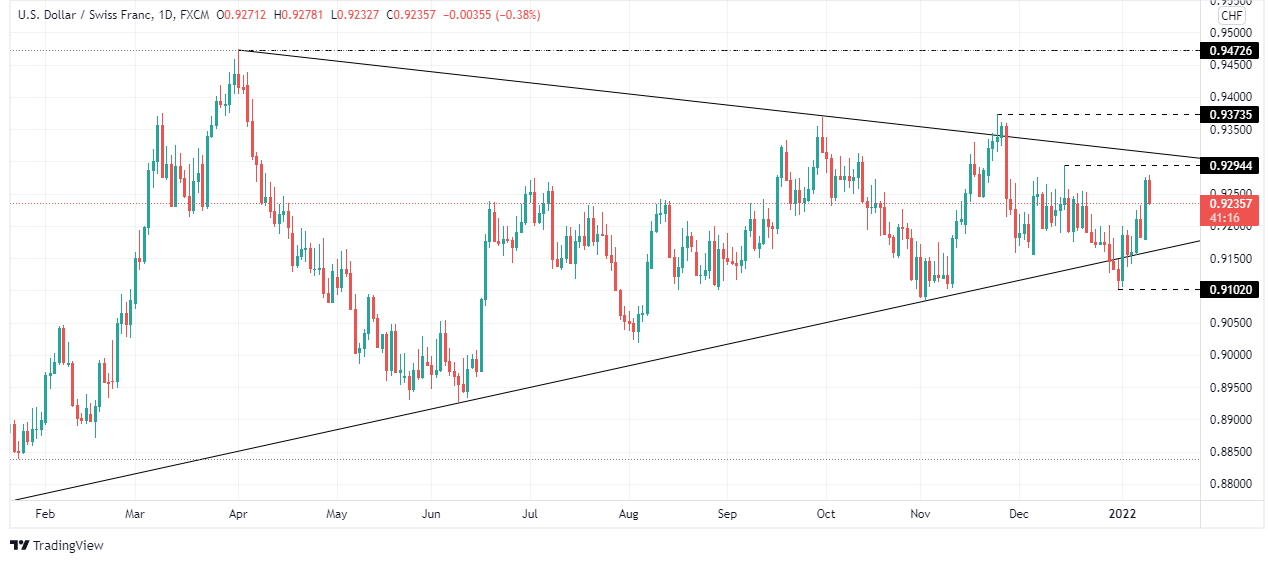
- EUR/JPY recovered back above 131.00 on Tuesday and is testing a key bullish trend channel that it broke below on Monday.
- The pair was supported as risk appetite improved after Powell refrained from offering further hawkish Fed surprises.
Strength in risk assets on Tuesday after Fed Chair Jerome Powell refrained from giving markets any further price in Fed tightening in 2022 weighed on the safe-haven yen and helped catapult EUR/JPY back above 131.00. Powell, who testified at a Senate hearing for his renomination as Fed Chair, stuck to the script and reiterated the main takeaways from last week’s hawkish Fed minutes. This was taken as a green light by US equity investors to continue buying the recent dip helped to also spur strength in commodities and US bonds. This prompted currency markets to adopt a distinctly risk-on posture, with risk-sensitive G10 currencies (NOK, SEK, CAD and AUD for example) to outperform whilst the US dollar and yen underperformed.
As a result, EUR/JPY has been able to recapture the lion’s share of Monday’s losses that sent it as low as the 130.10s and saw the pair close under 130.50. As noted, the pair has been able to rally all the way from Tuesday’s opening levels all the way under 130.50 to current levels above 131.00, a near-0.5% rally on the day. The pair is now retesting the upwards trend channel that it broke to the south of at the start of the week. Whilst EUR/JPY traders would do well to keep an eye on Eurozone November Industrial Production data out on Wednesday, Japanese Machine Orders on Thursday and December PPI numbers on Friday risk appetite will remain the main driver of the pair.
More specifically, with markets now expecting decisive policy tightening from the Fed in 2022 to the tune of four rate hikes and the start to quantitative tightening, the question is whether US equities can weather whats seems likely inevitably higher yields. US December Consumer Price Inflation and Retail Sales data, more Fedspeak from regional Federal Reserve Bank Presidents and a Fed Vice Chair nomination hearing for Fed’s Lael Brainard will all be worth watching as potential catalysts. If US data/Fed rhetoric this week suggests recent hawkish Fed bets have been on the excessive side, recent gains in US tech stocks and downside in yields may continue, which may support further upside for EUR/JPY. Bulls would be eyeing a retest of recent highs in the 131.50s area.
- GBP/JPY bulls seeking meanwhile restest of daily highs near 157.80.
- Bears keeping weekly targets in sight as per weekly W-formation.
Due to the latest price action, we are now back to needing to consider more upside from this pair before a move to the downside.
In Monday's analysis, GBP/JPY Price Analysis: Weekly W-formation remains in play, the price was starting to correct to the downside which was encouraging a bearish focus due to the W-formation on the weekly chart:
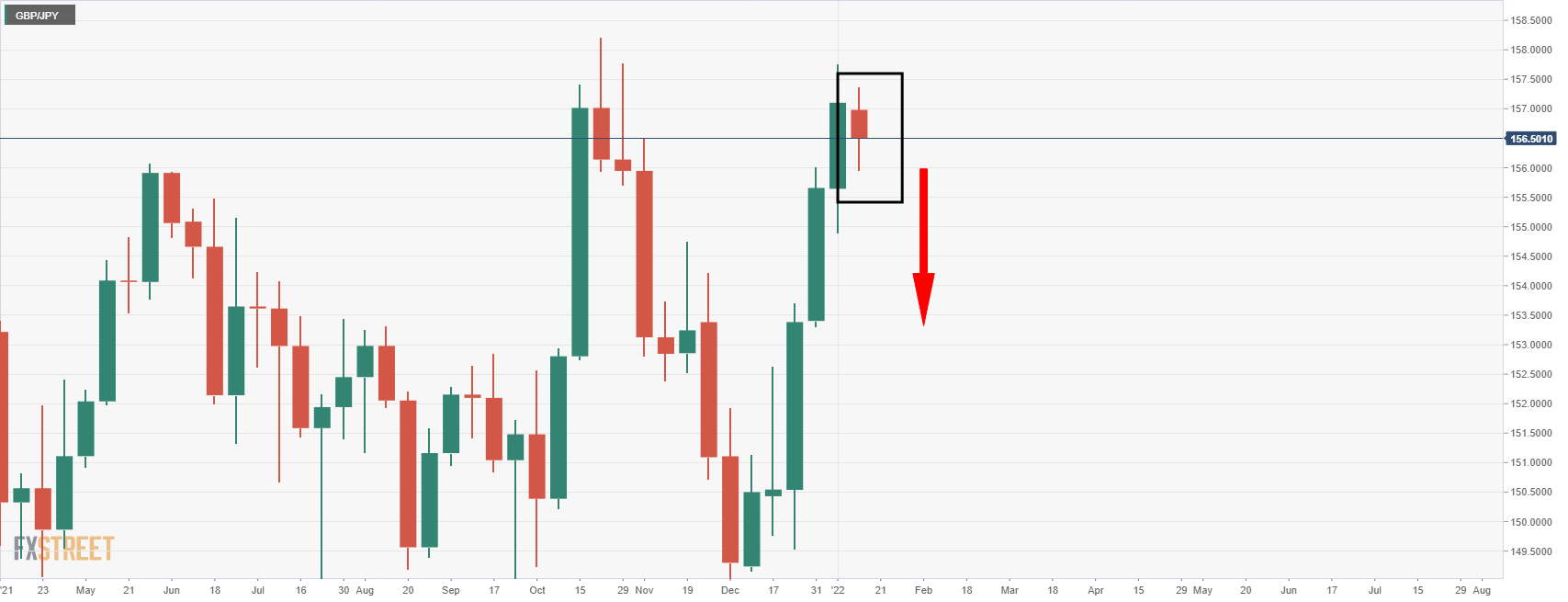
This led to an analysis of the lower time frames where a period of distribution was drawn up on the hourly chart as follows:
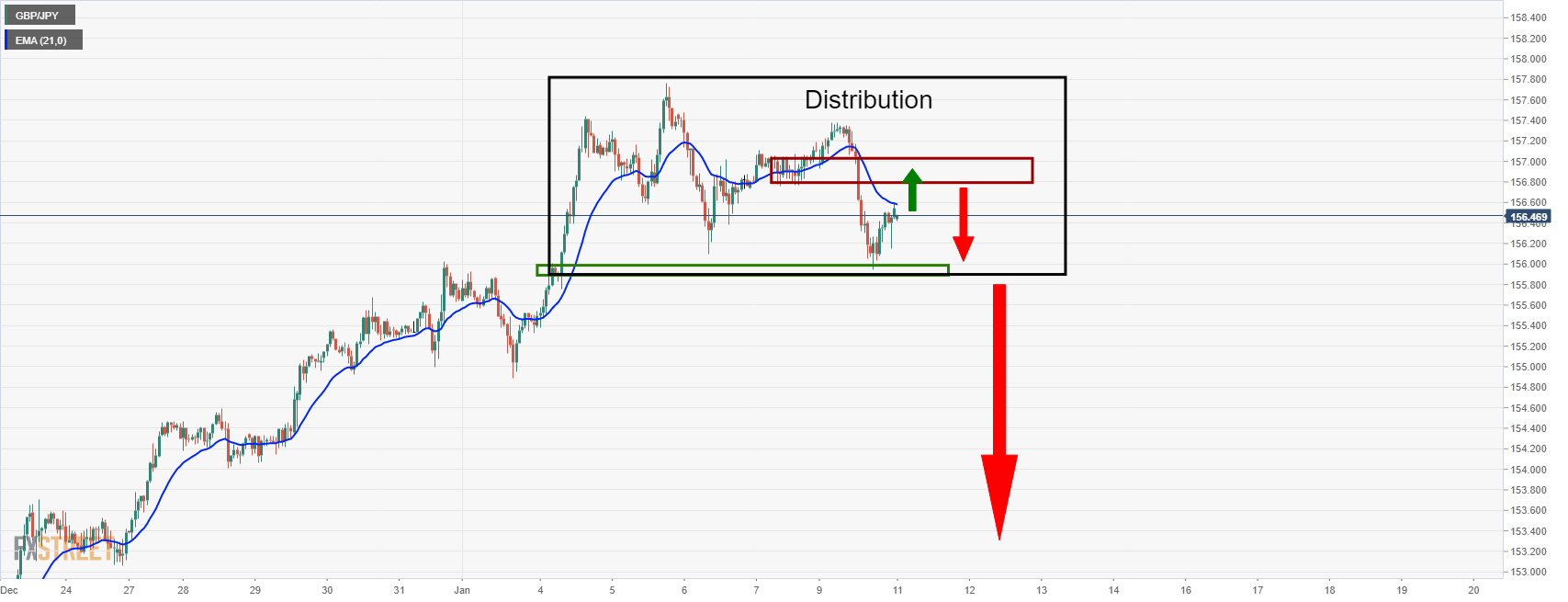
However, in subsequent trade, the price has broken the first layer of resistance in a much stronger correction than what might have been anticipated:
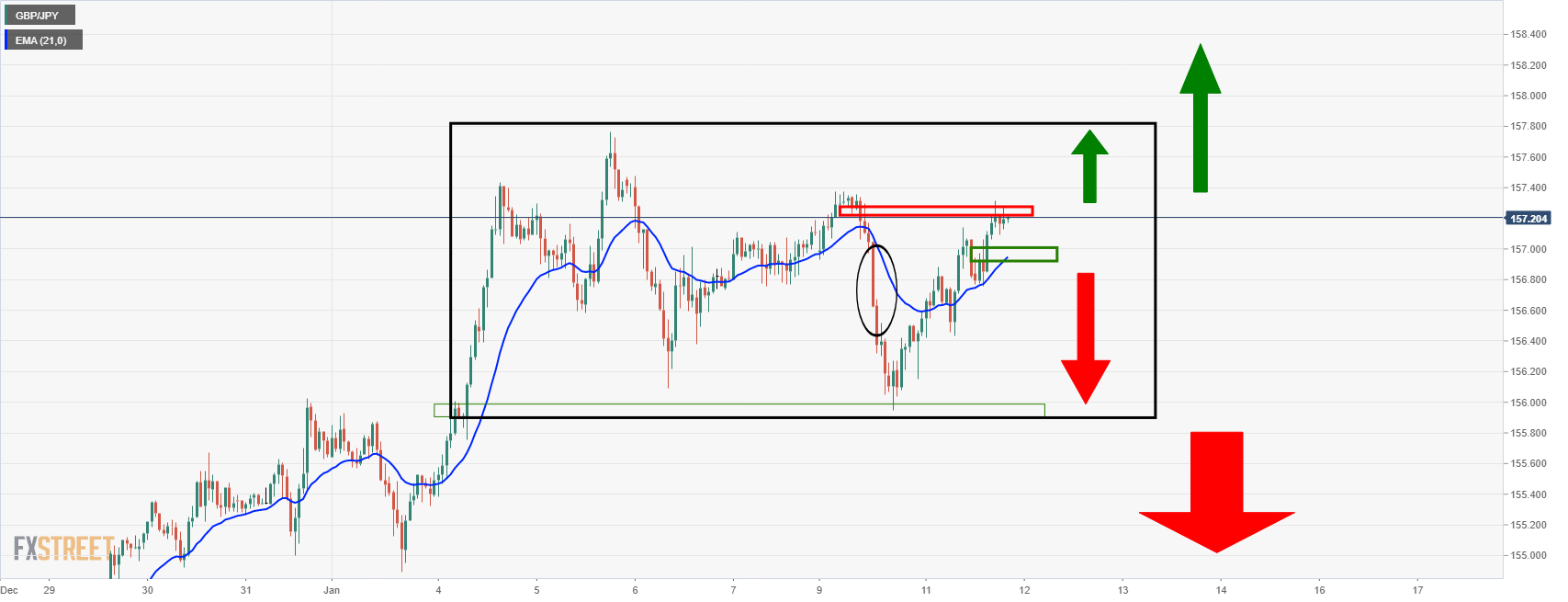
If this is a phase of distribution, then there could be a lot more sideways consolidation to play out yet. While the weekly chart's W-formation remains a compelling reversion pattern, should the bull's take charge beyond 157.40, then a last-ditch effort could see the price test the prior weekly highs of 158.22 first:
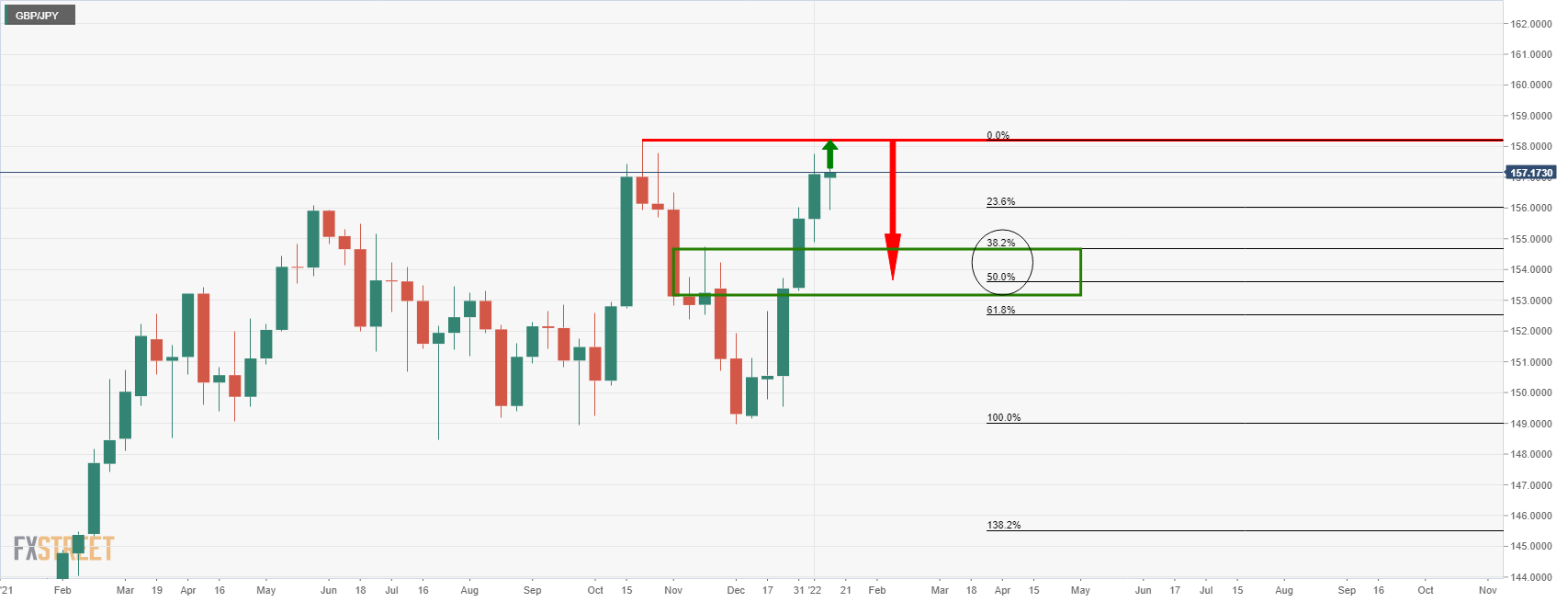
As illustrated, if the price were to move in on the prior highs prior to a run lower, then this would leave the 38.2% and 50% ratios aligned with the prior structure as targets.
There is also a daily W-formation now belong formed that is worth noting:
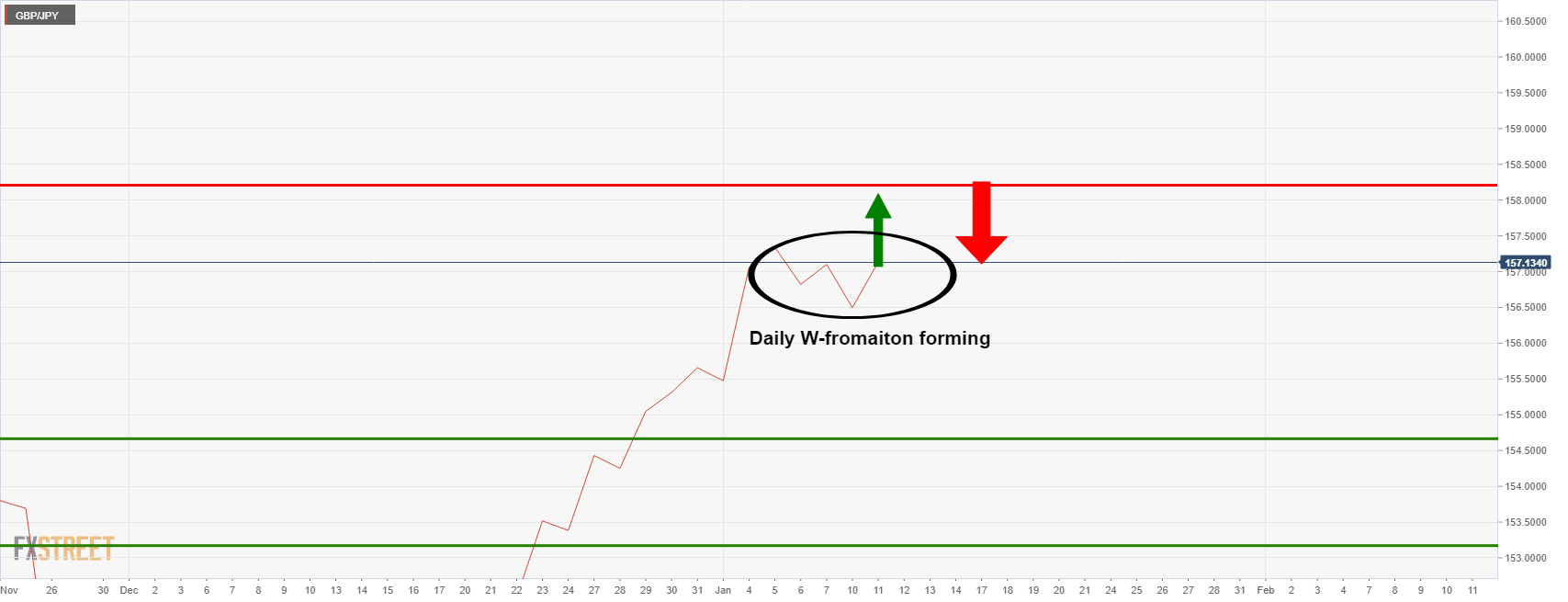
- The S&P 500 has reclaimed 4700 on Tuesday amid broad US equity market upside as tech recovers post-Powell remarks.
- That means the index has recovered more than 2.8% from Monday’s sub-4600 lows.
- The lack of any fresh hawkish surprises seemed to give the green light for a technical reversal of recent moves.
Having managed to convincingly clear its 21-day moving average to the upside, the S&P 500 continues to march higher as the end of Tuesday’s session draws closer and has recently crept back above the 4700 level. That means the index is trading with a gain of about 0.8% on the day and is up more than 2.8% versus Monday’s sub-4600 lows. The upside in US equities, which has been disproportionately concentrated in the recently heavily hit tech sector, was spurred in tandem with a reversal lower in US real and nominal bond yields after remarks from Fed Chair Jerome Powell. Speaking at a hearing with the Senate Banking Committee for his renomination as Fed Chair, Powell stuck to the script and reiterated the main takeaways from last week’s hawkish Fed minutes.
Traders were seemingly enthused by the lack of surprises/any fresh hawkish rhetoric to spur further hawkish Fed bets, hence the tech-led reversal higher in equities and lower in yields. Recall that long-term nominal and real yields had, prior to Tuesday, seen a massive rally since the start of 2021 that had hit long-term interest-sensitive equity sectors such as tech hard. On Monday, JP Morgan’s chief global markets strategist Marko Kolanovic had said that the recent pull-back in risk assets such as US tech was “arguably overdone” and that it presented investors with a buying opportunity. Market participants agreed on Monday, powering the Nasdaq 100 nearly 3.0% higher from intra-day lows under 15,200 to above the 15,600 mark, and the rebound has continued on Tuesday, with the index now above 15,800, up a further 1.3%.
Amid a surge in crude oil prices that has seen WTI rally more than $3.0 intraday to above $81.00 per barrel, the energy sector is up more than 3.0% on the day. Most other sectors in US equity markets are also trading in the green, even financials despite the pullback in US yields (10-year -3.5bps to under 1.75%). The only S&P 500 GICS sectors in the red on Tuesday are the more defensive ones; consumer staples (-0.5%), utilities (-1.0%) and real estate (-0.25%). Amid the broad positive performance across US equity sectors, the Dow is up slightly more than 0.5% on the day to the 36,250 area. Ahead, Fed speak will remain a prominent market driver this week, as will US data, most notable of which is Wednesday’s December Consumer Price Inflation report and Friday’s Retail Sales report. Friday also marks the unofficial start to earnings season with big US banks reporting Q4 results.
What you need to know on Tuesday, January 12:
The dollar fell sharply on Tuesday, following comments from US Federal Reserve chief Jerome Powell. In the hearings before the Senate amid his nomination for a second term, the leader of the US central bank mixed a hawkish view of the economy with a cautious approach to the reduction of the balance sheet.
Powell noted that the economy is growing at its fastest rate in years, while the labour market is "robust." Also, he said the Fed would stop higher inflation from getting entrenched, cooling down the market's concerns. At the same time, he said that the balance sheet runoff could happen "perhaps later in the year," cooling expectations for an aggressive tapering.
Meanwhile, US Fed Vice-Chair Richard Clarida stepped down on Monday after failing to report stocks' trading just a few days before the Fed announced emergency financial measures to shore up markets in the middle of the coronavirus pandemic. Fed vice-chair said his failure to report those trades was the result of "inadvertent errors."
Wall Street advanced on relief, with the three major indexes holding on to gains ahead of the close. US government bond yields eased as the yield on the 10-year Treasury note retreated to 1.75%.
The EUR/USD pair advanced to 1.1374, holding nearby as the day comes to an end, while GBP/USD trades at 1.3625, its highest since November.
Safe-haven currencies advanced modestly against the greenback, with USD/JPY now trading at 115.40. Commodity-linked currencies strengthened, with AUD/USD trading at 0.7210 and USD/CAD down to 1.2570.
Gold is up to $1,820 a troy ounce, while crude oil prices also got a boost from a weaker dollar, with WTI currently trading at $81.40 a barrel.
The focus now shifts to US inflation figures. The country will publish on Wednesday the December Consumer Price Index, foreseen at 7% YoY.
Top 3 Price Prediction Bitcoin, Ethereum, XRP: Majority of crypto market to experience relief rally
Like this article? Help us with some feedback by answering this survey:
- WTI bulls step in despite the risks of covid spreading like wildfire.
- Supply risk remains a key driver, all eyes on OPEC+ group's effective spare capacity.
Oil trades much higher early on Tuesday with West Texas Intermediate, WTI, up over 3.5%bbls at the time of writing after a rally from $78.39nnls that reached $81.56bbls. The rally comes despite the spread of the Covid-19 omicron variant and the return of supply from Libya.
Libya has begun to normalize after a militia group agreed to resume output at the country's largest oilfield while pipeline repairs were completed. However, there have been reports that the nation's biggest export terminals are shuttered due to poor weather conditions.
As for Omricon, the World Health Organization has warned that 50% of Europeans could be infected with Covid-19 over the next two months. China has also increased lockdown measures to lower cases ahead of next month's Winter Olympics. In the US, cases have climbed to a record. However, markets are preferring to stick with the sentiment that the variant results in more mild cases.
Elsewhere, and despite rising inventories today, the EIA boosted its price forecast for Brent crude, expecting it to average US$74.95 per barrel this year, up from its December estimate of US$70.60. WTI is forecast to average US$71.32 per barrel this year, an increase from the December estimate of US$67.87.
Nonetheless, ''supply risk remains a key driver with the OPEC+ group's effective spare capacity effectively concentrated between just a few nations, as operational risks mount following a decade of underinvestment,'' analysts at TD Securities argued.
''In the meantime, while the Omicron variant's higher transmissibility has correlated with mobility restrictions, resilient driving mobility and factory activity are providing an offset for energy demand. In this context, energy supply risks continue to rise despite the OPEC+ group's decision to raise output,'' the analysts added.
''US production is still recovering at a slow clip, with capital expenditure budgets for the new year still suggesting that capacity will also remain capped. With that said, the bar is extremely low for CTA trend followers to add to their longs across the complex.''
- The NZD rises in tandem with risk-sensitive peers like the AUD and the GBP, the US dollar weakened.
- Fed’s Chief Powell: “If we have to raise interest rates more over time, we will.”
- NZD/USD is neutral-bearish biased, as the pair faces the confluence of the 50, 100, and 200 SMAs in the 4-hour chart.
The New Zealand dollar surges slightly 0.53% in the North American session, as the US central bank head, Jerome Powell, testifies against the US Senate Banking Committee on his renomination bid. At the time of writing, the NZD/USD is trading at 0.6790.
The market sentiment improved since the beginning of Chair Powell’s hearing, with US equity indices gaining between 0.15% and 1.01%. In the meantime, the US dollar shed its weekly gains, down 0.28%, sitting at 95.718.
In the bond market, US Treasuries fall, with the 10-year T-bond note fall to 1.768%, a headwind for the greenback.
Summary of Jerome Powell remarks
Federal Reserve Chief Jerome Powell said earlier at his appearance at the US Senate Banking Committee that the US central bank would use its tools to get inflation to the bank’s target. Powell said that “If we have to raise interest rates more over time, we will.” Further, he said that the US economy no longer needs to be accommodative and that the central bank should focus more on inflation than on the maximum employment goal.
An absent New Zealand economic docket left the NZD/USD pair leaning on US Fed speaking and market sentiment dynamics.
Atlanta’s Fed President Raphael Bostic said he penciled three hikes on December’s meeting on Tuesday. Furthermore, coincided with his colleagues, Cleveland and Kansas City presidents Loretta Mester and Esther George, respectively, that the balance sheet should be reduced sooner than later.
NZD/USD Price Forecast: Technical outlook
The NZD/USD pair is neutral-downward biased. The 4-hour simple moving averages (SMAs) with a bearish slope, confluence around the 0.6790-95 area, a strong resistance level would be difficult to overcome for NZD bulls.
In the event of breaking above the area mentioned above, NZD bulls would challenge the 0.6800 figure, which once broken would expose the January 5 daily high at 0.6837, followed by 50-DMA at 0.6872.
On the flip side, the NZD/USD pair’s first line of defense would be the 0.6700 figure. A break under that figure exerts downward pressure on the pair. The following support would be October 2020 cycle lows around 0.6553.
- Silver has rallied alongside other asset classes recently hit by Fed hawkishness after Powell’s remarks didn’t offer any surprises.
- XAG/USD has rallied to the $22.75 area, clearing its 21DMA and key short-term resistance in the $22.60s.
The fact that Fed Chair Jerome Powell didn’t add any further fuel to the fire regarding the market’s recent hawkish repricing of Fed policy expectations seems to have been taken as a green light for some reversal of recent moves. Powell’s remarks were very much in line with the contents of last week’s minutes from the December 2021 meeting, with Powell endorsing the need for the Fed to lift interest rates and begin the process of quantitative tightening in 2022. In response to his remarks made before the Senate Banking Committee at his renomination hearing, US equity markets are enjoying a tech/growth-stock led rally, US yields are falling and the US dollar has been coming under pressure.
Given their negative correlation to the buck and real yields, the net result for precious metals markets has been positive, with spot silver (XAG/USD) prices currently up more than 1.0% on the day. Spot prices had been struggling to get back above their 21-day moving average at $22.60 in the run-up to Powell’s testimony but have since broken higher to the $22.75 area. In doing so, spot silver has also managed to clear key resistance in the $22.60s in the form of recent lows from the beginning of last week and the week prior.
Some strategists had been warnings that the recent moves observed in US real yields had been overdone and Tuesday’s retracement is overdue. To recap, US 10-year TIPS yields nearly hit -0.70% on Monday, up from -1.1% at the start of the year. On Tuesday, it has pulled back to under -0.80%, with an even larger move lower being seen on the day in 5-year TIPS yields. Lower real yields lowers the opportunity cost of holding non-yielding precious metals, hence the negative correlation. But taking a longer-term view, it does seem likely that as the Fed unwinds stimulus via rate hikes and quantitative easing throughout the duration of the year, risks are tilted to the upside. That could mean that traders continue to view XAG/USD as a sell on rallies.
That would especially be the case if the US dollar, which has weakened in wake of Powell’s remarks likely as a result of position adjustment, starts strengthening broadly. Speculators have built up heavily long-dollar positions in recent weeks, so some further dollar downside as some of the weaker hands are flushed out may see dollar downside continue. But any dollar/real yields weakness fuelled rally back towards recent highs in the $23.50 area may be viewed as an attractive short-entry by the longer-term silver bears.
- EUR/USD bulls step in as markets think twice about a long dollar.
- An overcrowded trade in the greenback is vulnerable and cracks are forming.
EUR/USD is firm on the day and higher by some 0.35% at the time of writing. The greenback is suffering a phase of disinterest in what might be an overcrowded trade as investors tread cautiously on the Fed's uber hawkish path.
At the time of writing, EUR/USD is trading at 1.1365 and has moved higher within the 1.1312 and 1.1368 range thus far on the day. Attention has been on the pace for which the Fed intends to taper and the timings of the first and subsequent rate hikes.
''Since the start of November, the Fed has not only announced a plan to taper the pace of its QE programme, but it has subsequently upped the pace to allow a potentially earlier start to rate rises. In addition, it has introduced the likelihood of forthcoming balance sheet reduction,'' analysts at Rabobank explained.
We have seen plenty of demand for the greenback because of this and US yields shoot higher. However, despite more of the same from the Fed this year, with very hawkish minutes, the greenback has not been able to capitalise much on it. The greenback is down around 0.9% as per the DXY for 2022 so far. The DXY is an index that measures the US dollar vs a basket of major rival currencies, the largest of which is the euro making up over 57% of the components of the index.
''Insofar as there is already a lot of hawkish news in the price, the USD may need to see some pullback and fresh news on the interest rate front before finding direction, '' the analysts at Rabobank said.
Earlier today, Federal Reserve's chairman, Jerome Powell, had been testifying to The Senate., Powell said the Fed would stop higher inflation from getting entrenched and this has tamed the rates markets, sending the US 10-year yield a touch lower from 1.7830% to 1.7370% on the day so far on the day, further dampening demand for the greenback.
Then, taking into account covid, the greenback was regarded as a safe bet in this regard. However, given that the Omricon variant is not expected to cause as much damage to global growth, the US dollar could also lose out on this front. The US dollar had otherwise been expected to benefit from safe-haven flows away from risk.
The analysts at Rabobank explained that, for G10 markets, ''the prospects of economic recovery and faster economic growth could allow for some currency strength and re-direct some flows away from the greenback during the course of the year.''
''Given that there is currently a lot of good news in the price, we expect that the USD may continue to struggle to find its feet in the near-term.,'' the analysts added.
''During the latter part of this year, expectations regarding rate hikes in other G10 central banks and the possibility that CPI inflation in the US will start moving back towards the Fed’s target could sap the outlook for the USD. We expect EUR/USD to start edging higher in H2 and through 2023.''
- USD/CAD bears are taking on the 1.26 area with a fresh cycle low at 1.2588.
- The longer-term outlook will be significantly bearish should the price break 1.2580 on a daily closing basis.
USD/CAD has been steadily carving out a bearish head and shoulders pattern on the daily time frame for the start of 2022, as per the following original analysis: USD/CAD Price Analysis: Bears line up for their discounts
Tracking the performance of the pair at the start of this week, the following analysis noted the M-formation: USD/CAD Price Analysis: The bearish playbook is unfolding, daily M-formation in focus
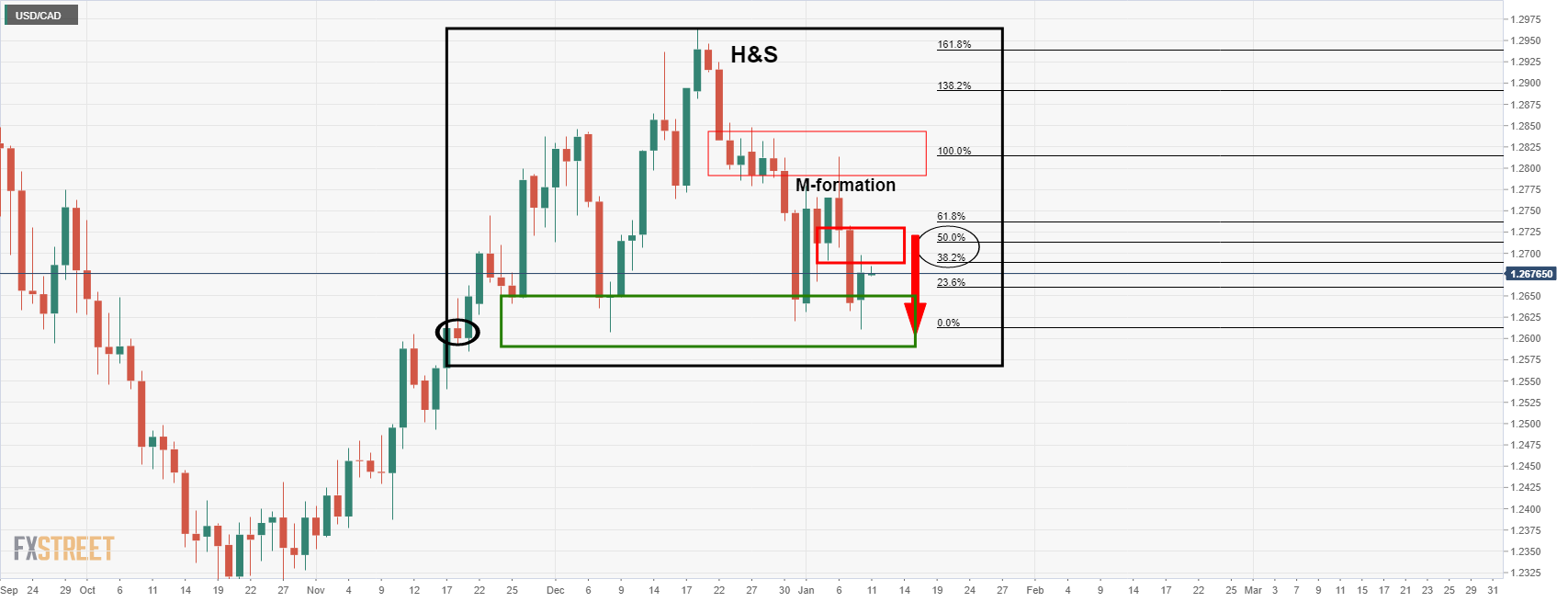
The price was leaving an M-formation on the chart as illustrated above and was drawing the bulls into the neckline.
This was seen on the 4-hour time frame as in the following prior analysis:

Since the analysis, the price has indeed played out according to the 4-hour forecast as follows:
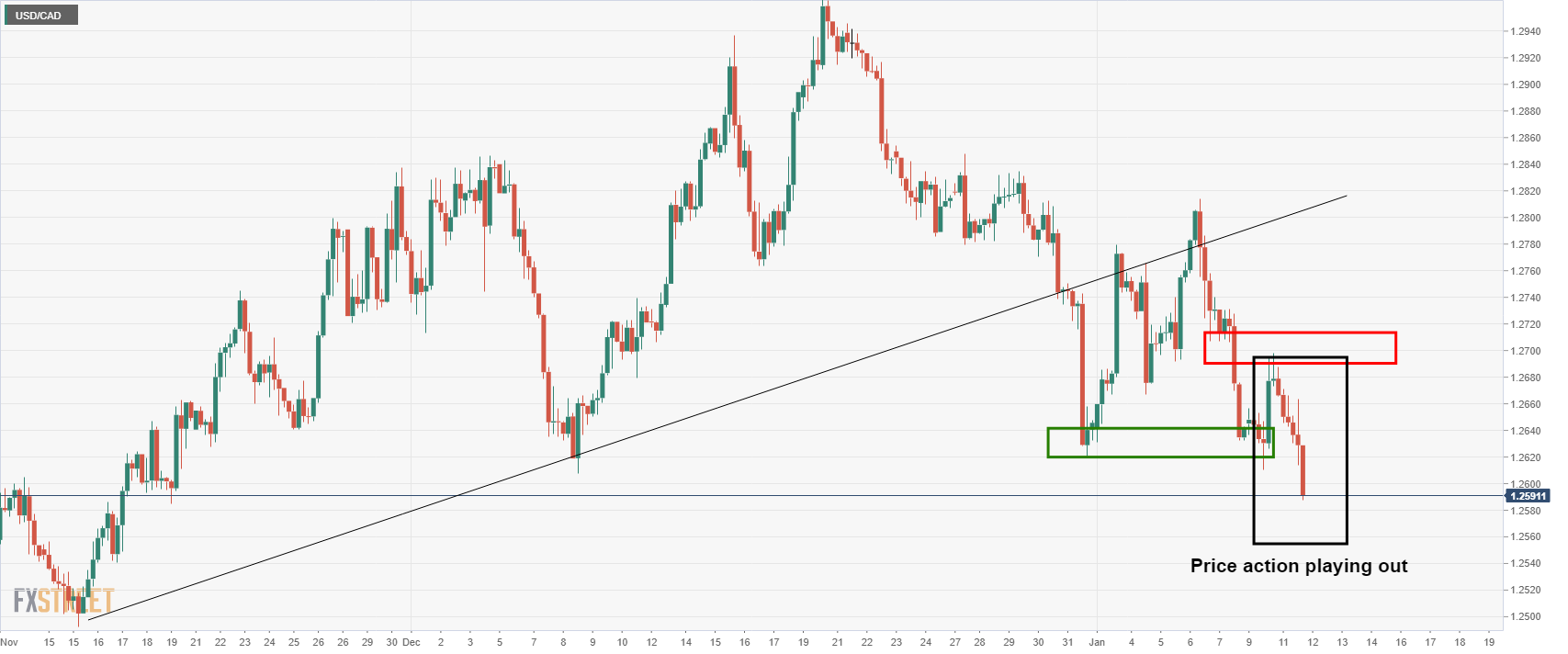
The price mitigated the imbalance into the daily M-formation's neckline near 1.2700/10 prior to the recent break to test 1.26 the figure.
At this juncture, the neckline of the daily head and shoulders would be expected to act as resistance near 1.2580/1.2610. Bears can look near to 1.25 the figure and 1.2480 as the next area of expected support:
USD/CAD daily chart
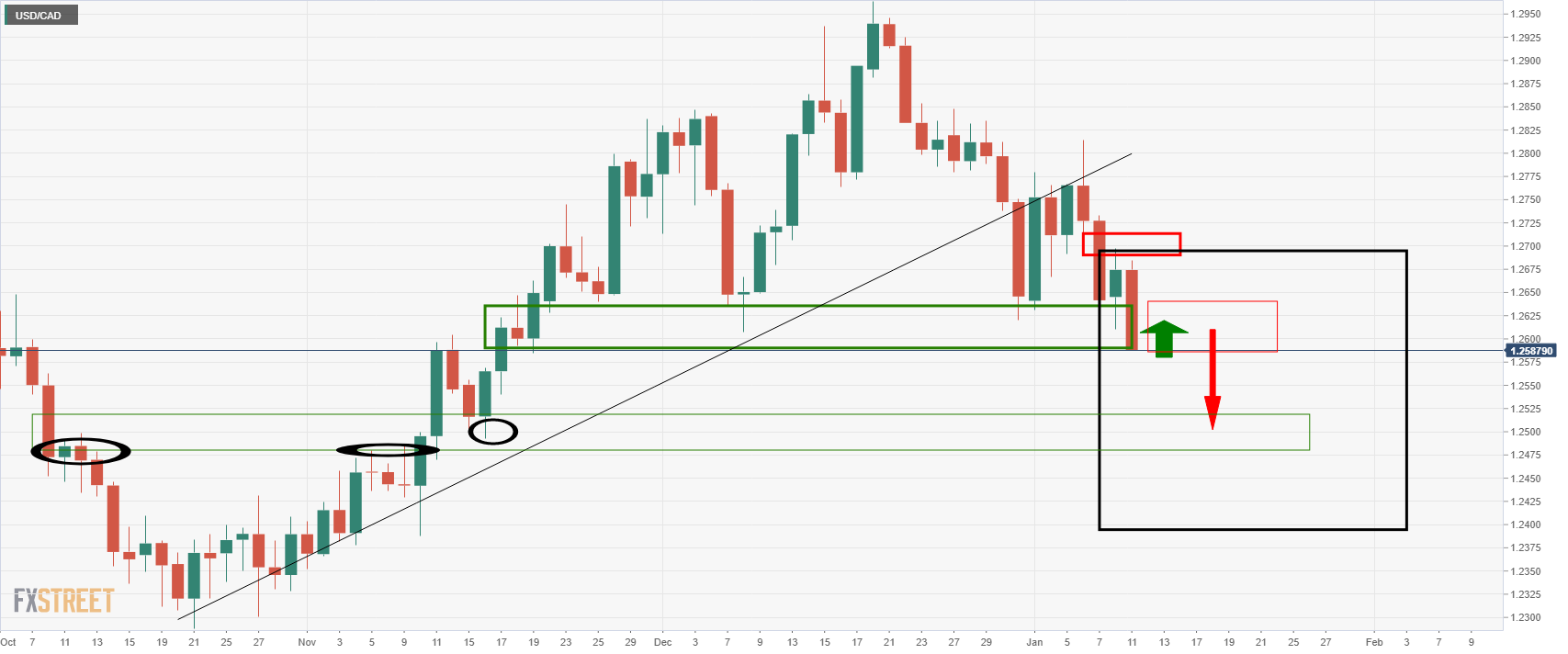
- AUD/USD is at session highs above its 21DMA and probing the 0.7200 area as the dollar weakens post-Powell comments.
- Powell’s remarks did not surprise market participants and the dollar seems to be suffering amid profit-taking.
AUD/USD has seen upside in recent trade and recently hit session highs a whisker below the 0.7200 level as the dollar suffers broad weakness in wake of remarks from Fed chair Jerome Powell. Powell’s remarks, made at his renomination hearing before the Senate Banking Committee, were broadly in line with the hawkish tone of the Fed minutes released last week, with Powell referencing plans to lift rates and begin balance sheet reduction in 2022. The lack of surprises seems to have triggered relief in US equities, with tech and rate-sensitive growth stocks the best performers, as well as triggering some profit taking on long dollar positions. Indeed, the market is heavily long USD versus most G10 currencies, including the Aussie - last week’s CFTC data (released every week) showed that speculator’s net short position in AUD/USD was close to a 52-week high.
Returning back to AUD/USD price action; the pair now trades higher on the day by about 0.4%, making it one of the better performing G10 currencies alongside with some its risk-sensitive peers including NZD and CAD. Strength in copper (+1.1%), gold (+0.7%), oil (+3.3%) and other commodity prices on Tuesday is helping AUD and its other commodity-sensitive peers, whilst the Aussie is also getting an independent boost from Tuesday’s strong retail sales report. The presence of the 21-day moving average in the 0.7190s is currently offering resistance, as has been the case over the past three sessions and a break above this area plus the 0.7200 mark could open the door to a prolonged move back towards recent highs in the 0.7275 area. Should the dollar continue to fail to benefit from hawkish Fed vibes and strong/hawkish US data this week, that could provoke further profit-taking and exacerbate recent upside.
- The British pound continues rallying for the third day in a row.
- A mixed-market mood and an absent UK economic docket were not an excuse for GBP bulls to push the pair higher, courtesy of a weaker US dollar.
- GBP/USD is upward biased, though a daily close above 1.3600 would cement the pair’s chances to reach 1.3700.
During the New York session, the GBP/USD climbs above the psychological 1.3600 figure, trading at 1.3618 at the time of writing. The market sentiment shifted from a risk-on mood to mixed as the Federal Reserve Chairman Jerome Powell testifies against the US Senate Banking Committee on his re-nomination to head the US central bank.
Federal Reserve policymakers agree on a balance sheet reduction
An absent UK economic docket that would be packed on Friday left the GBP/USD pair at the mercy of US dollar developments.
Before Wal Street opened, three Federal Reserve regional presidents crossed the wires. Atlanta’s Fed President Bostic said that he “penciled three hikes on the December meeting,” but as of today, he foresees that one more could be needed. Concerning reducing the balance sheet as soon as possible, he coincides with Cleveland’s and Kansas City Fed Presidents Loretta Mester and Esther George.
Jerome Powell, Federal Reserve president, is crossing the wires at press time. So far, he said that the Fed would use their tools to get inflation towards the central bank target and emphasize that the US economy no longer needs accommodation. Powell further noted that the US central bank needs to focus more on inflation than the maximum employment goal
Follow Jerome Powell's remarks in FXStreet’s live coverage here.
GBP/USD Price Forecast: Technical outlook
The GBP/USD is neutral-upward biased, despite trading below the 200-day moving average (DMA,) which sits at 1.3736, well above the spot price. At press time, it is trading above 1.3600, a level that was last seen on November 11, 2021, a signal that opens the door for a test of the 1.3700 figure, though there would be some hurdles on the way up.
The first resistance would be the R2 daily pivot at 1.3644. A breach of the latter would expose November 4, 2021, daily high at 1.3699, followed by the 200-DMA.
On Friday, the US retail sales report for December will be released. Analyst at Wells Fargo expected a rise of just 0.2%, which would be the slowest pace in four months.
Key Quotes:
“Consumers are feeling the pressure from inflation. Retail sales came in well-below expectations in November, rising just 0.3% over the month. Higher prices for necessities, such as food and gas, have forced hard choices in more discretionary categories, such as electronics & appliances and department stores during the holiday shopping season. However, we suspect at least some consumers' holiday shopping was pulled forward, heeding advice from well-publicized supply chain issues and aggressive messaging from retailers.”
“We expect spending to moderate further in December and forecast retail sales to rise 0.2% over the month, which would be the slowest pace in four months. It is important to note that sales are reported in nominal dollars, which means they are not adjusted for inflation. If price gains outpace spending increases, that implies a volume decline in sales.”
“On top of higher prices, the Omicron variant presents some downside risk to spending in December as well, particularly in the service sector.”
Fed Chair Jerome Powell, speaking at the Senate hearing for his renomination, said on Tuesday that the Fed is trying to get to a place where interest rates are more neutral for the economy and then to a place where they are "tight".
Additional Remarks:
"We haven't made any decisions regarding balance sheet reduction."
"We will talk again about it at the January meeting."
"Economy is in a completely different place to last tightening cycle."
"Reducing balance sheet this time will be 'sooner and faster'."
"We will reduce the balance sheet sooner and faster than last time."
"Balance sheet is far above where it needs to be."
"We will take two to four meetings to work through the balance sheet decision."
"We tend to take 2, 3, 4 meetings to make such decisions."
Market Reaction
Perhaps motivated by a lack of fresh surprises from Fed Chair Powell in his remarks over the course of the last hour, the US dollar has been weakening in recent trade, whilst risk assets such as the Nasdaq 100 that had recently been hit by fears over Fed hawkishness are gaining. The Nasdaq 100 index is now up 0.8% on the session, erasing early session losses.
After a poor performance of the South Korean won during 2021, analysts at MUFG Bank consider it looks now undervalue. They expect the USD/KRW pair to decline to 1145 by the fourth quarter of the current year.
Key Quotes:
“KRW depreciated 9.4% against the US dollar in 2021, the second worst performing currency among emerging Asia currencies last year. KRW’s sizeable depreciation was due to the worsened pandemic condition in the country. The Bank of Korea (BoK) raised the 7-day repo rate twice in 2021, with a 25bps hike to 0.75% on August 26th and another 25bps hike to 1.0% on November 25th.”
“In 2022, the engines for Korea’s growth will be better performance of the service sector, stronger private consumption as COVID conditions improve and continued fiscal stimulus. However, tighter financial conditions (50bps policy rate hike) due to its CB’s desire in managing financial risks amid indebted households, and lower exports growth will constrain South Korea’s pace of expansion.”
“The KRW is undervalued now in both effective exchange rate terms and bilateral terms against USD. With the pandemic becoming more controllable in 2022, a steadily economic recovery and better controlled pandemic condition in South Korea would help build confidence and a
Analysts at Rabobank consider the US dollar has the capacity to move EUR/USD to the 1.10 area this year, they are projecting this on a 6 month view based on the expectation that the Federal Reserve’s tightening cycle will be underway by then. Later they see the EUR/USD rebounding.
Key Quotes:
“The June FOMC was instrumental to the turnaround in USD sentiment last year since the movements in the dot plot at this meeting stimulated the debate about the prospects of a Fed rate rise in 2022. Even though Fed-related news this year has retained a hawkish tone, the USD is struggled to find its feet. Insofar as there is already a lot of hawkish news in the price, the USD may need to see some pullback and fresh news on the interest rate front before finding direction.”
“While we expect that the USD has the capacity to move towards the EUR/USD1.10 area this year, we are projecting this on a 6 month view based on the expectation that the Fed’s tightening cycle will be underway by then. Given that there is currently a lot of good news in the price, we expect that the USD may continue to struggle to find its feet in the near-term.”
“During the latter part of this year, expectations regarding rate hikes in other G10 central banks and the possibility that CPI inflation in the US will start moving back towards the Fed’s target could sap the outlook for the USD. We expect EUR/USD to start edging higher in H2 and through 2023.”
Fed Chair Jerome Powell, speaking at the Senate hearing for his renomination, reiterated on Tuesday that he expects the economy to be able to deal with the current and future Covid-19 outbreaks.
Additional Remarks:
"There may be lower hiring and pause in growth due to Omicron but should be short-lived."
"The next quarters could be very positive for the economy after Omicron has subsided."
"We are seeing an economy that functions during Covid waves."
"Risks on both sides on growth and potentially on inflation."
Fed Chair Jerome Powell, speaking at the Senate hearing for his renomination, said on Tuesday that inflationary pressures are set to remain elevated well into 2022.
Additional Remarks:
"If it does, our policy will continue to adapt."
"If inflation lasts longer, that would require a policy response."
"If inflation will last longer that would imply more risk of becoming entrenched, our policy will respond."
"This year I expect fed will raise interest rates, end asset purchases and perhaps later this year beginning to allow the balance sheet to shrink."
"We have to be humble and nimble."
"The Fed has not made any decisions on timing for any of normalization process."
"Will have to be open to changing environment, monetary policy will have to adapt."
"Monetary policy will have to adapt as we learn more about inflation."
Analysts at MUFG Bank point out that the weakens of the Japanese yen is reaching its limits. They forecast USD/JPY at 117.00 by the end of the first quarter and at 116.00 by the end of the second.
Key Quotes:
“The yen depreciated by 10.3% versus the US dollar in 2021, the worst performance amongst G10 currencies. Strong risk appetite resulting in impressive performances for global equity markets coupled with rising US yields helped fuel the gains. We see scope for this momentum to continue in the early part of this year. US yields look set to advance further and overall G10 central bank policy support will help keep financial market conditions favourable, especially if as expected Omicron continues to recede as a global risk. The breach of the key technical resistance around the 117.00 level (long-term trendline from 1990 and 2015 highs) could see a lurch higher and a move toward the key 120.00 level. If this scenario was to unfold, we believe it would mark the final phase of this move higher in USD/JPY.”
“As we approach the timing of the first rate increase in the US, the market is likely to be well priced (or overpriced) for Fed action and from that point we would see scope for a start of a reversal.”
“In BoJ REER (Real Effective Exchange Rate) terms, the yen has just broken below the 2015 low to reach levels last recorded way back in 1972. With greater financial market volatility this year, coupled with Japan’s large current account surplus and a relatively attractive real yield, we believe the depreciation of the yen will soon hit its limit.
Inflation data will be released on Wednesday in the US. Analysts at Nordea Markets, see the December core inflation reading to print in line with consensus at 5.4%, which is the highest number since 1991. They point out unresolved supply restrictions are still the reason behind the inflationary pressure.
Key Quotes:
“Contributions originate from the usual suspects – used vehicles and rent of shelter. Our models suggest that inflation in owner’s equivalent rent of shelter (OER) was above 4% in December, implying a contribution >1.2% to core inflation. 2021 has surely been the year of surging prices on used cars, a peculiar contributor to the broad index. We expect used car prices to accelerate with more than 2.5% from November, leading to y/y inflation above 35%.”
“Minutes from the December meeting revealed that the bottlenecks in supply chains and labor markets are more rigid than firstly anticipated by Fed officials, doubtlessly leading to an even higher inflation reading in December. However, Fed officials argue that bottlenecks are likely to ease soon which leads us to believe that inflation peaks in either the current or next print. The combination of reversed base effects, a larger supply, and weakening of foreign demand for American goods will lead to a downward pressure on prices, eventually easing inflation.”
“Our prospects of high readings tomorrow have us believe in a strong USD and a further increase in the long-dated Treasury yields. We still expect Fed’s lift-off to occur in March, three months early compared to most forecasters. Prepare accordingly.”
Fed Chair Jerome Powell, speaking at the Senate hearing for his renomination, said on Tuesday that the Fed at the moment needs to focus more on the inflation side of its mandate versus the employment side given that inflation is further from the Fed's target than employment.
Additional Remarks:
"This year we will in all likelihood normalize policy, including raising rates this year and may start balance sheet runoff later this year."
"Supply-side constraints have been very persistent, not seeing much progress on that."
"We have to achieve price stability, confident we will."
"We have to achieve price stability; am confident we will."
"This year will in all likelihood normalize policy."
"At some point perhaps later this year will allow balance sheet to shrink."
- Falling US Treasury yields weigh on the US Dollar, boost the non-yielding metal.
- On Tuesday, a Fed speakers parade is crossing the wires.
- Federal Reserve Chief Powell appears at the Senate to speak about its renomination.
The yellow metal extends its rally, edges higher for the third consecutive day, while US Treasury yields, particularly the 10-year benchmark note rate, fall for the first day in three, sitting at 1.778%. At the time of writing, the gold spot (XAU/USD) advances 0.04%, is trading at $1,808 during the North American session.
The market sentiment is upbeat, as portrayed by US equity futures pointing towards a higher open. Despite the previous-mentioned, investors’ eyes would turn to Fed’s Chief Jerome Powell testify against the Senate Banking Committee to speak about its nomination. However, he would sustain a Q&A session with the US Senators, so beware of the speed of the lifting and balance sheet chatters.
Some of Powell’s remarks prepared for his appearance, he pledged to “prevent higher inflation from becoming entrenched.”
In the meantime, the US Dollar Index, which measures the greenback’s performance against a basket of six peers, slides some 0.03%, sits at 95.96, a tailwind for the non-yielding metal, which usually appreciates when the US Dollar weakens.
Meanwhile, on Monday, some US commercial banks led by Goldman Sachs noted that the Federal Reserve would hike four times in the year, beginning with the March 2022 monetary policy meeting.
Fed speakers parade begins
Earlier in the day, Atlanta’s Fed President Raphael Bostic said that he expects three rate hikes in 2022, with risks of an additional hike. He also noted that “the balance sheet should decline faster than in the last tightening cycle, perhaps by $100 billion.“
In the same tone of rate hikes, Cleveland’s Fed President Loretta Mester said that if the economy performs the same as today in March, she will support a rate hike in that meeting. Further noted that she “penciled in three rate hikes for 2022 at the December meeting” and would like a faster reduction of the balance sheet than in the previous cycle.
Following Mester, Kansas City Fed President Esther George said that it would be appropriate for the Fed to move earlier on running down its balance sheet compared to its last tightening cycle.
XAU/USD Price Forecast: Technical outlook
Gold has a neutral bias, as shown by the daily moving averages (DMAs) residing in the $1,792-$1,805 range, trendless and has been like that in the last three trading days.
To the upside, gold’s first resistance would be the January 6 daily high at $1,811.54. A breach of the latter would expose the January 3 daily high at 1832, followed by November 16, 2021, pivot high at $1,877.
On the flip side, the first line of defense for XAU bulls will be the psychological $1800. A decisive break of that level would expose the 100-DMA at $1,793, followed by the January 7 daily low at $1,783, and then December 15, 2021, cycle low at $1,753.
- Mexican peso remains strong versus US dollar, holds onto recent gains.
- USD/MXN keeps testing the 20.30/35 support area.
- Resistance emerges at 20.60, horizontal level and the 20-SMA.
The USD/MXN continues to be unable to recover ground. Recent runs higher were followed by a retracement back to the 20.35 zone. A stronger Mexican peso continues to push the price toward the 20.30/35 support. A break lower would clear the way to more losses, targeting 20.15. Below attention would turn to 20.00.
On the upside, the immediate resistance emerges at 20.50 and then comes a more significant barrier at 20.60. A daily close above would expose the next one at 20.85. A daily close above 20.90 would be a positive sign for the dollar.
Technical indicators are slightly biased to the downside, but most of them are now flat. The 55-day simple moving average is turning to the upside, and the 200-SMA awaits flat at 20.28.
USD/MXN daily chart
-637775120672703948.png)
Fed Chair Jerome Powell, speaking at the Senate hearing for his renomination, said on Tuesday that the US labour market is recovering "incredibly" rapidly and the US economy no longer needs highly accommodative policy.
Additional Remarks:
"Wages moving up is generally a good thing."
"We are watching wages carefully."
"The unemployment rate is doing very well."
"The economy no longer needs highly accommodative policy."
"Inflation so far above target is telling us the economy no longer needs our highly accommodative policy."
"This year will be moving policy closer to normal."
"It is really time for us to move away from emergency settings."
"Doing so should not have a negative impact on the labor market."
"We can't directly affect supply-side conditions."
Fed Chair Jerome Powell, speaking at the Senate hearing for his renomination, reiterated on Tuesday that the Fed will use its tools to get inflation back down.
Additional Remarks:
"We now have a mismatch between demand and supply."
"If we see inflation persisting longer than expected, then we will have to raise interest rates more over time."
"We will use our tools to get inflation back down."
"We want to promote a long expansion and for that, we need price stability."
"High inflation is a threat to that goal."
"We probably remain in an era of very low interest rates."
FOMC Chairman Jerome Powell will testify before the US Senate Committee on Banking, Housing, and Urban Affairs for his confirmation hearing on Tuesday, January 11, at 1500 GMT.
Related articles
Federal Reserve Jerome Powell testifies Tuesday, prepared remarks out.
Fed Chair Powell to offer hints about QT and lift-off timing – TDS.
About Jerome Powell (via Federalreserve.gov)
Jerome H. Powell took office as Chairman of the Board of Governors of the Federal Reserve System on February 5, 2018, for a four-year term. Mr. Powell also serves as Chairman of the Federal Open Market Committee, the System's principal monetary policymaking body. Mr. Powell has served as a member of the Board of Governors since taking office on May 25, 2012, to fill an unexpired term. He was reappointed to the Board and sworn in on June 16, 2014, for a term ending January 31, 2028.
- USD/TRY remains capped by the 14.00 hurdle.
- Turkey 10y yields edges higher to the 23.70% region.
- Turkey’s Current Account recorded a $2.68B deficit.
The Turkish lira gives away part of the recent gains and pushes USD/TRY back to the proximity of 13.90 on Tuesday.
USD/TRY: Upside still limited around 14.00
Trading range in USD/TRY has diminished considerably in the last sessions, while occasional bullish attempts in the spot remain well limited around the 14.00 neighbourhood for the time being.
The ongoing range bound theme in the lira comes in tandem with the persistent march higher in yields of the key Turkey’s 10y bond, which navigate record highs around 23.70%.
In the domestic calendar, Turkey’s Current Account slipped back into a $2.68B deficit in November. In addition, the Construction Cost Index rose by 48.87% YoY also in November and 7.94% vs. the previous month.
What to look for around TRY
The ongoing recovery in the pair seems to have met an initial tough resistance in the 14.00 area so far. The higher-than-expected inflation figures released at the beginning of the year put the lira under extra pressure in combination with some cracks in the confidence among Turks regarding the government’s recently announced plan to promote the de-dollarization of the economy. In the meantime, the reluctance of the CBRT to change the (collision?) course and the omnipresent political pressure to favour lower interest rates in the current context of rampant inflation and (very) negative real interest rates are forecast to keep the domestic currency under intense pressure for the time being.
Key events in Turkey this week: Current Account (Tuesday) - Industrial Production (Thursday).
Eminent issues on the back boiler: Progress (or lack of it) of the government’s new scheme oriented to support the lira. Constant government pressure on the CBRT vs. bank’s credibility/independence. Bouts of geopolitical concerns. Much-needed structural reforms. Growth outlook vs. progress of the coronavirus pandemic. Potential assistance from the IMF in case another currency crisis re-emerges. Earlier Presidential/Parliamentary elections?
USD/TRY key levels
So far, the pair is gaining 0.49% at 13.8429 and a drop below 12.7523 (weekly low Jan.3) would pave the way for a test of 12.1247 (55-day SMA) and finally 10.2027 (monthly low Dec.23). On the other hand, the next up barrier lines up at 13.9319 (YTD high Jan.10) followed by 18.2582 (all-time high Dec.20) and then 19.0000 (round level).
- WTI has pulled back from session highs above $80.00 as US equities come under selling pressure at the open.
- But oil may continue to fair better than equities, which are suffering from Fed hawkishness, if the demand outlook remains strong.
Amid US equities coming under some selling pressure at the Tuesday equity open, front-month WTI futures have pulled back from earlier session highs to the north of the $80 per barrel level and are now trading back in the $79.00 area. That still leaves WTI prices up more than 50 cents on the day and the oil bulls will still be eyeing a test of last week’s highs in the $80.50 area. Indeed, oil strategists continue to view the spread of the Omicron variant as not likely to leave a meaningful dent in near-term oil demand.
Meanwhile, despite the recent hawkish shift in market expectations for Fed tightening that has weighed on US and global equities, with four hikes now seen in 2022 coupled with quantitative tightening, the outlook for global growth in 2022 remains strong. This is what matters most for demand rather than financial condition-focused crude oil markets. The implication might be that, in the coming weeks/months, as long as Fed tightening isn’t seen as a “policy mistake” (i.e. that slows the economy unnecessarily), oil may remain a relatively safe risk asset even if Fed tightening expectations continue to weigh on equities.
OPEC supply woes remain in the headline and could also be offering some support to the price action. Libya has faced further setbacks in its efforts to bring production back to 2021 peak output levels of roughly 1.3M barrel per day (BDP). The country’s National Oil Corporation (NOC) said on Tuesday that it would be suspending oil exports from its Es Sider terminal due to bad weather and lack of storage. As a result, it's Waha Oil Co. (which exports oil through the Es Sider terminal) would be reducing production by 50K BPD and this could rise to as much as as 105K BPD. Despite this, the NOC said that output was back to 896K BPD from the 729K BPD reported last week.
Ahead, private US oil inventory data is scheduled for release at 2130GMT ahead of Wednesday official EIA US inventory report which is seen showing a seventh consecutive week of draws, with a further 2M barrel drop in stocks expected.
Federal Reserve Bank of Kansas City President Ester George said on Tuesday that it would be appropriate for the Fed to move earlier on running down its balance sheet when compared to the last tightening cycle, according to Reuters. George continued that her own preference would be to run down the balance sheet sooner rather than later.
The current very accommodative monetary policy stance of the Fed is "out of sync" with the economic outlook, she added, saying that the strength of economic fundamentals will continue to support solid consumption growth. On the impact of the surge in Omicron infections, George said that the surge is likely to weigh on the labour force participation rate and further delay the rotation in spending from goods to services. However, economic activity, she said, especially when it comes to spending, had become more resilient to spikes in Covid-19 infection rates and that the labour market looks tight.
Federal Reserve Bank of Cleveland President Loretta Mester said in an interview on Bloomberg Television on Tuesday that as long as the economy looks the way it does now in March, she would support a rate hike at that meeting.
Additional Remarks:
"The conomy is on a really good track and inflation is more persistent."
"Price increases have broadened."
"The case is really strong to begin to wind back accommodation."
"Penciled in three rate hikes for 2022 at the December meeting."
"Fed will have to see how the economy does over time before it knows how many rate increases are needed."
"Fed probably needs to recalibrate its policy stance because inflation is above where the Fed needs it to be."
"The Fed cannot ignore short run or medium term tightness in the labor market."
"The Fed should be able to run down the balance sheet much faster than it did last time."
"The economy is stronger now and the balance sheet is much larger."
"She would like to set a path for the balance sheet, which will reduce accommodation."
"It's really important the Fed take actions to bring inflation down given the environment."
- EUR/USD alternates gains with losses in the low-1.1300s.
- A break above the 4m resistance line exposes further recovery.
EUR/USD struggles for direction in the 1.1320/30 band on turnaround Tuesday.
If the pair manages to regain strength it should face the initial target at the 55-day SMA at 1.1364 ahead of the YTD high at 1.1386. Further up comes the 4m resistance line near the 1.1400 yardstick. The surpass of the latter should mitigate the downside pressure in the short-term horizon.
The broader negative outlook for EUR/USD is seen unchanged while below the key 200-day SMA at 1.1737.
EUR/USD daily chart
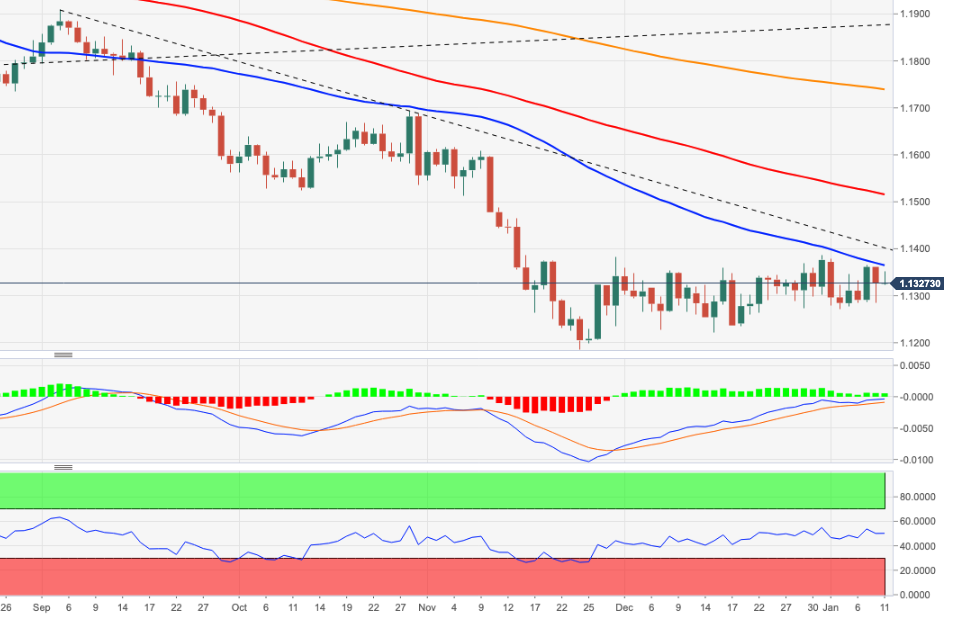
- A combination of factors assisted USD/JPY to regain positive traction on Tuesday.
- A positive risk tone undermined the safe-haven JPY and extended some support.
- Fed rate hike bets acted as a tailwind for the USD and also provided a modest lift.
The USD/JPY pair built on its steady intraday positive move and climbed to a fresh daily high, around the 115.65 region during the early North American session.
Having defended the key 115.00 psychological mark, the USD/JPY pair caught some fresh bids on Tuesday and has now reversed the previous day's losses to a one-week low. This marked the first day of a positive move in five sessions and was sponsored by a combination of supporting factors.
A generally positive tone around the equity markets undermined the safe-haven Japanese yen and acted as a tailwind for the USD/JPY pair. On the other hand, the prospects for a faster policy tightening by the Fed extended some support to the US dollar, which provided an additional lift to the pair.
It is worth mentioning that the money markets have fully priced in the possibility of an eventual Fed lift-off in March. The market bets were reinforced by comments from Atlanta Federal Reserve President Raphael Bostic, saying that March would be a reasonable time for the first-rate increase.
Bostic added that the runoff of the balance sheet could begin soon after and expects three rate hikes in 2022, with risks pointing towards a fourth on the possibility of higher inflation. Hence, the focus will remain on Fed Chair Jerome Powell's confirmation hearing before the Senate Banking Committee.
Investors will closely scrutinize Powell's remarks for clues about the likely timing and the pace of policy normalisation. Apart from this, Wednesday's release of the US consumer inflation figures will play a key role in influencing the USD and provide a fresh directional impetus to the USD/JPY pair.
Meanwhile, the fundamental backdrop seems tilted in favour of bullish traders and suggests that the recent corrective slide from a five-year high touched last week has run its course. Hence, some follow-through strength, towards reclaiming the 116.00 mark, remains a distinct possibility.
Technical levels to watch
- EUR/GBP hit multi-year lows for a second consecutive session under 0.8330 but has since rebounded back towards 0.8350.
- Analysts caution that there are a lot of positive in the price of GBP.
EUR/GBP hit multi-year lows for a second day running on Tuesday, briefly slipping below Monday’s 0.8332 low to bottom out at 0.8323 before rebounding in recent trade back towards 0.8350. At current levels in the 0.8340s, the pair trades flat on the day. ECB speak from President Christine Lagarde and Chief Economist Philip Lane was ignored on Tuesday as neither provided any more information on the policy outlook, enabling EUR/GBP traders to continue to focus on the overarching theme of ECB/BoE divergence. On which note, markets are pricing a strong likelihood that the latter will hike rates by 25bps in February thus further extending the UK’s rate advantage over the Eurozone, a theme which continues to weigh on the pair, FX strategists say.
Analysts at Commerzbank warn that while the prospect of interest rate hikes from the BoE has been supporting GBP, “quite a bit of it is likely to be priced in already so that the GBP rally could begin to run out of steam”. Analysts at Rabobank caution that the market, which has been expecting as many as four BoE rate hikes this year, may soo start to unwind some of the hawkish expectations, with pressure on real incomes in the UK likely to “become more obvious as the winter progresses”. For now, EUR/GBP bearish speculators will likely continue to target a test of late-2019/early 2020 lows in the 0.8280s area. The main data points to keep an eye on include Eurozone November Industrial Production figures on Wednesday and UK November GDP figures on Friday.
According to Robert Carnell – Regional Head of Research (Asia-Pacific) at ING – the development of a new Covid wave threatens both growth and India's sovereign ratings.
Key Quotes:
“The key metric for any downgrade is very simple - India’s fiscal position. Like most economies during the pandemic, India’s fiscal deficit worsened considerably as tax revenues slumped and government spending shot up to offset the crashing economy.”
“There are a variety of risks to the fiscal outlook. The 2021/22 budget outlook assumes a 14.4% nominal growth rate. Implicit within this is a real GDP growth rate that will not substantially dip below 10% assuming inflation runs somewhere around the middle of the RBI’s 4% +/- 2% target.”
“Rising debt-service costs are another risk given the global backdrop of tightening policies in the US and elsewhere. Revenues will also need to come in as predicted, and expenditures should not creep above budgeted amounts – slippage on fiscal targets is not uncommon in even the most prudent economy.”
“Monthly deficit figures are running at about -$20bn currently. Both export and import growth is good, and the recent decline in crude oil prices was certainly helpful. But the ongoing recovery will likely shift the balance of trade more in favour of imports, and we forecast the trade deficit further increasing in both $bn terms and as a percentage of nominal GDP.”
“The outlook for growth is tentatively positive but is maybe not as solid as some directional indicators suggest and may well be severely tested again by the Omicron Covid variant. And this is also where the biggest threat from a credit downgrade most likely lurks.”
Fed policymaker Richard Clarida announced on Monday that he would resign from his post as Vice Chairman of the FOMC on Friday, two weeks before his term on the central bank's board of governors had originally been scheduled to end. His announcement of early resignation follows a recent increase in public scrutiny over transactions he made in late February 2020, just as global equity markets had begun to crash as the Covid-19 pandemic embroiled the globe.
An initial public disclosure that first caught public attention last year showed Clarida had sold shares in three stock funds on 24 February. However, a more recent amendment to this disclosure showed that just three days on 27 February later he bought back one of these positions. That purchase came one day before an unscheduled announcement from Fed Chair Jerome Powell that the Fed was ready to cut interest rates to support the economy on 28 February.
Foreign portfolio inflows into the Malaysian economy rose to the highest level since 2012 in December, noted UOB Group’s Senior Economist Julia Goh and Economist Loke Siew Ting.
Key Takeaways
“Malaysia’s foreign portfolio flows turned positive in Dec 2021 (at MYR5.0bn; Nov: -MYR3.4bn), mainly due to a rebound of debt inflows (at MYR6.1bn; Nov: -MYR3.6bn) while foreign flows into equities turned negative. This brought the full-year foreign portfolio inflows to MYR30.4bn in 2021 (2020: -MYR6.3bn), with debt inflows totalling MYR33.6bn and equity outflows amouting to MYR3.2bn. This marks the highest foreign portfolio inflows since 2012.”
“Bank Negara Malaysia’s (BNM) foreign reserves jumped for the third month by USD0.2bn m/m to close the year 2021 at USD116.9bn, marking the highest level since Nov 2014. It is sufficient to finance 7.7 months of retained imports and is 1.2 times total short-term external debt.”
“Going forward, overtly hawkish US Fed and emerging new COVID-19 variants are top risk factors exacerbating volatility in emerging markets’ (EMs) capital flows including Malaysia. Domestically, rising debt level and policy uncertainty could weigh on Malaysia’s capital flows and currency outlook. We expect further USD strength with USD/MYR projected at 4.30 by end-2022.”
- DXY trades on the defensive below the 96.00 yardstick.
- A breach of 95.70 exposes a deeper retracement.
DXY bounces off recent lows in the vicinity of 95.75 and now looks to reclaim the key 96.00 barrier on Tuesday.
Further selling pressure should put the 95.70 region to the test, while a breach of this level exposes a potential drop to December’s low at 95.57 (December 31).
In the meantime, while above the 4-month support line (off September’s low) just above 95.00, further gains in DXY are likely. Looking at the broader picture, the longer-term positive stance remains unchanged above the 200-day SMA at 93.08.
DXY daily chart
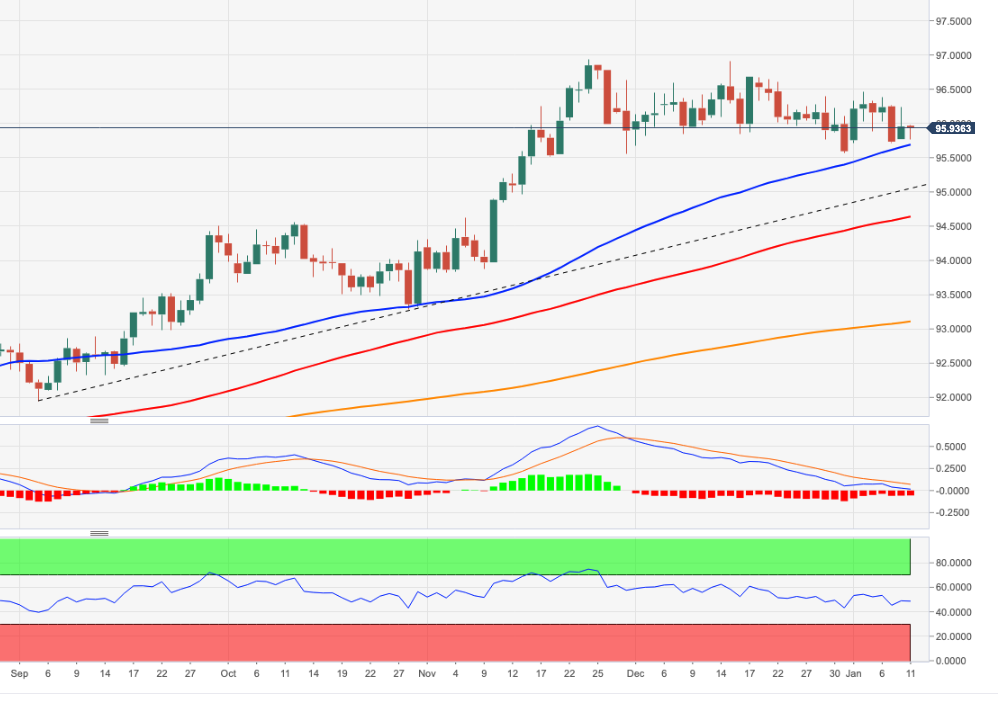
- EUR/USD is subdued just under its 50DMA as traders await Fed speak from two hawks and Chairman Jerome Powell.
- Hawkish Fed speak could support the US dollar, says ING.
EUR/USD has continued its recent pattern of ranging within well-estabilished parameters so far this week. After rebounding on Monday from sub-1.1300 lows as the pair found support ahead of a test of recent lows in the 1.1280 area, EUR/USD rallied all the way back to test its 50-day moving average in earlier Tuesday trade in the 1.1340s. However, for the third time in as many weeks, EUR/USD has been unable to stage a meaningful rebound to the north of this level and is now back to trading in the 1.1330s, broadly flat on the session.
Commentary from senior ECB policymakers on Tuesday has for the most part gone under the radar. President Christine Lagarde emphasised the bank's “unwavering” commitment to its price stability mandate whilst also acknowledging the concern about inflation expressed by many citizens. ECB Chief Economist Philip Lane reiterated the banks current stance that Eurozone inflation is not seen remaining about 2.0% in the medium-term (recall the bank’s forecast for 2023 is for HICP inflation to fall back to 1.8% from an average of 3.2% in 2022). New Bundesbank President and ECB governing council member Joachim Nagel picked up where his predecessor Jens Weidemann left off with a warning in his first speech inflation may remain elevated for longer than currently expected, whilst also urging that the ECB must remain vigilant.
Fed speak incoming
A much more important driver of FX and indeed broader market sentiment in 2022 has been expectations for Fed tightening, which have grown increasingly hawkish after last week’s hawkish Fed minutes and strong labour market report. FX strategists have been surprised by the buck’s inability to muster a sustained rally despite numerous banks and analysts now calling for as many as four rate hikes in 2022 starting in March, as well as for balance sheet runoff to begin as soon as H2. But with Fed hawks Ester George and Loretta Mester speaking at 1400GMT and 1430GMT, followed shortly thereafter by Fed Chair Jerome Powell at 1500GMT ahead of Wednesday’s December Consumer Price Inflation report, there are plenty of potential USD bullish catalysts this week.
Powell is speaking at his Fed Chair renomination hearing before the Senate Banking Committee, with investors hoping for clues as to the timing of expected policy tightening. His remarks in a short initial statement have already been published and did not contain any commentary on the outlook for policy. But there will be a Q&A session where Powell may delve into more detail. Today’s appearance marks Powell’s first opportunity to say how the current outbreak of Omicron influences the outlook for policy – market participants will expect Powell to reiterate the stance laid out in December that it does pose a significant near-term risk to the economy and, if anything, may add to inflation risks. “Today also offers the first opportunity for Fed Chair Powell to comment on the tidal shift in market expectations following the revelations in the FOMC minutes last week” SocGen points out.
Meanwhile, ING warns traders to “expect markets to be particularly sensitive to any discussion on the reduction of the Fed's balance sheet, a topic that became particularly hot after the December FOMC minutes and may cause further fragility in the bond market (and offer more support to the dollar) down the road”. The bank adds that “any Powell-induced dollar strength would normally be channeled through weaker low-yielding FX, although the current soft environment for equities may also continue to weigh on the pro-cyclical sector – leaving the dollar itself as the only potential winner from the Fed’s hawkish message.”
- USD/CHF attracted some dip-buying on Tuesday and inched back closer to a multi-week high.
- Hawkish Fed expectations acted as a tailwind for the USD and extended support to the pair.
- Retreating US bond yields capped the USD and the major ahead of Powell’s Senate hearing.
The USD/CHF pair has managed to recover its early lost ground and was last seen trading around the 0.9265-70 region, just a few pips below a four-week high touched on Monday.
A combination of factors assisted the USD/CHF pair to attract some dip-buying near the 0.9240 region on Tuesday, with bulls now looking to build on its recent gains recorded over the past two weeks. The US dollar reversed modest intraday losses amid the prospects for a faster policy tightening by the Fed. Apart from this, a generally positive risk tone undermined the safe-haven Swiss franc and acted as a tailwind for the major.
It is worth mentioning that the money markets have fully priced in the possibility of an eventual Fed lift-off in March and anticipate four interest rate hikes in 2022. Atlanta Federal Reserve President Raphael Bostic reinforced market bets and said that March would be a reasonable time for the first-rate increase. Bostic expects three rate hikes in 2022, with risks pointing towards a fourth on the possibility of higher inflation.
That said, the ongoing retracement slide in the US Treasury bond yields held back the USD bulls from placing aggressive bets and capped the upside for the USD/CHF pair. Investors also seemed reluctant ahead of Fed Chair Jerome Powell's confirmation hearing before the Senate Banking Committee later during the North American session. Powell's remarks will be closely for clues about the likely timing and the pace of policy normalisation.
Apart from this, investors will take cues from the release of the latest US consumer inflation figures on Wednesday. This will play a key role in influencing the near-term USD price dynamics and provide a fresh directional impetus to the USD/CHF pair. In the meantime, the US bond yields will drive the USD demand, which along with the broader market risk sentiment should allow traders to grab some short-term opportunities around the major.
Technical levels to watch
- GBP/USD struggled to capitalize on its intraday gains to the highest level since November.
- Fed rate hike bets acted as a tailwind for the USD and kept a lid on any meaningful upside.
- Traders also seem reluctant and moved on the sidelines ahead of Powell’s Senate hearing.
The GBP/USD pair surrendered a major part of its intraday gains and retreated back below the 1.3600 round-figure mark during the mid-European session.
Following the previous day's two-way/directionless price move, the GBP/USD pair attracted fresh buying on Tuesday and built on its recent strong gains recorded over the past three weeks or so. The momentum pushed spot prices to the highest level since November and was sponsored by a combination of factors.
The British pound continued drawing some support from hopes that the Omicron outbreak won't derail the UK economy. Moreover, UK Prime Minister Boris Johnson said on Monday that they are looking to reduce the quarantine period to five days from seven and making great progress in seeing off Omicron.
This, along with rising bets for additional rate hikes by the Bank of England, acted as a tailwind for the GBP/USD pair amid some intraday US dollar selling bias. The ongoing retracement slide in the US Treasury bond yields turned out to be a key factor that kept the USD bulls on the defensive.
Apart from this, a generally positive tone around the equity markets further undermined the safe-haven greenback. That said, the prospects for a faster policy tightening by the Fed helped limit the downside for the buck and kept a lid on any meaningful upside for the GBP/USD pair, at least for the time being.
It is worth mentioning that the money markets have fully priced in the possibility of an eventual Fed lift-off in March. The bets were further boosted by comments from Atlanta Federal Reserve President Raphael Bostic, saying that March would be a reasonable time for the first-rate increase.
Bostic added that the runoff of the balance sheet could begin soon after and expects three rate hikes in 2022, with risks pointing towards a fourth on the possibility of higher inflation. Hence, the focus will remain on Fed Chair Jerome Powell's confirmation hearing before the Senate Banking Committee.
Investors will closely scrutinize Powell's remarks for clues about the likely timing and the pace of policy normalisation. Apart from this, Wednesday's release of the US consumer inflation figures will play a key role in influencing the USD and provide a fresh directional impetus to the GBP/USD pair.
The mixed fundamental backdrop warrants some caution for aggressive traders, which, in turn, led to the GBP/USD pair's intraday pullback of nearly 35 pips. That said, the downside is likely to remain cushioned and more likely to attract fresh buying near the 100-day SMA, around mid-1.3500s.
Technical levels to watch
- EUR/JPY reverses Monday’s sharp pullback and regains 131.00.
- Next on the upside comes the YTD highs near 131.60.
EUR/JPY manages to regain the smile and reverses the deep pullback seen at the beginning of the year.
Further consolidation in the cross appears likely in light of the ongoing price action, always around the key 200-day SMA in the mid-130.00s. The breakout of this scheme should lift EUR/JPY to the 131.50/60 band, while the 130.00 neighbourhood is expected to hold the downside for now.
While below the 200-day SMA, today at 130.52, the near-term outlook for EUR/JPY should remain negative.
EUR/JPY daily chart
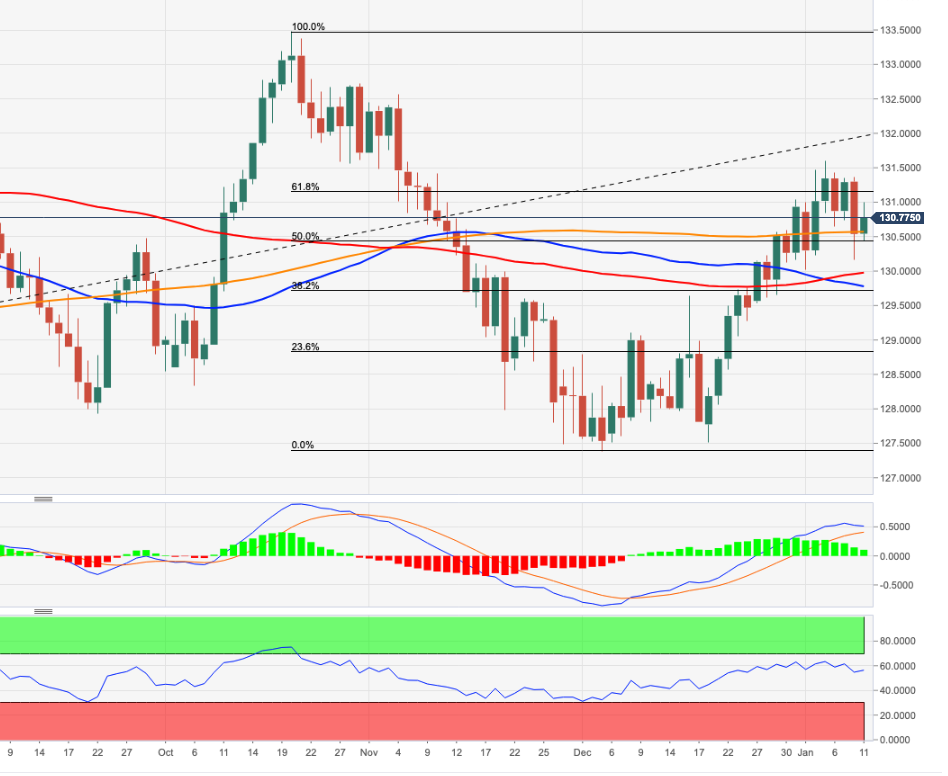
Atlanta Federal Reserve President Raphael Bostic told Reuters on Tuesday that March would be a reasonable time for the first rate increase and added that the runoff of the balance sheet could begin soon after.
Additional takeaways
"Balance sheet should decline faster than in last tightening cycle, perhaps by $100 billion a month or more with no phase-in."
"Fed could easily pull $1.5 trillion of excess liquidity from the financial system, then watch market reaction for further balance sheet reductions."
"Expecting three rate hikes in 2022, with risks pointed towards a fourth on the possibility of higher inflation."
"Full process of balance sheet runoff should be geared to end in a couple of years not drag on."
Comments from business leaders lead me to believe inflation is likely to last longer than expected."
"Business leaders feel they have pricing power and intend to use it; also plan to reorient supply chains to be more resilient but costlier."
"Wages, other labor market dynamics, consistent with maximum employment."
Market reaction
The US Dollar Index edged slightly higher on these comments and was last seen flat on the day at 95.95.
New member of the European Central Bank's Governing Council and Bundesbank President Joachim Nagel argued on Tuesday that the inflation surge in the euro area was not entirely due to temporary factors, as reported by Reuters.
"It's true that high inflation rates can be attributed to special effects that expire automatically. But not entirely," Nagel explained. "I see a danger that inflation could remain high for longer than expected."
Nagel further added that the inflation outlook remains "extraordinarily uncertain."
Market reaction
Nagel's hawkish tone doesn't seem to be helping the shared currency gather strength. The EUR/USD pair was last seen posting small daily gains at 1.1330.
- USD/CAD struggled to capitalize on the overnight bounce and met with a fresh supply on Tuesday.
- The technical set-up supports prospects for an extension of the recent pullback from a one-year high.
- Bears, however, might wait for a convincing break below the 1.2600 mark before placing fresh bets.
The USD/CAD pair struggled to capitalize on the previous day's goodish rebound from the vicinity of the 1.2600 mark, or a one-month low and met with a fresh supply on Tuesday. The pair maintained its offered tone through the first half of the European session and was last seen trading just below mid-1.2600s.
From a technical perspective, the USD/CAD pair, so far, has managed to hold its neck above confluence support comprising of 100-day SMA and the 50% Fibonacci level of the 1.2288-1.2964 move up. This is closely followed by the overnight swing low, which if broken will be seen as a fresh trigger for bearish traders.
Given that oscillators on the daily chart have started gaining negative traction, a convincing break below will set the stage for an extension of the recent pullback from a one-year high set in December. The USD/CAD pair might then accelerate the fall to the 1.2540 area (61.8% Fibo.) en-route the key 1.2500 psychological mark.
On the flip side, the overnight swing high, around the 1.2700 mark, which coincides with the 38.2% Fibo. level, now seems to act as an immediate strong barrier. Some follow-through buying might push spot prices towards the 1.2755-60 horizontal resistance, above which bulls could aim to conquer the 1.2800 mark.
The latter also represents the 23.6% Fibo. level hurdle and should act as a key pivotal point for traders. A sustained strength beyond might negate any near-term negative bias and trigger a short-covering move, which might push the USD/CAD pair towards the next relevant hurdle near the 1.2860 horizontal zone.
USD/CAD daily chart
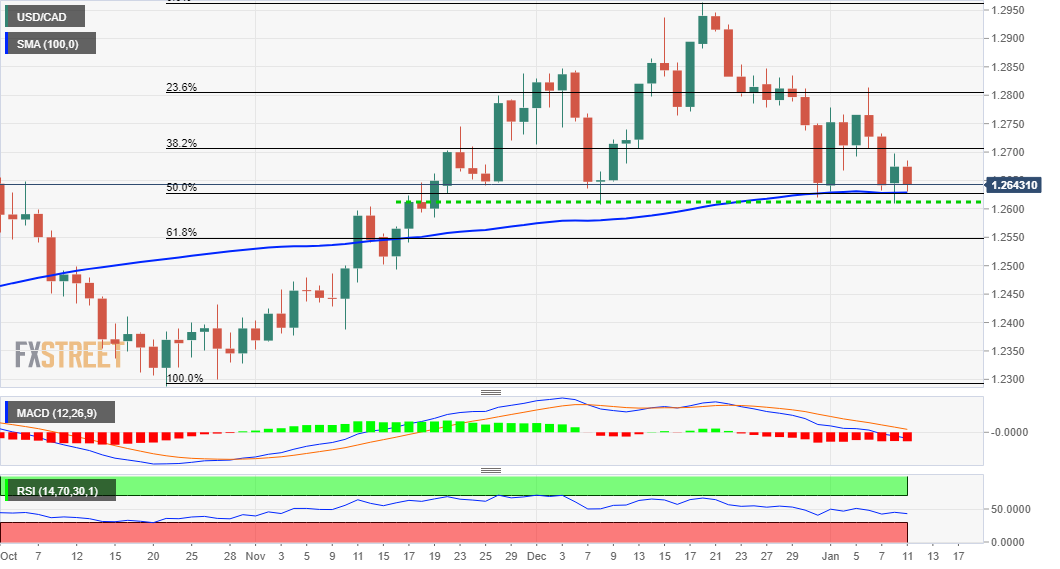
Levels to watch
UOB Group’s Senior Economist Julia Goh and Economist Loke Siew Ting comment on the latest employment figures in Malaysia.
Key Takeaways
“All labour market indicators showed further improvement in Nov 2021 with Malaysia’s unemployment rate holding steady at 4.3%, the labour force participation rate inching up to a historical high of 68.9% (from 68.8% in Oct), and total employment continuing to hit a new high at 15.61m (Oct: 15.55m).”
“The hiring momentum was primarily held up by continued employment in services, manufacturing, and construction sectors, which fully offset the falling employment in agriculture and mining & quarrying sectors.”
“We continue to expect a sustain recovery in Malaysia’s labour market this year amid increasing challenges. This is largely premised on the government’s mitigation strategies to contain the pandemic, ongoing policy support, and additional aids for flood victims. We reiterate our end-2022 jobless rate projection of 3.6% (vs. an estimated 4.2% by end-2021).”
European Central Bank President Christine Lagarde said on Tuesday they understand that rising prices are a concern for many people and noted that they take this concern very seriously, as reported by Reuters.
"People can trust that our commitment to price stability is unwavering, which is critical for the firm anchoring of inflation expectations and for confidence in the currency," Lagarde added. "The new strategy is especially important today in light of the phase of higher inflation we are seeing."
Market reaction
The shared currency came under modest bearish pressure after comments and the EUR/USD pair was last seen trading flat on the day at 1.1327.
The World Health Organization's (WHO) Europe Director, Hans Kluge, noted on Tuesday that the European region saw over seven million newly reported cases of COVID-19 in the first week of 2022, as reported by Reuters.
"The Institute for Health Metrics and Evaluation (IHME) forecasts that more than 50% of the population in the European region will be infected with Omicron in the next 6-8 weeks," Kluge added. "Because of the unprecedented scale of transmission, we are now seeing rising COVID-19 hospitalizations."
Market reaction
These comments don't seem to be having a significant impact on market sentiment and Germany's DAX 30 Index was last seen rising more than 1% on a daily basis.
- Gold gained some positive traction for the third successive day on Tuesday.
- Retreating US bond yields undermined the USD and remained supportive.
- A positive risk tone, hawkish Fed expectations might cap any further upside.
Gold built on the previous day's positive move back above the $1,800 mark and gained some follow-through traction for the third successive day on Tuesday. The XAU/USD maintained its bid tone through the first half of the European session and climbed to a three-day high, around the $1,810 region in the last hour.
The ongoing retracement slide in the US Treasury bond yields prompted fresh US dollar selling, which, in turn, was seen as a key factor that benefitted the dollar-denominated commodity. Apart from this, the momentum could further be attributed to some technical buying on a sustained strength above the very important 200-day SMA.
That said, a generally positive tone around the equity markets acted as a headwind for the safe-haven gold. This, along with the prospects for a faster policy tightening by the Fed, might hold back traders from placing aggressive bullish bets around the non-yielding yellow metal. It is worth mentioning that the money markets have fully priced in the possibility of an eventual Fed lift-off in March and anticipate four rate hikes in 2022.
Hence, the market focus will remain glued to Fed Chair Jerome Powell's confirmation hearing before the Senate Banking Committee later this Tuesday. In the prepared statement released on Monday, Powell reiterated that the Fed will use tools to support the economy/strong labour market and prevent higher inflation from becoming entrenched. Investors will look for fresh clues about the likely timing and the pace of policy normalisation.
Apart from this, Wednesday's release of the latest US consumer inflation figures will draw market attention and play a key role in influencing the USD price dynamics. This makes it prudent to wait for a strong follow-through buying before confirming that gold has formed a near-term bottom and positioning for any further appreciating move.
Technical outlook
From a technical perspective, gold, so far, has managed to defend an upward sloping trend-line extending from August 2021 swing lows. The mentioned support, around the $1,784-83 region, coinciding with Friday's low, should act as a key pivotal point. A convincing break below will be seen as a fresh trigger for bearish traders and pave the way for deeper losses.
On the flip side, any subsequent move beyond the $1,814-15 immediate hurdle is more likely to confront stiff resistance and remain capped near the $1,830-32 heavy supply zone. Some follow-through buying will negate any near-term bearish bias and lift gold prices to $1,849-50 intermediate resistance en-route the $1,869-70 region.
Gold daily chart
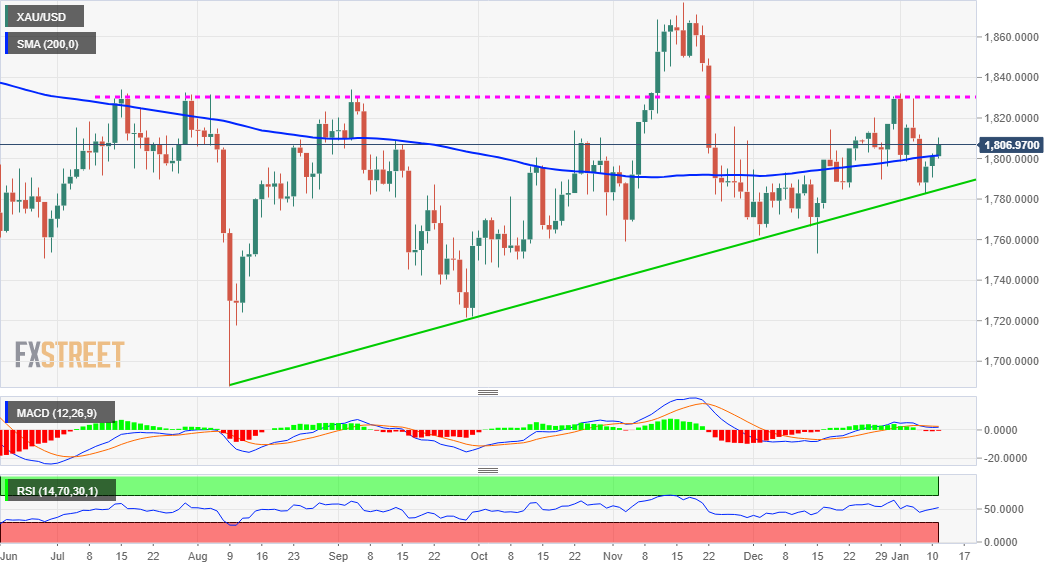
Levels to watch
Economists at ING bank offer their afterthoughts on the Philippines Trade Balance report, which saw the trade deficit at a new record.
Key quotes
“November trade data showed both exports and imports rising although the key metric in this release was for inbound shipments (imports) growth, which accelerated to 36.8%YoY. This surge in imports was much greater than anticipated (28.2% forecast) and was enough to push the overall trade balance deep into deficit territory. “
“The November trade gap hit a record -$4.7bn with strong growth recorded in almost all import subcategories. “
“The Philippine economy continues to gradually reopen although new waves of Covid-19 could threaten to delay some of the recent progress.”
“Meanwhile, exports gained 6.6%, driven in large part by the 5.6% growth of electronics exports, which comprises more than 50% of total exports.”
- The rout extends, as USD/INR breaches key support on Monday.
- Renewed US dollar weakness amid pullback in yields supports the downside.
- USD/INR eyes September 28 low at 73.74 after November lows give way.
The selling interest around USD/INR remains unabated, as the pair falls for the fifth consecutive day this Tuesday, breaking through the key support levels.
The latest leg down in the spot could be associated with the renewed weakness in the US dollar across the board. The greenback tracks the pullback in the Treasury yields, as investors turn to repositioning ahead of Fed Chair Jerome Powell’s testimony due later on Tuesday and Wednesday’s US inflation data.
Additionally, a minor slowdown in the new coronavirus infections in India supports the local currency, exerting further bearish pressure on the pair. Meanwhile, the ongoing upbeat momentum in oil prices, courtesy of the geopolitical tensions in Kazakhstan, fails to temper the underlying bullish tone around the Indian rupee.
At the time of writing, the spot is trading close to 74.00, swinging back from four-month lows of 73.83 reached in the last hours.
The bearish outlook got reaffirmed after the pair gave a weekly closing below the critical 200-Daily Moving Average (DMA) at 74.29 on Friday.
The latest decline found additional legs on Monday’s closing below the rising trendline support at 74.13.
Selling resurgence could see a fresh downswing towards the September 28 lows of 73.74, below which the 73.50 support area could be tested.
USD/INR: Daily chart
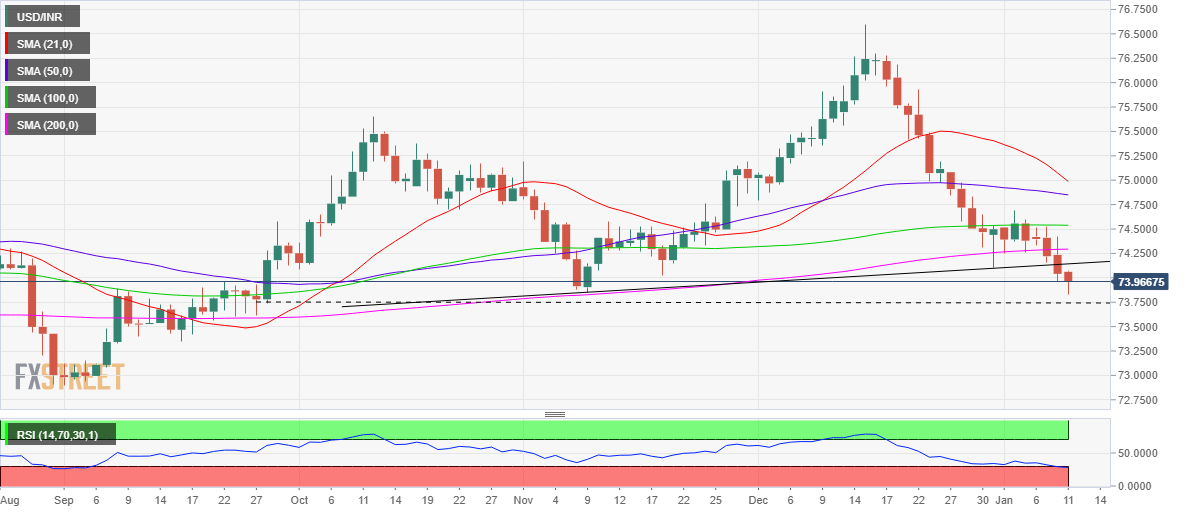
The 14-day Relative Strength Index (RSI) is lying within the oversold region, pointing to a potential rebound in the spot.
Any retracement will retest the rising trendline support now resistance at 74.13, above which 200-DMA could test the bearish commitments.
Acceptance above the latter will initiate a fresh recovery rally towards the 100-DMA at 74.54.
USD/INR: Additional levels
Senior Economist at UOB Group Alvin Liew assesses the latest release of the US Nonfarm Payrolls.
Key Takeaways
“US jobs creation disappointed again with a 199,000 increase in Dec, well below expectations, but the upside surprise came from the unemployment rate which slipped to 3.9% (from 4.2% in Nov), below the Fed’s longer run level of 4%.”
“Wage growth continued at a brisk pace in Dec, again reflecting the growing demand and shortages for workers.”
“Taken together, the jobs market continued to make rapid improvements and the Dec numbers reflected the difficulties of hiring rather than the lack of employment opportunities.”
- EUR/USD keeps the range bound trade unchanged above 1.1300.
- ECB’s C.Lagarde due to speak later in the European morning.
- Chairman J.Powell will testify before the Senate in the NA session.
The single currency regains upside traction and motivates EUR/USD to return to the 1.1350 region on Tuesday.
EUR/USD focuses on Lagarde, Powell
EUR/USD leaves behind the pessimism seen at the beginning of the week and regains buying interest. Indeed, the pair bounces off Monday’s lows in the 1.1285/80 band to the mid-1.1300s, where some initial resistance turned up so far.
The resumption of the upside bias in the pair comes in response to another knee-jerk in the buck, this time dragging the US Dollar Index (DXY) back to the 95.80 region amidst the lack of further advance in US yields, where the 10y benchmark note seems to have met a tough barrier around 1.80%. On this side of the Atlantic, the rally in yields of the German 10y Bund in place since mid-December has so far faltered just ahead of the 0.00% at the beginning of the week.
Minor releases in the euro area saw the Industrial Production in Span expanding 4.8% in the year to November and Retail Sales in Italy contracting at a monthly 0.4% also in November.
Later in the European morning, Chairwoman C.Lagarde is due to speak. Across the pond, Chief J.Powell will testify before the US Senate while the NFIB index and the IBD/TIPP index are also due.
What to look for around EUR
EUR/USD remains in a consolidation mode since late November, with gains capped by the proximity of the 1.1400 mark and the lower end offering contention around 1.1220. In the meantime, the pair’s price action continues to track the performance of the greenback as well as the policy divergence between the ECB vs. the Federal Reserve and the response to the persistent elevated inflation on both sides of the Atlantic. On another front, the unabated progress of the coronavirus pandemic remains as the exclusive factor to look at when it comes to the economic growth prospects and investors’ morale.
Key events in the euro area this week: ECB C.Lagarde (Tuesday) - EMU Industrial Production (Wednesday) - Germany Full Year GDP Growth 2021, ECB C.Lagarde (Friday).
Eminent issues on the back boiler: Asymmetric economic recovery post-pandemic in the euro area. ECB stance/potential reaction to the persistent elevated inflation in the region. ECB tapering speculation/rate path. Presidential elections in France.
EUR/USD levels to watch
So far, spot is gaining 0.22% at 1.1350 and faces the next up barrier at 1.1364 (55-day SMA) seconded by 1.1386 (monthly high November 30) and finally 1.1464 (weekly high Nov.15). On the other hand, a break below 1.1272 (weekly low Jan.4) would target 1.1221 (weekly low Dec.15) en route to 1.1186 (2021 low Nov.24).
- Upbeat Australian Retail Sales assisted AUD/USD to regain positive traction on Tuesday.
- Retreating US bond yields prompted some USD selling and also provided an additional lift.
- Bulls struggled to make it through the 0.7200 mark ahead of Powell’s nomination hearing.
The AUD/USD pair maintained its bid tone through the early European session, albeit seemed struggling to capitalize on the move and remained below the 0.7200 mark.
Following the previous day's turnaround from the mentioned handle, the AUD/USD pair attracted fresh buying on Tuesday and was supported by a combination of factors. The Australian dollar drew some support from upbeat domestic Retail Sales data, which recorded a stronger than expected growth for the second successive month in November.
Adding to this, the country's trade balance data showed that imports jumped 6% during the reported month and reaffirmed strong domestic demand. On the other hand, the ongoing retracement slide in the US Treasury bond yields kept the US dollar bulls on the defensive. This was seen as another factor that provided an additional lift to the AUD/USD pair.
Despite the supporting factors, the uptick lacked bullish conviction and the AUD/USD pair, so far, has struggled to make it through the 0.7200 mark. The prospects for a faster policy tightening by the Fed acted as a tailwind for the greenback, which, in turn, held back traders from placing aggressive bullish bets and kept a lid on any meaningful gains.
It is worth mentioning that the money markets have fully priced in the possibility of an eventual Fed lift-off in March and anticipate four rate hikes in 2022. Hence, the focus will remain on Fed Chair Jerome Powell's nomination hearing later during the US session, which will be looked for fresh clues on the timing and pace of policy normalisation.
Apart from this, investors will also take cues from the release of the latest US consumer inflation figures on Wednesday. This will play a key role in influencing the near-term USD price dynamics and provide a fresh directional impetus to the AUD/USD pair. In the meantime, the broader market risk sentiment might produce some short-term trading opportunities.
Technical levels to watch
- USD/TRY fails to react to the DXY weakness while below the 14.00 barrier.
- The lira ignores the latest measures under Turkey’s currency protection scheme.
- Hawkish Fed outlook, 21-DMA keep the buoyant tone intact around the spot.
USD/TRY is holding the higher ground on Tuesday, still well within the recent trading range just below the 14.00 level.
The sentiment around the cross remains underpinned by the hawkish Fed outlook, although markets have resorted to profit-taking in the US dollar longs ahead of Wednesday’s critical inflation data release.
Further, the lira continues to remain vulnerable even though the Turkish government’s stop-gap measures to mitigate the depreciation of the exchange rate.
The Official Gazette showed on Tuesday, Turkey’s authorities have included corporate foreign currency and gold deposit accounts converted to lira in a scheme that protects local currency savings against exchange rate volatility, per Reuters.
Meanwhile, Turkey’s surging inflationary pressures and the Fed’s aggressive tightening expectations continue to bode well for USD/TRY. Traders await Fed Chair Jerome Powell’s confirmation hearings for fresh hints on the timing of the rate hikes and a potential balance sheet run-off.
USD/TRY: Technical outlook
Looking at USD/TRY’s technical chart, the pair is on track to confirm the third straight Doji candlestick on the daily sticks.
This suggests signs of clear indecision on the side of the USD/TRY traders. The bias, however, remains tilted to the upside, as the 14-day Relative Strength Index (RSI) holds comfortably above the midline.
Acceptance above the 14.00 supply zone is critical for buyers to extend the recovery momentum from near 10.25 troughs.
The December 21 high of 14.14 will come into play on a sustained break above 14.00.
On the downside, the previous resistance of the 21-Daily Moving Average (DMA), now at 13.33, offers fierce support, which if broken will trigger a sharp sell-off towards the January 3 low of 12.75.
Further south, the bullish 50-DMA of 12.44 could save the day for bullish traders.
USD/TRY: Daily chart
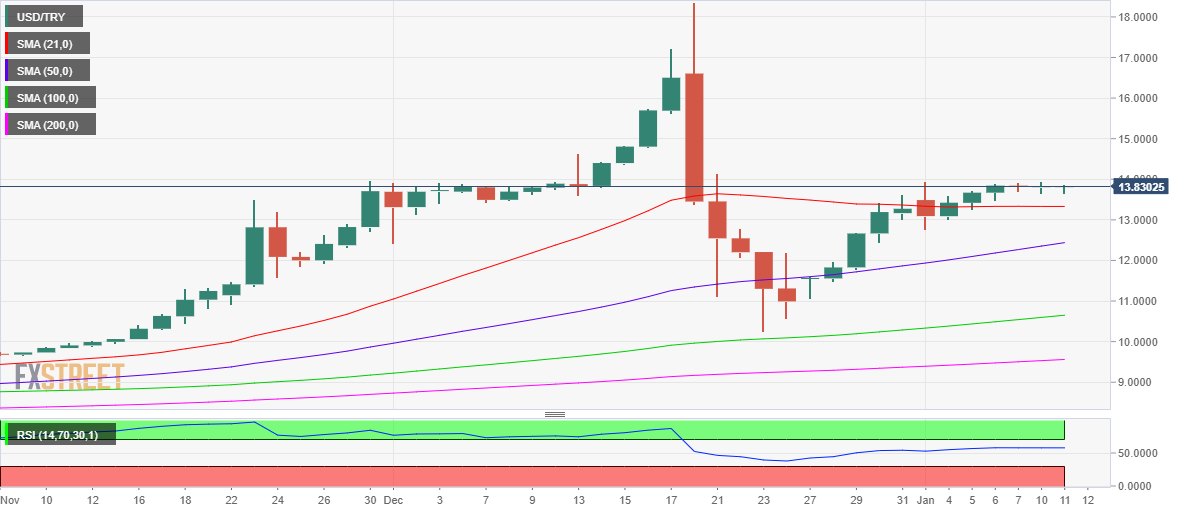
FX option expiries for January 11 NY cut at 10:00 Eastern Time, via DTCC, can be found below.
- EUR/USD: EUR amounts
- 1.1275 937m
- 1.1325 610m
- 1.1400 568m
- GBP/USD: GBP amounts
- 1.3550 494m
- USD/JPY: USD amounts
- 113.60 650m
- 115.50 941m
- AUD/USD: AUD amounts
- 0.7150 910m
- 0.7200 786m
- GBP/JPY gained strong positive traction on Tuesday and has now reversed the overnight losses.
- Receding Omicron fears, BoE rate hike bets continued acting as a tailwind for the British pound.
- Signs of stability in the equity markets undermined the safe-haven JPY and remained supportive.
- Absent relevant market-moving economic releases warrant caution for aggressive bullish traders.
The GBP/JPY cross refreshed daily high during the early European session, with bulls now looking to extend the momentum further beyond the 157.00 round-figure mark.
A combination of supporting factors assisted the GBP/JPY cross to regain positive traction on Tuesday and build on the overnight bounce from sub-156.00 levels, or a four-day low. Hopes that the Omicron outbreak won't derail the UK economy and rising bets for additional rate hikes by the Bank of England continued underpinning the British pound.
In the latest coronavirus-related developments, UK Prime Minister Boris Johnson said on Monday that they are looking at the possibility of reducing the quarantine period to five days from seven. Johnson further added that they are making great progress in seeing off Omicron but noted that the number of cases in the hospital was still increasing.
This comes on the back of a surprise interest rate hike by the BoE in December. Moreover, the markets expect another three to four rate increases in 2022. Apart from this, the emergence of fresh US dollar selling was seen as another factor that acted as a tailwind for the sterling, which, in turn, provided a goodish lift to the GBP/JPY cross.
On the other hand, signs of stability in the equity markets undermined the safe-haven Japanese yen and further contributed to the bid tone surrounding the GBP/JPY cross. It, however, remains to be seen if bulls are able to capitalize on the move or face rejection near the 157.35-40 resistance zone amid absent relevant market moving economic releases.
Technical levels to watch
USD/CNH could head towards the 6.4100 level amidst the current upside momentum, commented FX Strategists at UOB Group.
Key Quotes
24-hour view: “We highlighted yesterday that ‘the underlying tone has softened somewhat but any weakness is expected to encounter strong support at 6.3730’. However, USD did not weaken as it traded sideways between 6.3772 and 6.3863 before closing largely unchanged (-0.04%). Momentum indicators are mostly ‘flat’ and USD is likely to continue to trade sideways. Expected range for today, 6.3750/6.3880.”
Next 1-3 weeks: “After USD rose to 6.3975, we highlighted last Friday (07 Jan, spot at 6.3900) that ‘upward momentum has improved slightly but it appears too early to expect a sustained advance’. We added, there is room for USD to edge higher to 6.4100 but a breach of 6.3730 (no change in ‘strong support’ level) would indicate that the build-up in momentum has fizzled out. There is no change in our view for now.”
- DXY surrender part of Monday’s advance and drops below 96.00.
- US yields seem to be taking a breather around recent peaks.
- NFIB Index, IBD/TIPP Index next of note in the US calendar.
The US Dollar Index (DXY), which measures the greenback vs. a bundle of its main competitors, trades on the defensive and slips back to the area below the 96.00 mark on turnaround Tuesday.
US Dollar Index looks to yields, Powell
The index extends the erratic performance for yet another session on Tuesday, eroding part of Monday’s gains and always amidst the broad consolidative theme prevailing since early December.
In addition, the upside momentum in US yields seems to have run out of some vigour after last week’s strong rebound and now look to stabilize in the area of recent highs, removing at the same time some strength from the buck.
No meaningful reaction in the FX space after talks between the US and Russia yielded the promise of resuming the dialogue in the not-so-distant future.
In the US data space, Chief Powell will testify before the Committee on Banking, Housing and Urban Affairs, with the imminent start of the hiking cycle by the Fed and his re-election expected to be in the centre of the debate.
In addition, the NFIB Business Optimism Index and the IBD/TIPP Economic Optimism index are due later in the NA session.
What to look for around USD
The index remains side-lined around the 96.00 neighbourhood amidst the ongoing absence of key drivers and lack of a clear direction in the broad risk appetite trends. In the meantime, the dollar seems somewhat decoupled from the recent strong rebound in US yields in contrast with the steady price action in the dollar in past sessions. In the meantime, the dollar’s constructive outlook is seen underpinned by the Fed’s intentions to start the hiking cycle earlier than anticipated amidst persevering elevated inflation, supportive Fedspeak, higher yields and the solid performance of the US economy.
Key events in the US this week: Fed J.Powell Testimony (Tuesday) - December CPI (Wednesday) - Initial Claims, FOMC L.Brainard Testimony, Producer Prices (Thursday) - Retail Sales, Industrial Production, Flash Consumer Sentiment, Business Inventories (Friday).
Eminent issues on the back boiler: Start of the Fed’s tightening cycle. US-China trade conflict under the Biden’s administration. Debt ceiling issue. Potential geopolitical effervescence vs. Russia and China.
US Dollar Index relevant levels
Now, the index is retreating 0.11% at 95.84 and a break above 96.46 (weekly top Jan.4) would open the door to 96.90 (weekly high Dec.15) and finally 96.93 (2021 high Nov.24). On the flip side, the next down barrier emerges at 95.65 (55-day SMA) seconded by 95.57 (monthly low Dec.31) and then 95.51 (weekly low Nov.30).
- NZD/USD gained some positive traction on Tuesday amid modest USD weakness.
- Retreating US bond yields turned out to be a key factor that undermined the USD.
- Fed rate hike bets should limit any deeper USD losses and cap gains for the major.
The NZD/USD pair traded with a mild positive bias and held steady above mid-0.6700s through the early European session, albeit lacked any follow-through buying.
The US dollar struggled to capitalize on the previous day's modest gains and edged lower during the early part of the trading on Tuesday amid a further pullback in the US Treasury bond yields. This, in turn, was seen as a key factor that assisted the NZD/USD pair to regain positive traction. That said, a combination of factors kept a lid on any meaningful upside, at least for the time being.
The prospects for a faster policy tightening by the Fed held back traders from placing aggressive bearish bets around the USD. In fact, the money markets have fully priced in the possibility of an eventual Fed lift-off in March and are anticipating four interest rate hikes by the end of 2022. This, along with the cautious market mood, could further benefit the greenback's safe-haven status.
The recent strong rally in the US Treasury bond yields continued weighing on investors' sentiment. This was evident from a softer tone around the equity markets, which, in turn, acted as a headwind for perceived riskier currencies, including the kiwi. Trades also seemed reluctant and preferred to wait on the sidelines ahead of Fed Chair Jerome Powell's nomination hearing later this Tuesday.
Powell's comments would be closely scrutinized for fresh clues about the timing and pace of monetary policy normalisation by the Fed. Apart from this, investors will take cues from the release of the latest US consumer inflation figures on Wednesday. This, in turn, will play a key role in influencing the USD price dynamics and provide a fresh directional impetus to the NZD/USD pair.
Even from a technical perspective, the NZD/USD pair has been oscillating in a narrow trading band over the past one week or so. This further makes it prudent to wait for a strong follow-through buying before positioning for any further near-term appreciating move.
Technical levels to watch
Here is what you need to know on Tuesday, January 11:
With the benchmark 10-year US Treasury bond yield erasing its daily gains after failing to break above 1.8% on Monday, the US Dollar Index lost its traction in the second half of the day. Major currency pairs trade in familiar ranges early Tuesday as investors remain on the sidelines as FOMC Chairman Jerome Powell heads to Senate for his nomination hearing. The NFIB Business Optimism Index for December and the IBD/TIPP Economic Optimism Index for January will be featured in the US economic docket as well.
According to his prepared remarks, Powell will reiterate that the Fed will aim to stop higher inflation from getting trenched while delivering his opening statement. He will also note that the economy has rapidly gained strength despite the ongoing pandemic and explain that this has been giving rise to elevated inflation.
Market participants will look for fresh hints about the timing of the rate hike and the possibility of the Fed using quantitative tightening to ease price pressures. The reaction in US T-bond yields to Powell's comments could impact the dollar's valuation in the American trading hours.
Meanwhile, Wall Street's main indexes closed little changed on Monday and the US stock index futures trade flat early Tuesday.
EUR/USD closed in the negative territory on Monday but managed to hold above 1.1300. The pair was last seen posting small daily gains slightly below 1.1350. European Central Bank President Christine Lagarde is scheduled to deliver a speech at 1020 GMT.
GBP/USD fell to a daily low of 1.3532 but erased the majority of its daily losses before closing at 1.3575 on Monday. The pair is inching closer to 1.3600 in the early European session.
USD/JPY came under heavy bearish pressure on retreating US T-bond yields late Monday and closed the third straight day in the negative territory. The pair is trading within a touching distance of 115.00.
Gold climbed above the key $1,800 resistance earlier in the day and continues to push higher toward $1,810. The yellow metal remains at the mercy of US T-bond yields.
Bitcoin dipped below $40,000 for the first time since late September on Monday but recovered to $42,000 area. Ethereum tested $3,000 but buyers managed to defend this level so far.
- USD/JPY gained some positive traction on Tuesday, albeit lacked bullish conviction.
- The cautious market mood underpinned the safe-haven JPY and acted as a headwind.
- Retreating US bond yields weighed on the USD and collaborated to cap the upside.
The USD/JPY pair trimmed a part of its modest intraday gains and was last seen trading just a few pips above the daily low, around the 115.20-25 area heading into the European session.
Having defended the key 115.00 psychological mark, the USD/JPY pair attracted some buying during the early part of the trading on Tuesday, though a combination of factors capped the upside. The US dollar struggled to capitalize on the overnight positive move amid retreating US Treasury bond yields. Apart from this, the cautious market mood benefitted the safe-haven Japanese yen and kept a lid on any meaningful gains for the major.
That said, the prospects for a faster policy tightening by the Fed might continue to act as a tailwind for the US bond yields and the buck. In fact, the money markets have fully priced in the possibility of an eventual Fed lift-off in March and are anticipating four interest rate hikes by the end of 2022. Hence, the market focus will remain glued to Fed Chair Jerome Powell's nomination hearing, due later during the US session on Tuesday.
Apart from this, the release of the latest US consumer inflation figures on Wednesday will be looked upon for fresh clues on the timing and pace of policy normalisation by the Fed. This will play a key role in influencing the near-term USD price dynamics and provide a fresh directional impetus to the USD/JPY pair. In the meantime, the US bond yields and the broader market risk sentiment might produce some short-term trading opportunities.
Technical levels to watch
Analysts at TD Securities (TDS) believe that gold price still has some room for the upside, despite the hawkish Fed outlook for 2022.
Key quotes
“Gold posted a mixed and a very volatile performance in 2021; it moved up to a high of just under $1,960/oz in the early days of 2021, then to a low of $1,677/oz in late-summer, followed by a rally towards nearly $1,875/oz in mid-November, before falling to $1,750s/oz by mid-December.“
“Real interest rate trends, which were driven by inflation expectations, nominal rates and Fed policy signals, led to this flux.”
“Considering this framework, and the fact that some gold market players are pricing a Fed funds hike as early as March and the possibility of an early balance sheet runoff this year, the current investor bias led to bloated short positions and has kept prices at around $1,790s/oz.”
“However, while the US central bank may be on track to raise rates, it will still provide an expansionary monetary policy. And, central banks will continue to buy gold, while investors are looking to diversify given a higher perceived risk of equity market volatility, suggesting that gold speculators' relative short positioning may still drive the yellow metal into the $1,850s/oz in the early months of 2022.”
“But, while negative real rates along the curve should protect gold from a full-blown rout, the yellow metal is projected to trade in the mid $1,600s for much of H2-2022.”
- USD/CHF pares recent gains around monthly peak, off intraday low at the latest.
- Clear break of 21-DMA, previous resistance from November favor buyers.
- Five-month-old support line adds to the downside filters.
USD/CHF lick the intraday wounds while picking up bids from the daily low to 0.9265 heading into Tuesday’s European session.
Even so, the Swiss currency (CHF) pair drops 0.08% on a day as bulls take a breather following the heaviest daily jump since June.
That said, the previous day’s upside break of the 21-DMA and descending trend line from November 24 joins bullish MACD signals to keep buyers hopeful to aim for the mid-December peak surrounding 0.9300.
Though, any further upside will need to cross the 0.9330-35 area before challenging the last monthly peak of 0.9373.
Meanwhile, pullback moves remain elusive until the quote stay beyond the resistance-turned-support convergence around 0.9200.
Even if the USD/CHF prices drop below 0.9200, an ascending support line from August, close to 0.9140, will challenge the pair bears.
USD/CHF: Daily chart

Trend: Further upside expected
The People’s Bank of China (PBOC) is expected to cut the one-year medium-term lending facility (MLF) rate after slashing its loan prime rate (LPR) in December, analysts at Australia and New Zealand (ANZ) banking group noted.
Key quotes
“China’s policymakers proposed to “optimise the central bank policy rate system” at the People’s Bank of China (PBoC)’s Q4 monetary policy committee meeting (MPC) in December 2021. We believe this signals the possibility of a 10bp cut in the 1Y medium-term lending facility (MLF) rate. “
“The cut in the loan prime rate (LPR) in December shows that the market has been ahead of the policy decision already.”
“The 1Y MLF, which is currently at 2.95%, seems too high to be a medium-term rate pivot for bank asset pricing, because China’s new asset management rules have brought about structural changes to banks’ liabilities, in our view.”
“Furthermore, China’s policy stance has shifted to growth stabilization. The optimization of the policy rate system will help to transmit liquidity that has accumulated in the banking system to the real economy.”
- GBP/USD remains firmer around the highest levels in nine weeks.
- DUP Leader pushes for NI solution, Truss sounds optimistic before Brexit talks with EU’s Maros Sefcovic.
- Virus woes escalate but UK Retail Sales, consumer spending increased in December.
- Cautious optimism weigh on yields, US dollar ahead of Fed Chair Powell’s testimony.
GBP/USD stays firmer around 1.3600, up 0.12% intraday heading into Tuesday’s London open. The cable pair rose to the highest levels since November 09 the previous day before reversing from 1.3603 amid a US dollar rebound. The latest advances, however, are multiple catalysts responsible in addition to the greenback’s weakness.
Among them, upbeat details of the UK British Retail Consortium (BRC) consumer survey and Barclaycard data, shared by Reuters, gain the first attention. “Total sales in November were 5.0% higher than a year earlier, the biggest annual increase since July and up from an increase of 1.3% in October,” the news said. Reuters also added, “Separate credit and debit card data from payments provider Barclaycard showed consumer spending - which includes things such as eating out and travel, as well as shopping - was 16.0% higher than in November 2019, before the pandemic.”
Elsewhere, the Financial Times (FT) quotes multiple economists, including former Bank of England official Tony Yates, to back UK PM Boris Johnson’s decision to ride out the Omicron wave of Covid-19 infections with minimal restrictions might turn out to be the right call for the economy.
Additionally, comments from Merck, suggesting that the Molnupiravir mechanism to work against omicron, as well as any covid variant, joins the latest easing of the virus cases in the UK versus the record daily infections in the US to help the GBP/USD buyers.
On the contrary, the Democratic Unionist Party (DUP) leader Sir Jeffrey Donaldson said that the British government must outline a timetable for how and when changes will be made to Northern Ireland (NI) Protocol, after meeting UK Brexit Minister Liz Truss. It should be noted, however, that the FT said, “Truss has struck a warmer tone than Frost in initial contacts and has invited Maros Sefcovic, the EU’s Brexit commissioner, to meet at her grace-and-favor mansion in Chevening, Kent, on Thursday night, promising “constructive proposals” to break the deadlock.”
Furthermore, indecision over the Fed’s next moves and steady print of the US inflation expectations, as per 10-Year Breakeven Inflation Rate numbers from the Federal Reserve Bank of St. Louis (FRED), favor the market’s cautious optimism during Asia.
While portraying the mood, the US Treasury yields traded mixed while the US Dollar Index (DXY) reverses the previous day’s gains. Further, the S&P 500 Futures remains indecisive.
Moving on, today’s testimony by Fed Chairman Jerome Powell will offer intraday direction ahead of Wednesday’s US Consumer Price Index (CPI).
Read: US Consumer Price Index December Preview: The Fed’s die is cast
Technical analysis
While the current advances eye 1.3600 threshold, the upper line of the stated triangle from December 31 and a horizontal line comprising multiple levels marked since November, highlight the 1.3610 level as the key hurdle. Should the quote rises past 1.3610, which becomes less likely, a run-up towards November’s high near 1.3700 can’t be ruled out.
On the flip side, pullback moves may initially aim for the triangle’s lower line near 1.3550, a break of which will direct sellers towards a 50-SMA level of 1.3530
UOB Group’s FX Strategists noted USD/JPY is now seen navigating within the 114.55-115.90 range in the next weeks.
Key Quotes
24-hour view: “We expected USD to ‘drift lower’ yesterday but we were of the view that ‘a break of the strong support at 115.30 is unlikely’. However, USD cracked the strong support and plummeted to 115.03. Downward momentum has improved and risk for today is on the downside. As the decline is approaching oversold territory, any dip below the 115.00 may not be sustained (next support is at 114.80). On the upside, a break of 115.60 (minor resistance is at 115.40) would indicate that the current downward pressure has eased.”
Next 1-3 weeks: “We held a positive view in USD since early last week (see annotations in the chart below). As USD eased off from a high of 116.34, we highlighted yesterday (10 Jan, spot at 115.60) that the chance for USD to advance to 116.50 has diminished. USD subsequently breached our ‘strong support’ level at 115.30 (low of 115.03). The break of the ‘strong support’ indicates that the positive phase has come to an end. While downward momentum is beginning to build, it is too soon to expect a sustained decline. From here, USD is likely to trade between 114.55 and 115.90.”
Considering advanced prints from CME Group for natural gas futures markets, open interest increased for the second session in a row on Monday, now by nearly 2K contracts. Volume followed suit and added around 72.6K contracts to the previous build.
Natural Gas ready for further upside
Prices of natural gas started the week with a gap higher past the $4.00 mark per MMBtu. The move was in tandem with rising open interest and volume, indicative that the continuation of the rebound appears likely in the very near term. While above the 200-day SMA at $4.030, the outlook for the commodity is seen as constructive.
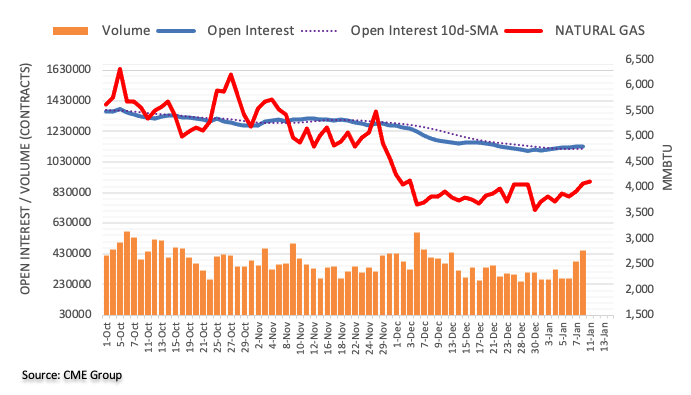
“Inflation will fall this year,” the European Central Bank (ECB) Phillip Lane said in an interview on Tuesday.
Additional quotes
“Will fall below ECB’s target of 2% in 2023 and 2024.”
“Does not see behavior that would suggest inflation will remain above ECB’s target in the medium term.”
The annualized Eurozone Consumer Price Index (CPI) jumped by 5.0% in December, surprising markets to the upside while a tad higher from the previous jump of 4.9%, the latest data published by Eurostat showed on Tuesday.
Market reaction
EUR/USD stays unfazed by these comments, currently trading at 1.1342, up 0.15% on the day.
Further decline in NZD/USD is forecast to meet tough support in the 0.6700 area in the short-term horizon, suggested FX Strategists at UOB Group.
Key Quotes
24-hour view: “Yesterday, we held the view that ‘the bias is tilted to the upside’. Our expectations did not materialize as NZD traded sideways between 0.6737 and 0.6782. Further sideway-trading would not be surprising, likely between 0.6735 and 0.6785.”
Next 1-3 weeks: “Last Friday (07 Jan, spot at 0.6745), we highlighted that downward momentum is beginning to improve but any weakness in NZD is expected to face solid support at 0.6700. Since then, NZD has not been able to make any headway on the downside. There is no change in our view for now and only a breach of 0.6805 (no change in ‘strong resistance’ level) would indicate that the build-up in momentum has fizzled out.”
CME Group’s preliminary readings for crude oil futures markets noted traders added around 14.2K contracts to their open interest positions at the beginning of the week, extending at the same time the ongoing uptrend. On the other hand, volume went down for the second session in a row, this time by more than 85K contracts.
WTI looks to return to $80.00
Crude oil started the week on the back footing and came under pressure following recent highs past the $80.00 mark per barrel. Monday’s downtick was on the back of rising open interest, which is indicative that further decline could be in the pipeline. That said, the next contention in WTI is expected to emerge at the YTD low at $74.30 (January 3).
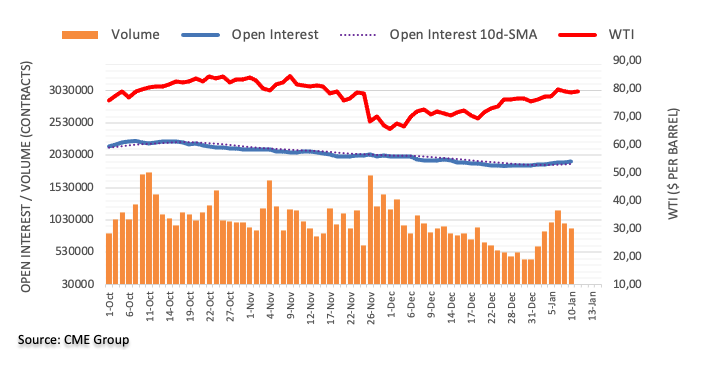
In opinion of FX Strategists at UOB Group, there is still chances for Cable to advance to the 1.3630 region in the next weeks.
Key Quotes
24-hour view: “Yesterday, we highlighted that GBP ‘is likely to move above 1.3600 but the next major resistance at 1.3630 is unlikely to come into the picture’. While our view was not wrong as GBP rose to 1.3603, we did not anticipate the subsequent sharp drop to 1.3533. The decline was however short-lived as GBP rebounded sharply from the low to close at 1.3579 (-0.14%). The sharp but short-lived swings have resulted in a mixed outlook. For today, GBP is likely to trade between 1.3540 and 1.3600.”
Next 1-3 weeks: “We highlighted yesterday (10 Jan, spot at 1.3590) that ‘upward momentum has built up further and a break of 1.3600 would indicate that GBP could advance to 1.3630, possibly 1.3660’. GBP subsequently edged above 1.3600 (high of 1.3603) before staging a surprisingly sharp pullback to 1.3533. The sharp pullback has dented the upward momentum somewhat but as long 1.3525 (no change in ‘strong support’ level from yesterday) is not breached, there is still chance for GBP to advance to 1.3630.”
Bank of Japan (BOJ) officials see price gains reaching near 2% in the second quarter on higher energy costs and supply-chain disruptions, MNI reports, citing sources familiar with the Japanese central bank’s thinking.
Key takeaways
“With a fiscal stimulus kicking in and the output gap turning positive around mid-2022, BOJ is looking at wages and costlier consumer goods to more pressure.”
“The BOJ has made efforts to narrow the output gap, the difference between actual and potential economic performance, through its easy policy and special measures: buys on corporate and services funding in tandem with the government efforts to spur wage gains, which have lagged.”
“A key test for sustained inflation will be wage negotiations this spring between major firms and workers that can set the tone for smaller companies afterwards.”
-
USD/JPY snaps three-day downtrend above 115.00 even as yields retreat, inflation eyed
Open interest in gold futures markets reversed the previous daily drop and went up by around 14.2K contracts on Monday as per flash data from CME Group. Volume, instead, shrank by around 104.5K contracts for the first time so far this year.
Gold now targets the $1,830 zone
Gold prices started the week on an upbeat mood amidst rising open interest. That said, further gains are likely in the very near term with the immediate target at recent highs in the $1,830 region.
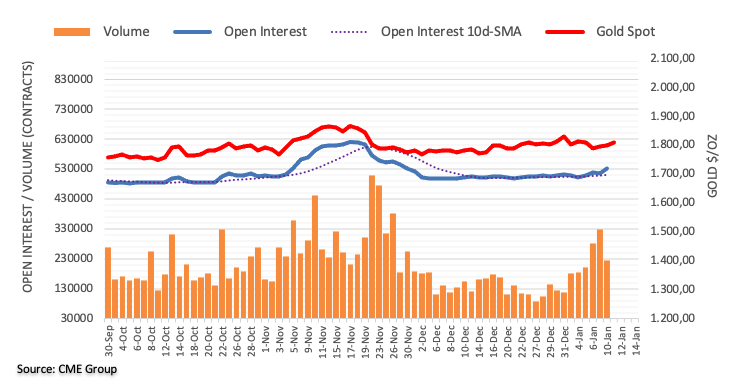
- Silver consolidates recent gains during three-day uptrend, stays inside bearish chart pattern.
- RSI pullback from overbought territory signals further weakness, 100-HMA offers immediate support.
- 200-HMA acts as a tough nut to crack for bulls.
Silver (XAG/USD) prices pare early day gains around $22.50 heading into Tuesday’s European session.
In doing so, the bright metal stays inside an immediate rising wedge bearish chart pattern.
Given the recent RSI retreat from overbought territory, the commodity’s latest weakness is likely to test the 100-HMA support of $22.45. However, any further weakness will be challenged by the stated wedge’s support line, near $22.40 at the latest.
Should the quote drop below $22.40, the odds of its slump to the monthly low near $21.95 can’t be ruled out.
It’s worth mentioning that the bottom marked during September and December months of 2021, around $21.40, becomes crucial support to watch afterward.
Alternatively, a clear upside break of $22.60 immediate resistance line, forming part of the wedge, will escalate rebound towards the 200-HMA level of $22.73.
Following that, a one-week-old descending trend line around $23.00 will gain the market’s attention.
Silver: Hourly chart
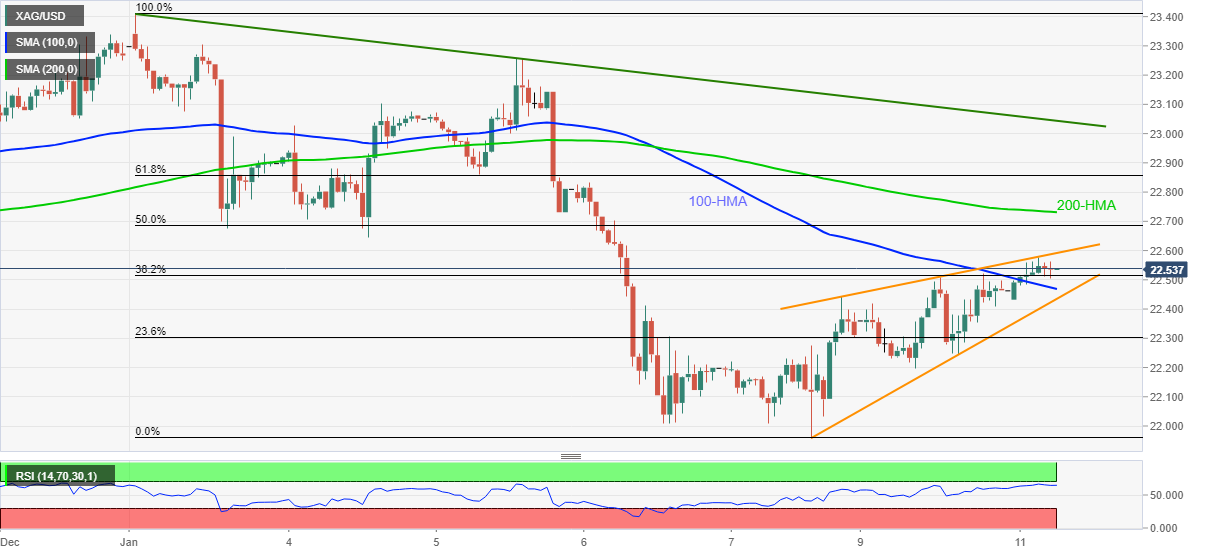
Trend: Further weakness expected
According to FX Strategists at UOB Group, EUR/USD still faces a mixed outlook in the next weeks.
Key Quotes
24-hour view: “Our expectations for the advance from last Friday to extend were incorrect as EUR plummeted briefly to 1.1283 before rebounding sharply to close at 1.1325 (-0.31%). The volatile price actions have resulted in a mixed outlook. For today, EUR could continue to trade in a choppy manner, likely between 1.1295 and 1.1365.”
Next 1-3 weeks: “One week ago (04 Jan, spot at 1.1305), we highlighted that the outlook for EUR is unclear and we expected it to trade between 1.1240 and 1.1395. EUR traded in a choppy manner the last several days and there is no change in our view for now.”
- Asian equities trade mixed as virus woes, geopolitical fears battle softer yields.
- South Korea, Japan oppose North Korea’s missile tests, Tokyo extends border restrictions until February.
- Retail Sales from Australia, Indonesia improved but markets await Fed’s Powell, inflation for clear direction.
- Hong Kong eyes another stimulus to battle the pandemic but China woes limit Hang Seng’s upside.
Asian shares traded mostly lower, sidelined of late, as cautious optimism at the broader front failed to ignore virus woes and geopolitical tensions inside the region.
That said, the MSCI’s index of Asia-Pacific shares ex-Japan rises 0.30% while Japan’s Nikkei begins trading week with 0.90% intraday losses heading into Tuesday’s European session.
Although Japan’s quarterly survey of spending hints at stronger inflation going forward, news suggesting the extension of border restrictions in Japan weigh on the quote. Japan’s Prime Minister (PM) Fumio Kishida announced, per Kyodo News, “The Japanese government will further extend an entry ban on non-resident foreigners until the end of February.” The news also adds, “The ban has been in place since Nov. 30 after the country confirmed its first case of the highly transmissible Omicron variant of the coronavirus.”
Elsewhere, North Korea’s second missile test in nearly a week pushes Japan and South Korea to raise their agitation in front of the United Nations (UN). However, China and Russia defend the hermit kingdom, indirectly, while pushing the UN to ease economic sanctions over Pyongyang.
Additionally, China announces the virus-led lockdown for a second city and drowns the stocks in Beijing. It’s worth noting that Hong Kong to roll out covid fund to support affected industries, which in turn helps Hang Seng to print mild gains even as Beijing-linked news probe the bulls.
Talking about data, Retail Sales figures from Australia and Indonesia improved for November. Though, neither Australia’s ASX nor Indonesia’s IDX Composite manages to ignore intraday losses.
On a broader front, hawkish comments from Fed Chair Jerome Powell, per the prepared remarks for today’s Testimony, join update on Merck’s covid treatment, to favor the risk-on mood of late.
The Fed Boss said, “The economy is growing at its fastest rate in years, and the labor market is robust.” However, his pledge to stop higher inflation from getting entrenched keeps the rate hike concerns on the table and weighs on the sentiment. It’s worth noting that comments from Merck’s official saying, “Expect Molnupiravir mechanism to work against omicron, any covid variant,” could be cited as positive for the risk appetite.
Against this backdrop, the US 10-year Treasury yields dropped 1.5 basis points (bps) to 1.757% after rallying to January 2020 levels during the previous day, before closing in negative on D1. Further, the 2-year bond coupons remain steady around March 2020 levels, near 0.90% at the latest. Additionally, S&P 500 Futures print 0.07% intraday gains.
That said, market plays are likely to remain divided ahead of Wednesday’s US inflation data. However, today’s testimony from Fed Chair Powell will be important to watch.
- Gold price to remain at the mercy of the Treasury yields’ price action.
- Powell likely to express concerns about US inflation ahead of Wednesday’s CPI.
- Gold 2022 Outlook: Correlation with US T-bond yields to drive yellow metal.
What is driving gold price higher? US Treasury yields sit close to the highest level in two years, as markets now price in four Fed rate hikes in 2022. Inflation emerges as a strong concern for the world’s most powerful central bank, as Chair Jerome Powell will likely say that the Fed will prevent inflation from becoming entrenched. Wednesday’s US Consumer Price Index (CPI) remains in the spotlight for a fresh direction on gold price.
Read: Gold Price Forecast: XAU/USD could extend the rebound if 50-DMA holds, focus on yields, US inflation
Gold Price: Key levels to watch
The Technical Confluences Detector shows that the gold price is heading towards a dense cluster of healthy resistance levels around $1,807, where SMA200 one-hour, SMA10 one-day and previous high four-hour coincide.
If the bullish momentum extends, then gold price could challenge the pivot point one-day R2 at $1,809, above which the confluence of the Fibonacci 61.8% one-week and Fibonacci 23.6% one-month at $1,813 will come into play.
Further up, buyers will aim for the pivot point one-day R3 at $1,818.
On the flip side, the immediate downside remains capped by $1,803, the SMA100 four-hour.
The next relevant support is seen around $1,801-$1800, which is the intersection of the SMA200 one-day, SMA100 one-hour and Fibonacci 38.2% one-month.
The Fibonacci 38.2% one-day at $1,798 will then come to the rescue of gold optimists. The last line of defense for bulls is envisioned at $1,794.
At that level, the Fibonacci 23.6% one-week meets with the SMA200 four-hour.
Here is how it looks on the tool
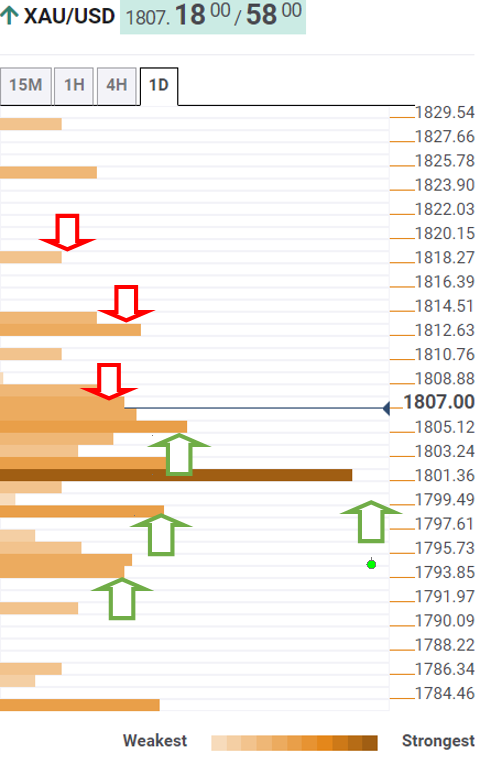
About Technical Confluences Detector
The TCD (Technical Confluences Detector) is a tool to locate and point out those price levels where there is a congestion of indicators, moving averages, Fibonacci levels, Pivot Points, etc. If you are a short-term trader, you will find entry points for counter-trend strategies and hunt a few points at a time. If you are a medium-to-long-term trader, this tool will allow you to know in advance the price levels where a medium-to-long-term trend may stop and rest, where to unwind positions, or where to increase your position size.
- WTI remains firmer around intraday top, snaps two-day pullback from mid-November highs.
- Short-term support break, bearish MACD signals challenge buyers.
- 50-SMA, support line of immediate bearish channel tests bears.
WTI crude oil prices gain for the first time in three days, up 0.50% around $78.35 heading into Tuesday’s European session.
The black gold stays inside a bearish trend channel formation, portrayed since last Thursday while remaining above the key moving averages.
Also challenging the WTI traders is the bearish MACD signal and the previous day’s downside break of an ascending support line from December 20, now resistance around $79.40.
That said, the commodity prices are likely to improve in the short-term with eyes on the upper line of the stated channel, near $78.85, a break of which will direct WTI prices towards the previous support line near $79.40.
During the quote’s upside past $79.40, the monthly top surrounding the $80.00 threshold, also the highest level since November 16, will be crucial to watch.
Meanwhile, a convergence of the nearby channel’s support line and 50-SMA limits short-term declines of the WTI near $77.20.
Following that, the 100-SMA and 200-SMA levels, respectively around $74.90 and $72.80, will challenge WTI crude oil sellers.
WTI: Four-hour chart
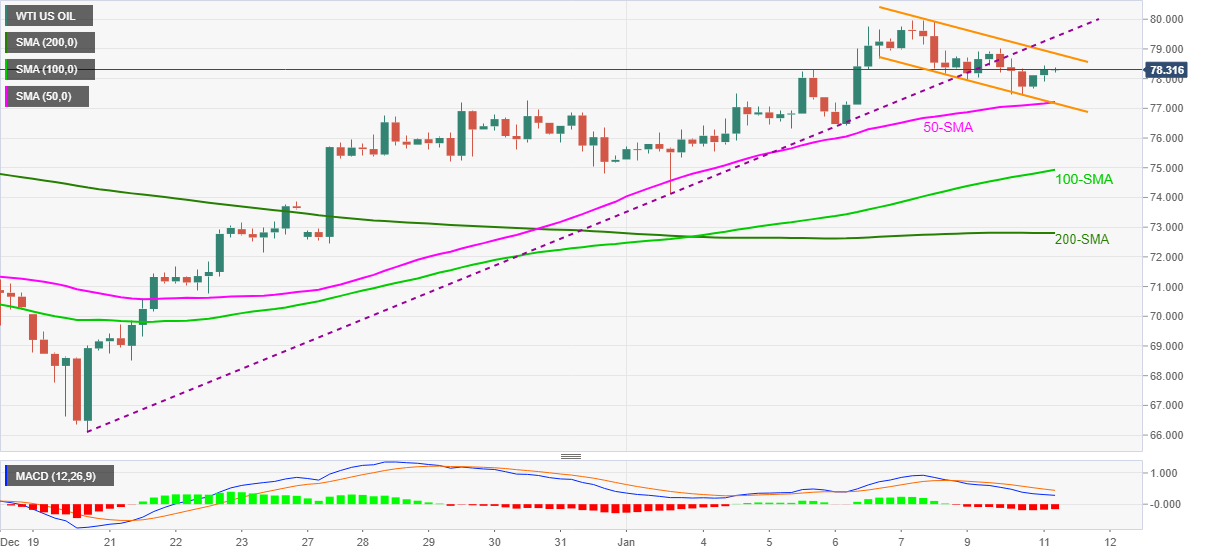
Trend: Further upside expected
- EUR/USD treads water after consolidating recent losses in early Asia.
- Fed’s Powell pledges to stop higher inflation from getting entrenched, virus woes worsen.
- Eurozone Sentix Investor Confidence jumped, Unemployment Rate eased.
- Tepid sentiment weigh on the USD as traders await speech from ECB’s Lagarde, Powell’s Testimony.
EUR/USD holds onto the early Asian session gains, taking rounds to 1.1350 ahead of Tuesday’s European session.
The pair buyers seem to track cautious optimism in the market, as well as recently firmer Eurozone data, to consolidate the previous day’s losses. Though, traders remain cautious ahead of a speech from the European Central Bank (ECB) President Christine Lagarde and a testimony from US Federal Reserve (Fed) Chairman Jerome Powell.
Hawkish comments from Fed Chair Jerome Powell, per the prepared remarks for today’s Testimony, join update on Merck’s covid treatment, to favor the risk-on mood of late.
The Fed Boss said, “The economy is growing at its fastest rate in years, and the labor market is robust.” However, his pledge to stop higher inflation from getting entrenched keeps the rate hike concerns on the table and weighs on the sentiment. It’s worth noting that comments from Merck’s official saying, “Expect Molnupiravir mechanism to work against omicron, any covid variant,” could be cited as positive for the risk appetite.
It’s worth noting that Eurozone’s investor sentiment unexpectedly improved in the first month of 2022, the latest data published by the Sentix research group showed on Monday. On the same line was the Eurozone Unemployment Rate of 7.2% for November versus 7.3% prior.
Alternatively, increasing chatters of Fed’s rate hike and a fresh record top of daily covid infections in the US challenges the EUR/USD pair buyers.
That said, the EUR/USD prices are likely to stay range-bound ahead of the week’s key events/data. Meanwhile, risk barometers may direct short-term pair moves.
Against this backdrop, the US 10-year Treasury yields dropped 1.5 basis points (bps) to 1.757% after rallying to January 2020 levels during the previous day, before closing in negative on D1. Further, the 2-year bond coupons remain steady around March 2020 levels, near 0.90% at the latest. Additionally, S&P 500 Futures print 0.07% intraday gains while stocks in the Asia-Pacific region trade mixed by the press time.
Although ECB’s Lagarde is likely to reiterate her cautious optimism, a major attention will be given to Fed’s Powell as the monthly Consumer Price Index (CPI) data looms for publishing on Wednesday.
Read: US Consumer Price Index December Preview: The Fed’s die is cast
Technical analysis
EUR/USD keeps the corrective pullback from an upward sloping support line from November 24 and the 200-SMA, respectively around 1.1300 and 1.1280.
Given the steady RSI and firmer Momentum lines, the latest rebound is likely extending towards a one-week-old resistance line near 1.1360. However, any further declines will be challenged by the December-end peak near 1.1385 and the 1.1400 threshold.
- USD/CAD stays pressured around intraday low, reverses the previous day’s rebound.
- Market sentiment dwindles amid Fed-linked anxiety, covid updates.
- Oil prices cheer softer yields, USD weakness to snap two-day downtrend.
USD/CAD remains on the back foot around 1.2650, down 0.17% intraday heading into Tuesday’s European session.
In doing so, the Loonie pair pays a little heed to the virus woes at home while cheering the cautious optimism at a macro front. Also favoring the quote are the firmer prices of Canada’s main export item, namely WTI crude oil.
“The US Centers for Disease Control and Prevention (CDC) and U.S. State Department on Monday advised against travel to neighboring Canada because of a rising number of COVID-19 cases as the Omicron variant spreads,” said Reuters. However, the news may become less worrisome compared to the Reuters’ tally that suggests a new record top of the US daily infections above 1.13 million.
On a different page, The hawkish comments from Fed Chair Jerome Powell, per the prepared remarks for today’s Testimony, could be considered as a major favor to the risk-on mood. The Fed Boss said, “The economy is growing at its fastest rate in years, and the labor market is robust.” However, his pledge to stop higher inflation from getting entrenched keeps the rate hike concerns on the table and weighs on the sentiment.
It’s worth noting that comments from Merck’s official saying, “Expect Molnupiravir mechanism to work against omicron, any covid variant,” could be cited as positive for the risk appetite.
Elsewhere, oil prices rise 0.33% intraday around $78.25 at the latest, snapping two-day declines, as the market’s optimism weighs on the US dollar’s safe-haven demand ahead of the key data/events.
While portraying the mood, the US 10-year Treasury yields dropped 1.5 basis points (bps) to 1.757% after rallying to January 2020 levels during the previous day, before closing in negative on D1. Further, the 2-year bond coupons remain steady around March 2020 levels, near 0.90% at the latest. Additionally, S&P 500 Futures print 0.07% intraday gains while stocks in the Asia-Pacific region trade mixed by the press time.
Looking forward, market players will keep their eyes on the covid updates for intermediate moves but Fed Chair Powell’s testimony and US Consumer Price Index (CPI) for December will be crucial for clear direction.
Read: US Consumer Price Index December Preview: The Fed’s die is cast
Technical analysis
Although 50-DMA, around 1.2700 at the latest, restricted USD/CAD recovery the previous day, the pair buyers remain hopeful until the quote prints a daily closing below the 100-DMA level of 1.2630.
- AUD/USD retreats from intraday top, stays up for the third consecutive day.
- 100-SMA, previous support restricts short-term upside amid sluggish MACD.
- 61.8% Fibonacci retracement lures sellers, bulls have multiple hurdles below 0.7300.
AUD/USD steps back from intraday high to 0.7185 heading into Tuesday’s European session. Even so, the Aussie pair prints a three-day uptrend by the press time.
AUD/USD portrays a Break-Pullback-Continuation (BPC) chart pattern on the four-hour play while observing Thursday’s rising wedge confirmation, followed by a corrective pullback from 50% Fibonacci retracement of December’s advances.
Given the recent U-turn from the previous resistance, the Aussie pair eyes further losses below the 0.7200 round figure, backed by receding bullish bias of the MACD signals.
That said, the latest swing low around 0.7140 acts as immediate support before the 61.8% Fibonacci retracement level around the 0.7100 threshold.
Adding to the downside filter is the December 20 bottom surrounding 0.7080, a break of which will make the quote vulnerable to aim for 2021 bottom near 0.6993.
It’s worth noting, however, that buyers will gain confidence on a clear upside break of the 0.7200 mark, comprising the 100-SMA and bearish wedge’s support line, now resistance.
Following that, the last monthly peak near 0.7275 and an upward sloping trend line from mid-December, close to 0.7315, will be in focus.
AUD/USD: Four-hour chart
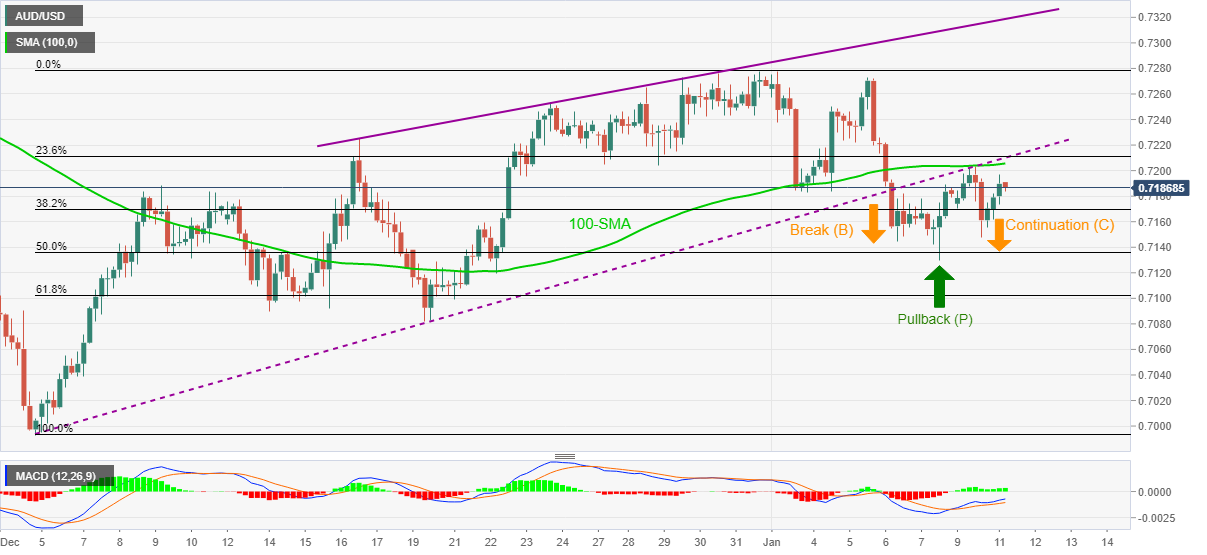
Trend: Further weakness expected
- USD/IDR keeps pullback from monthly top around one-week low.
- Indonesia Retail Sales jumped 10.8% in November versus 6.5% prior, Consumer Confidence eased in December.
- USD weakness adds to the pair’s bearish bias ahead of Fed’s Powell, US inflation.
USD/IDR remains on the back foot around $14,290, printing the fourth consecutive daily loss during early Tuesday.
The Indonesian rupiah (IDR) stays depressed amid upbeat Retail Sales data at home and the market’s cautious optimism, which weighs on the US dollar.
That said, the Indonesian Retail Sales rallied to 10.8% YoY in November, from 6.5% previous readouts. It’s worth noting that the Bank Indonesia (BI) Consumer Survey index remained upbeat at 118.3 in December, down from November’s 118.5.
Elsewhere, market sentiment remains dubious as traders await the US inflation data, as well as testimony from Fed Chair Jerome Powell.
The hawkish comments from Fed Chair Jerome Powell, per the prepared remarks for today’s Testimony, seem to favor the risk-on mood. The Fed Boss said, “The economy is growing at its fastest rate in years, and the labor market is robust.” However, his pledge to stop higher inflation from getting entrenched keeps the rate hike concerns on the table and weighs on the sentiment.
However, Reuters’ tally suggests a new record top of the US daily infections above 1.13 million. Alternatively, comments from Merck’s official saying, “Expect Molnupiravir mechanism to work against omicron, any covid variant,” could be cited as positive for the risk appetite.
Against this backdrop, the US 10-year Treasury yields dropped 1.5 basis points (bps) to 1.757% after rallying to January 2020 levels during the previous day, before closing in negative on D1. Further, the 2-year bond coupons remain steady around March 2020 levels, near 0.90% at the latest. Additionally, S&P 500 Futures print drop 0.07% intraday gains while stocks in the Asia-Pacific region trade mixed by the press time.
Looking forward, testimony by the Fed Chair Powell and Wednesday’s inflation becomes the key for markets while covid updates may offer intermediate clues.
Technical analysis
Although failures to cross November’s peak of $14,455 favors USD/IDR bears, the 100-DMA level near $14,270 restricts the immediate downside of the pair.
- DXY refreshes intraday low while reversing Monday’s gains.
- Bearish MACD signals, failures to stay beyond 96.00 keep sellers hopeful.
- 61.8% Fibonacci retracement level, two-month-old support line restricts short-term downside.
US Dollar Index (DXY) takes offers around 95.85, down 0.10% intraday during early Tuesday morning in Europe.
In doing so, the greenback gauge stays within a 70-pip trading range between an ascending support line from mid-November and a monthly resistance, respectively around 95.65 and 96.30.
Given the quote’s latest declines below the 50% Fibonacci retracement (Fibo.) level of November 15-24 upside, coupled with the bearish MACD signals, DXY prices are likely to witness further losses.
However, 61.8% Fibo. and the aforementioned support line, close to 95.70 and 95.65 in that order, challenges the gauge’s short-term downside.
Should the US Dollar Index (DXY) stay below 95.65, bears can eye for 95.50 and 95.00 supports.
Meanwhile, recovery moves may initially battle 50% and 38.2% Fibonacci retracement levels, around 95.18 and 96.20 respectively.
It’s worth noting that the DXY bulls remain cautious until the quote rises past 96.30, a break of which will recall the 96.70 and the 97.00 round figure on the chart.
DXY: Four-hour chart
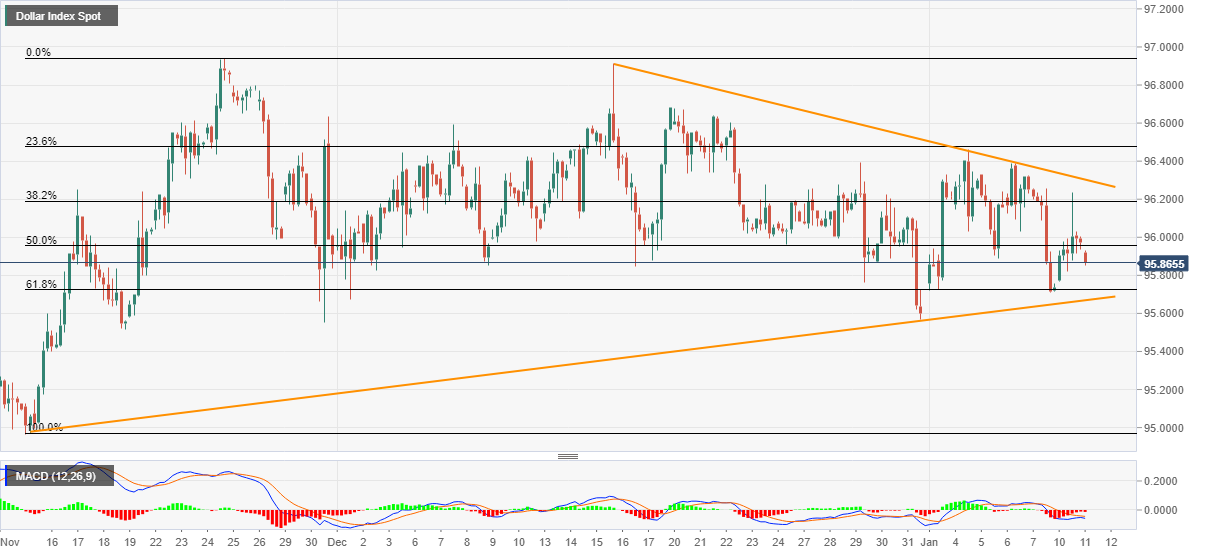
Trend: Further declines expected
Analysts at TD Securities (TDS) provide a snippet of what they expect from Fed Chair Jerome Powell’s testimony, especially after the hawkish FOMC minutes.
Key quotes
“Focus shifts to Fed speak with Powell's nomination hearing, where we will be on alert for hints about QT and lift-off timing. Judging by recent Fed rhetoric, it seems like the Fed is of the mindset of sooner rather than later when it comes to either major policy questions.”
“An affirmation of March tightening and early QT should support USD firmness overall though within well-established ranges.”
“Markets will focus on Chair Powell's renomination hearing at 10am EDT for direction. Recent hawkish comments from Fed members and the December FOMC minutes suggest that despite Omicron cases surging, the Fed may still look to hike and allow balance sheet runoff more quickly.”
| Raw materials | Closed | Change, % |
|---|---|---|
| Brent | 80.94 | -0.63 |
| Silver | 22.468 | 0.53 |
| Gold | 1801.602 | 0.36 |
| Palladium | 1902.02 | -1.17 |
- USD/INR seesaws near multi-day low, keeps bounce off 61.8% Fibonacci retracement level.
- Oversold RSI conditions signal corrective pullback towards 200-DMA.
- Ascending trend line from May adds to the downside filters.
USD/INR snaps four-day downtrend near the lowest levels last seen in November during early Tuesday. In doing so, the Indian rupee (INR) pair makes rounds to the 74.00 threshold.
The quote’s latest pause could be linked to the bounce off a 61.8% Fibonacci retracement (Fibo.) of May-December upside, as well as oversold RSI conditions.
It should be noted, however, that a clear downside break of the 200-DMA, around 74.30 at the latest, keeps USD/INR sellers hopeful.
Even if the pair crosses the 74.30 hurdle, a convergence of the previous support line from mid-September and 50% Fibo. will challenge the USD/INR buyers around 74.45.
On the contrary, a downside break of the immediate key Fibonacci support level of 73.96 will direct the pair towards an ascending support line from May, near 73.65.
Although the USD/INR weakness past 73.65 becomes less likely, sellers won’t hesitate to aim for September’s low of 72.90 if the support line breaks.
Overall, USD/INR sellers seem to have run out of fuel but buyers have major challenges before retaking the controls.
USD/INR: Daily chart
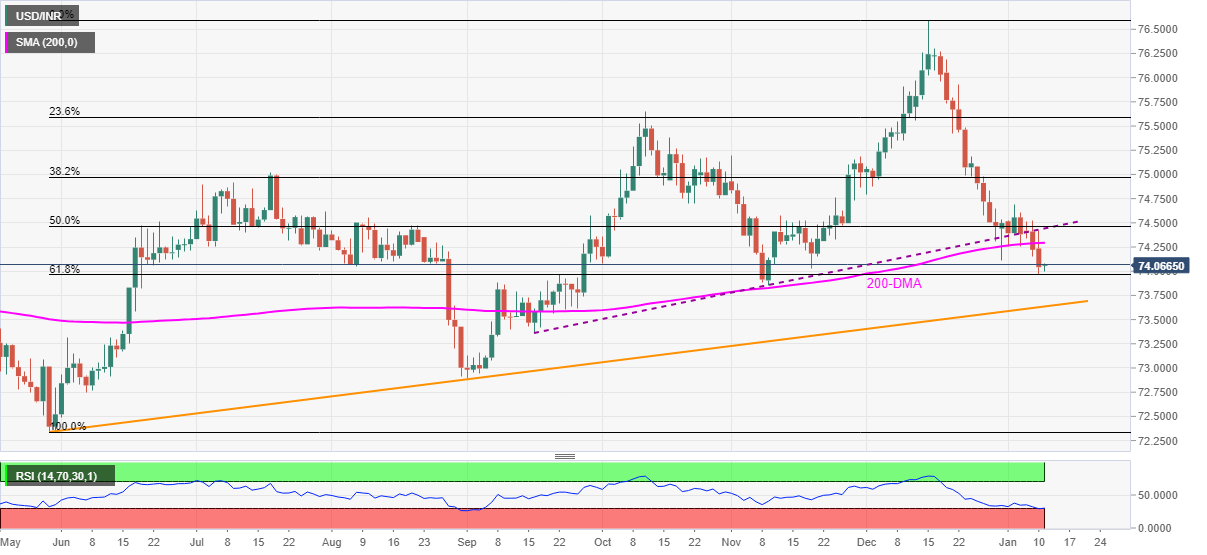
Trend: Recovery expected
Following his meeting with the UK Foreign Secretary Liz Truss on Monday, the Democratic Unionist Party (DUP) leader Sir Jeffrey Donaldson said that the British government must outline a timetable for how and when changes will be made to Northern Ireland (NI) Protocol.
Key quotes
“Told the foreign secretary, the UK's new lead negotiator with the EU in post-Brexit talks, that the government must guarantee there will be no checks on goods traveling from Great Britain that will stay within Northern Ireland.”
"For our part, we will use all measures at our disposal to continue to oppose the implementation of the current arrangements flowing from the protocol and we have made it clear to the government that we will not be implementers of protocol arrangements.”
"Balance can only be restored when Northern Ireland's place within the UK internal market is restored and the damaging protocol consequences are reversed.”
These comments come after Truss said on Sunday, she will not accept a deal which means goods from Britain being checked as they enter Northern Ireland.
Market reaction
GBP/USD is trading better bid near 1.3590, benefiting from a broad US dollar pullback, as the Treasury yields correct from two-year highs.
Markets have ignored the stalemate on the Brexit front lately, as the Fed sentiment remained the main market motor. However, the further upside could remain capped amid looming Brexit concerns while the UK makes progress on tackling the Omicron covid spread.
-
Explainer: Where next for GBP/USD and when it could tackle the 1.3150-1.32 support zone
The Financial Times (FT) quotes multiple economists, including former Bank of England official Tony Yates, to back UK PM Boris Johnson’s decision to ride out the Omicron wave of Covid-19 infections with minimal restrictions might turn out to be the right call for the economy.
Additional quotes
They have accused ministers of setting policy based on political expediency not strategy. But they believe Omicron is likely to pose only a modest jolt to the economy in December and January.
With Omicron’s health impact proving to be less severe than feared in a heavily vaccinated society, many economists now believe they will be able to look back at the latest variant as nothing more than an annoying blip for the UK economy by the spring.
Economists have little doubt that when the official figures for December and January are published, they will show a contracting level of output as consumers hunkered down before Christmas and into the new year, spending less in shops, pubs and restaurants.
A bigger problem for the growth outlook this year, economists said, was the rise in the cost of living, which would hit real incomes, especially after April.
Most expect the recovery from the initial pandemic shock to continue, with the pre-pandemic level of GDP surpassed in the first half of this year. But even with continued above-average growth rates, the UK economy is unlikely to return to its pre-pandemic trend this year.
Elsewhere, Reuters conveys the British Retail Consortium (BRC) survey details to mention, “British consumer spending picked up in November, boosted by earlier-than-usual Christmas shopping and a recovery in spending at pubs and restaurants before news of the Omicron variant of the coronavirus.”
“Total sales in November were 5.0% higher than a year earlier, the biggest annual increase since July and up from an increase of 1.3% in October,” the news adds.
Reuters also said, “Separate credit and debit card data from payments provider Barclaycard showed consumer spending - which includes things such as eating out and travel, as well as shopping - was 16.0% higher than in November 2019, before the pandemic.”
Read: GBP/USD Price Analysis: Eyes to regain 1.3600 inside weekly rising triangle
Analysts at Australia and New Zealand (ANZ) banking group offer their take on the potential Fed move, in light of surging US inflation.
Key quotes
“Surging US inflation is becoming broad-based, as evidenced by businesses’ increased ability to pass on higher price rises and accelerating wage growth amid an increasingly tight labor market.”
“Although the Fed’s tolerance for higher inflation has waned and its forward guidance has become more hawkish, it continues to underestimate the breadth and duration of intense inflation.”
“The 2022 inflation forecast made at the December meeting implies an unlikely soft landing. We expect the Fed will need to lift those forecasts along with its rate profile. “
“In response to the strong inflationary pulse, we expect the FOMC will start raising the target range for fed funds in March. We anticipate five 25bp rate hikes this year. Quantitative tightening will also play a role in policy tightening later in the year.”
- US 10-year Treasury yields drop, 2-year coupons stay sidelined around multi-day top.
- S&P 500 Futures, Asia-Pacific shares trade mixed amid concerns over US inflation, Fed rate hike.
- Powell’s remarks show readiness for tighter monetary policy as economics stay positive.
- Merck’s update on Molnupiravir Mechanism adds to the list of risk catalysts as covid cases rally.
Market sentiment remains sluggish during early Tuesday as traders await Fedspeak, as well as the US inflation data. Additionally, record covid cases and an update on the cure of the virus also challenge the traders during a quiet session.
Amid these plays, the US 10-year Treasury yields dropped 2.5 basis points (bps) to 1.757% after rallying to January 2020 levels during the previous day, before closing in negative on D1. Further, the 2-year bond coupons remain steady around March 2020 levels, near 0.90% at the latest. Additionally, S&P 500 Futures print drop 0.07% intraday while stocks in the Asia-Pacific region trade mixed by the press time.
Reuters’ tally suggests a new record top of the US daily infections above 1.13 million. However, comments from Merck’s official saying, “Expect Molnupiravir mechanism to work against omicron, any covid variant,” could be cited as positive for the risk appetite.
Also, the mixed reaction to the US Federal Reserve (Fed) Chairman Jerome Powell tests the traders of late. The hawkish comments from Fed Chair Jerome Powell, per the prepared remarks for today’s Testimony, could be considered as a major favor to the risk-on mood. The Fed Boss said, “The economy is growing at its fastest rate in years, and the labor market is robust.” However, his pledge to stop higher inflation from getting entrenched keeps the rate hike concerns on the table and weighs on the sentiment.
It’s worth observing that the escalating inflation fears and indecision over the covid stance trouble market players ahead of the key data/events. Among them, today’s testimony by the Fed Chair Powell and Wednesday’s inflation becomes the key.
Read: Forex Today: US inflation takes center stage this week
“Major economies should strengthen cooperation to avoid negative impact on each other as they unwind the ultra-loose monetary policies and fiscal stimulants in the post-pandemic era, “the People’s Bank of China (PBOC)-run newspaper Financial News reported, citing comments from Xiao Yuanqi, Vice Chairman of China Banking and Insurance Regulatory Commission (CBIRC).
Xiao said: “Countries should also act to bring inflation back into an acceptable range, as it is likely to cause serious social unrest should the income growth fails to keep up with price gains.”
Market reaction
USD/CNY was last seen losing 0.07% on the day, trading at 6.3717.
- NZD/USD is fsoggy in Asia as risk sentiment ebbs and flows.
- The Omicron variant continues to spread around the world.
At 0.6764, NZD/USD is higher on the day so far and has travelled between a low of 0.6756 to a high of 0.6773. However, there are a number of risks in play that could hinder any significant progress in the bird and the market is a little choppy.
The Kiwi was struggling a little this morning in the face of the generalised slump in global risk appetite overnight, as analysts at ANZ Bank pointed out, arguing that the price action still looks soggy.
''Market chatter points the finger of blame for the rout on the usual suspects – inflation, tighter policy and COVID, and in that environment, given how much positivity is priced in locally, New Zealand seemingly does have more to lose than other countries.''
''As we noted yesterday, the New Zealand economy benefitted from the outsized stimulus in 2020/21, but that was all funded by debt, and that could come home to roost in 2022,'' the analysts at ANZ argued.
Meanwhile, the Omicron variant continues to spread around the world. Inflation is a critical risk due to threats of lockdown and subsequent reopening of economic activity and pent up demand.
''Across the Tasman, worker absenteeism (as people isolate) is a significant constraint on some goods and services, adding to the inflationary soup,'' the analysts at ANZ bank said.
''New Zealand would likely be no different should Omicron case numbers spike here. We’re currently expecting annual CPI inflation to peak in Q1 at 5.8%, but renewed supply disruptions on the back of an Omicron outbreak could easily see inflation peak higher and later.''
- USD/TRY stays sluggish for the third consecutive day.
- 21-DMA, bullish MACD signals keep buyers hopeful but previous support line restricts immediate upside.
- Candlestick formation hints at pair buyers’ struggle amid lackluster markets.
USD/TRY carries the previous two-day indecision, treads water around $13.80 during early Tuesday.
Even so, the Turkish lira (TRY) manages to defend the 21-DMA breakout, backed by bullish MACD signals.
It should, however, be noted that the recent Doji candlesticks join the pair’s downside break of a 13-day-old ascending trend line to keep sellers hopeful.
Though, a sustained trading below the 21-DMA level of $13.30 becomes necessary for the pair to retest the monthly low near $12.75, a break of which will direct USD/TRY bears towards December’s bottom surrounding $10.25.
Meanwhile, recovery moves remain elusive below the previous support line, around $14.60 at the latest.
Following that, a run-up towards December’s high, also the all-time top of $18.36, can’t be ruled out.
USD/TRY: Daily chart
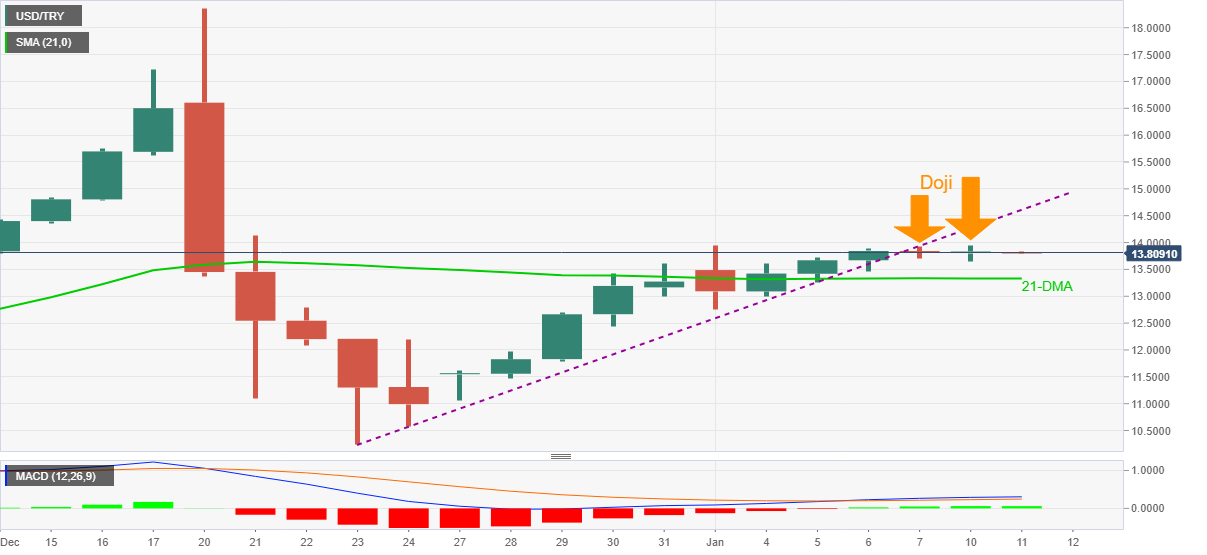
Trend: Sideways
In recent trade today, the People’s Bank of China (PBOC) set the yuan (CNY) at 6.3684 vs the previous fix of 6.3653 and the prior close of 6.3768.
About the fix
China maintains strict control of the yuan’s rate on the mainland.
The onshore yuan (CNY) differs from the offshore one (CNH) in trading restrictions, this last one is not as tightly controlled.
Each morning, the People’s Bank of China (PBOC) sets a so-called daily midpoint fix, based on the yuan’s previous day closing level and quotations taken from the inter-bank dealer.
| Time | Country | Event | Period | Previous value | Forecast |
|---|---|---|---|---|---|
| 00:30 (GMT) | Australia | Trade Balance | November | 10.781 | 10.6 |
| 00:30 (GMT) | Australia | Retail Sales, M/M | November | 4.9% | 3.9% |
| 05:00 (GMT) | Japan | Coincident Index | November | 89.8 | |
| 05:00 (GMT) | Japan | Leading Economic Index | November | 101.5 | |
| 14:30 (GMT) | U.S. | FOMC Member Esther George Speaks | |||
| 15:00 (GMT) | U.S. | Fed Chair Powell Testimony | |||
| 23:50 (GMT) | Japan | Current Account, bln | November | 1018.7 | 585 |
- USD/JPY extends bounce off one-week top, stays firmer around intraday high of late.
- North Korea again test-fires ballistic missile towards Japan, PM Kishida extends border restrictions until February.
- Fed’s Powell sounds optimistic on economics, Merck’s Molnupiravir mechanism to work against omicron, any covid variant.
- Powell’s testimony, yields and covid updates are in focus.
USD/JPY consolidates the recent losses around 115.30, rising for the first time in four days during early Tuesday.
The risk barometer pair portrays the market’s cautious optimism amid recently positive comments from the US Federal Reserve (Fed) Chairman Jerome Powell and on covid updates. However, the market’s inflation fears ahead of Wednesday’s US Consumer Price Index (CPI) data challenge the USD/JPY bulls.
With escalating covid numbers, Japan’s Prime Minister (PM) Fumio Kishida announced, per Kyodo News, “The Japanese government will further extend an entry ban on non-resident foreigners until the end of February.” The news also adds, “The ban has been in place since Nov. 30 after the country confirmed its first case of the highly transmissible Omicron variant of the coronavirus.”
Even so, the market’s sentiment remains firmer, weighing on US Treasury yields amid concerns relating to US economics and a cure for the coronavirus and its variants.
The hawkish comments from Fed Chair Jerome Powell, per the prepared remarks for today’s Testimony, could be considered as a major favor to the risk-on mood. The Fed Boss said, “The economy is growing at its fastest rate in years, and the labor market is robust,” to back his pledge to stop higher inflation from getting entrenched.
Additionally, comments from Merck’s official saying, “Expect Molnupiravir mechanism to work against omicron, any covid variant,” could also be cited as positive for the risk appetite.
It should, however, be noted that the market players remain cautious ahead of today’s testimony from Fed Chair Powell, as well as Wednesday’s US inflation data. Also challenging the risk appetite are the recently escalating covid cases and North Korea's frequent missile tests. Hence, USD/JPY licks its wounds but not out of the woods.
Technical analysis
With a clear downside break of an ascending trend line from December 17 and 10-DMA, respectively around 115.90 and 115.50, USD/JPY prices remain vulnerable to decline towards October’s peak of 114.70.
- AUD/JPY snaps four-day downtrend, extends recovery from 13-day low.
- Australia Retail Sales rallied in November, Trade Balance eased but Imports and Exports improved.
- 200-DMA, one-month-old support line restricts short-term downside.
- Buyers eye 61.8% Fibonacci retracement but further upside appears elusive.
AUD/JPY remains on the front foot while extending the bounce off a two-week low towards 83.00, up 0.22% intraday, during Tuesday’s Asian session.
The pair recently took clues from Australia’s key data points for stretching the first positive daily performance in five.
Australia’s Retail Sales rose past 3.9% forecasts and 4.9% prior to 7.3% MoM whereas the Trade Balance eased to 9423M versus 10600M expected and 11220M previous readouts, per the latest readings for December. Details suggest that the Exports and Imports both increased from -3.0% respective prior for each to 2.0% and 6.0% in that order.
In addition to the Aussie economics, the 200-DMA and an upward sloping trend line from early December also favor the AUD/JPY buyers to poke the 83.00 threshold by the press time.
Moving on, the 61.8% Fibonacci retracement of October-December downside, around 83.40, will lure the bulls but a five-week-old horizontal area near 84.15-30 will challenge the pair’s further upside.
Should the quote rises past 84.30, the late October’s swing low near 84.60 will act as an additional upside filter during the run-up to the year 2021 peak of 86.25.
Alternatively, the 200-DMA and stated support line, respectively around 82.65 and 82.50, limit the AUD/JPY pair’s short-term downside before directing the bears to the 38.2% Fibonacci retracement level of 81.63.
AUD/JPY: daily chart

Trend: Further advances likely
A series of data was released which has supported the Aussie.
December Retail Sales climbed past 3.9% forecasts and 4.9% prior to 7.3% MoM whereas the Trade Balance eased to 9423M versus 10600M expected and 11220M previous readouts.
AUD/USD impact
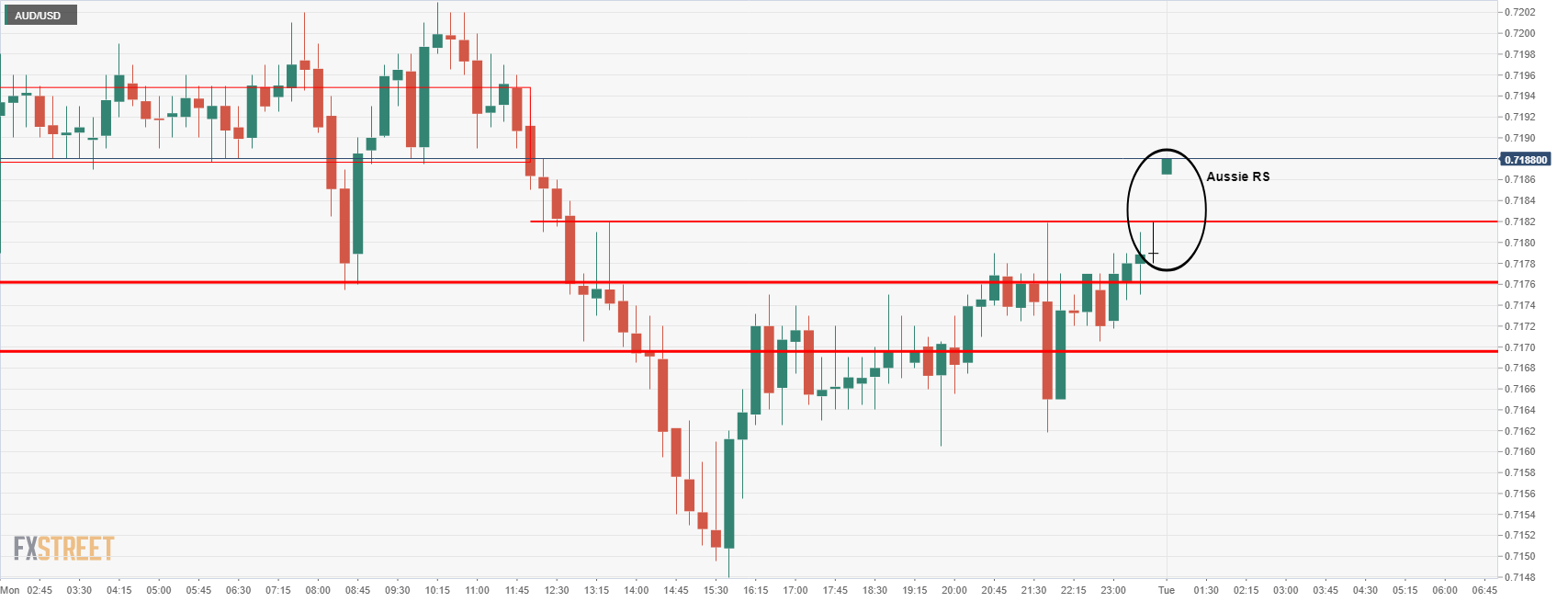
About the Retail Sales data
The primary gauge of Australia’s consumer spending, the Retail Sales, is released by the Australian Bureau of Statistics (ABS) about 35 days after the month ends. It accounts for approximately 80% of total retail turnover in the country and, therefore, has a significant bearing on inflation and GDP. This leading indicator has a direct correlation with inflation and the growth prospects, impacting the Reserve Bank of Australia’s (RBA) interest rates decision and AUD valuation. The stats bureau uses the forward factor method, ensuring that the seasonal factors are not distorted by COVID-19 impacts.
- GBP/JPY bears engaging in a phase of distribution.
- Bears to target the neckline of the weekly W-formation.
As per the prior analysis, GBP/JPY Price Analysis: Bears move in following bull rally, weekly W-formation eyed, the price is indeed making progress as per the W-formation. The following illustrates the market structure on a weekly time frame and prospects for a setup on the lower time frames:
GBP/JPY prior analysis
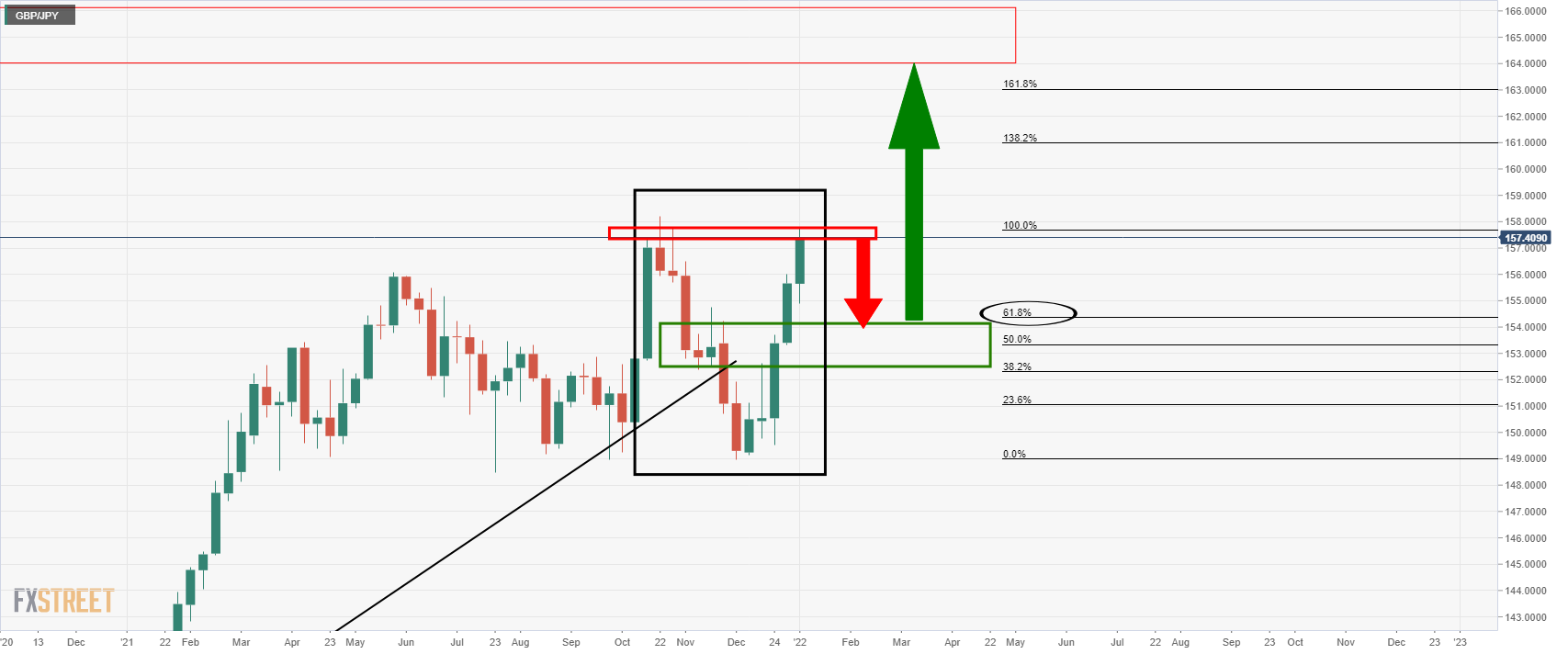
In last week's business, it was stated that ''the neckline,'' of the W-formation, '' has a high completion rate for the price to restest the zone, near to 153.40 in this case.''
GBP/JPY weekly chart
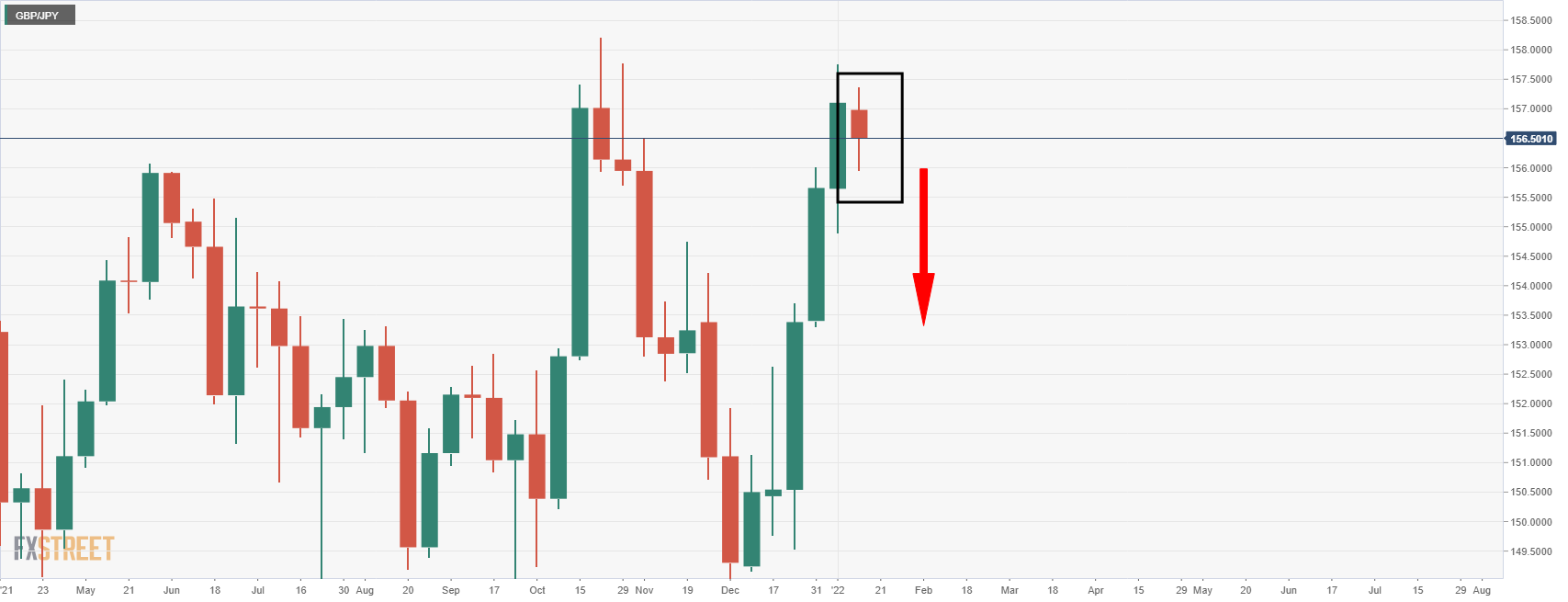
As seen, the price is starting to melt and traders can begin to look for bearish market conditions on lower time frames and structures from which engage:
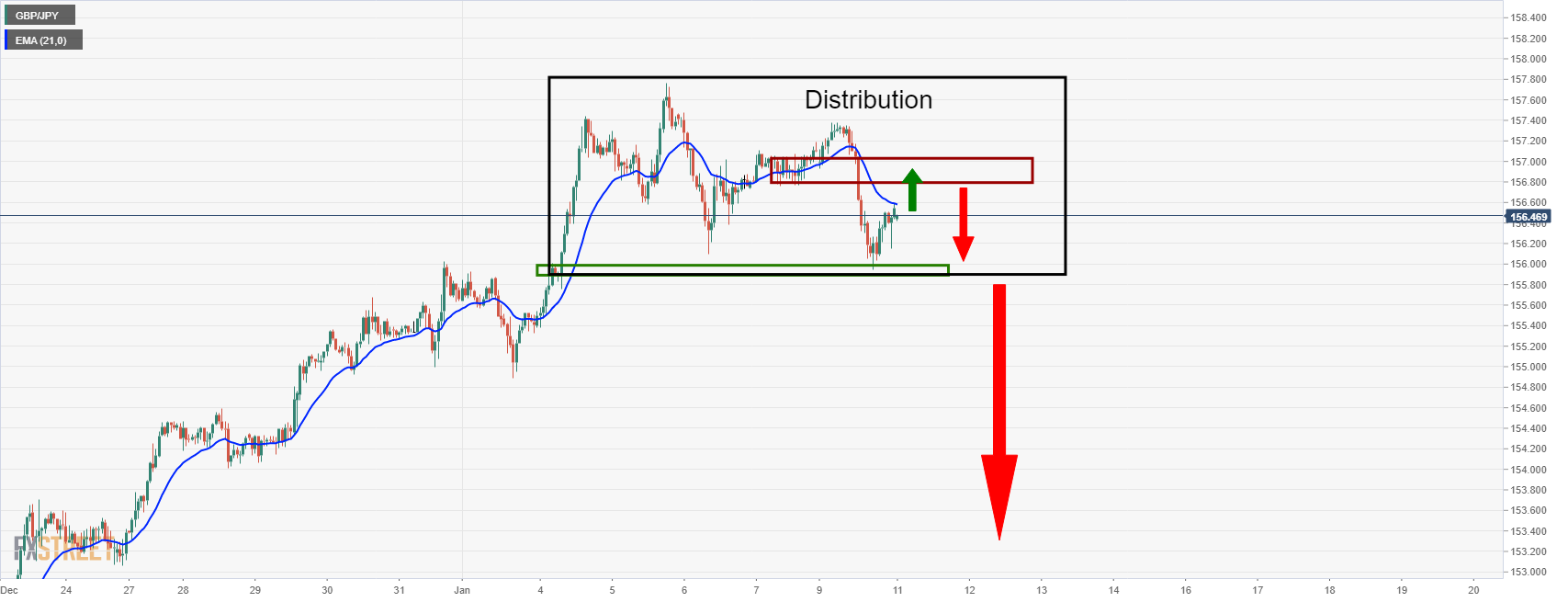
A break below 156.30 would be a welcome outcome for the bears seeking confirmation of the downside bias followed but a break of 155.90:
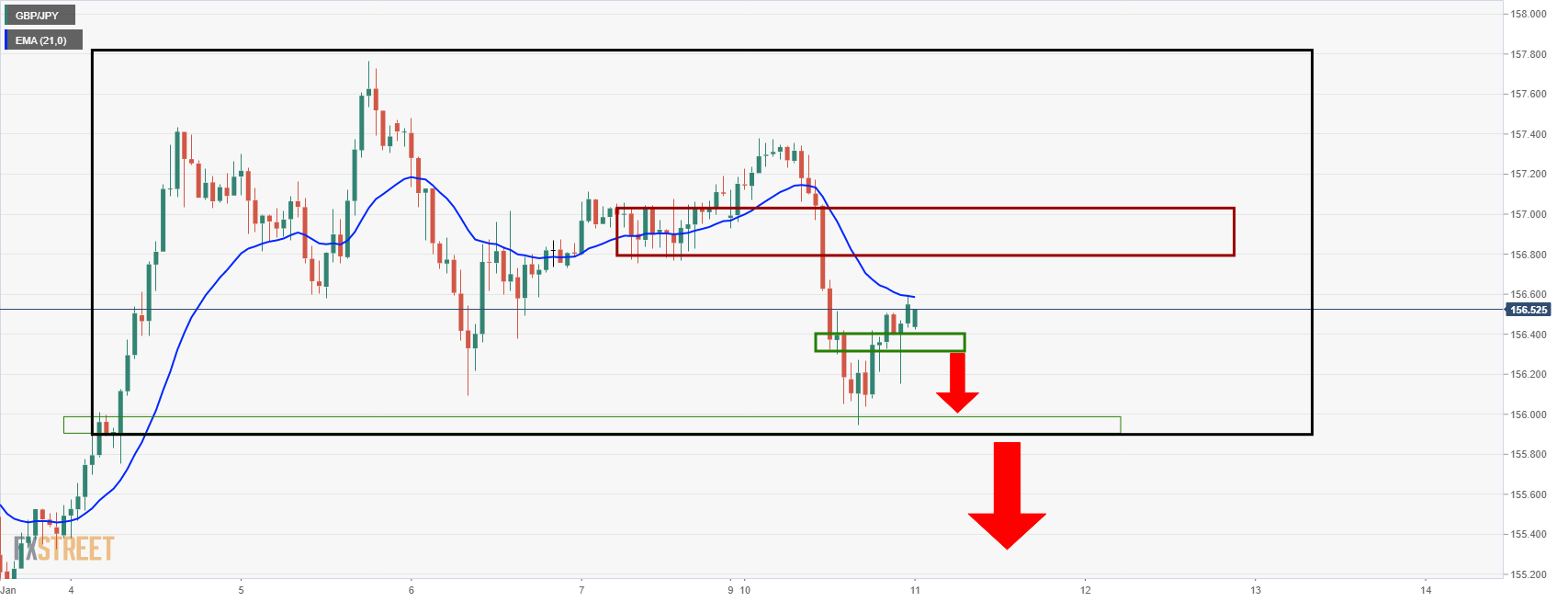
With that being said, there are prospects of a move into the resistance prior to the downside breakout, if indeed, this is a phase of distribution.
- AUD/USD refreshes intraday top despite mixed Aussie data.
- Australia Retail Sales rallied 7.3%, Trade Balance eased to 9423M in November.
- Risk appetite improves amid softer yields, hopes of faster economic transition and Omicron news.
- Fed’s Powell pledges to stop inflation from getting entrenched while citing economic optimism.
AUD/USD renew the daily peak near 0.7185, up 0.13% intraday, as mixed data at home joins the market’s cautious optimism to challenge immediate moves during early Tuesday.
Australia’s Retail Sales rose past 3.9% forecasts and 4.9% prior to 7.3% MoM whereas the Trade Balance eased to 9423M versus 10600M expected and 11220M previous readouts, per the latest readings for December. Details suggest that the Exports and Imports both increased from -3.0% respective prior for each to 2.0% and 6.0% in that order.
Other than the data, the market’s cautious optimism could also be cited as an additional catalyst for the AUD/USD pair’s recent gains, considering the pair’s risk-barometer status.
The hawkish comments from Fed Chair Jerome Powell, per the prepared remarks for today’s Testimony, could be considered as a major favor to the risk-on mood. The Fed Boss said, “The economy is growing at its fastest rate in years, and the labor market is robust,” to back his pledge to stop higher inflation from getting entrenched.
Additionally, comments from Merck’s official saying, “Expect Molnupiravir mechanism to work against omicron, any covid variant,” could also be cited as positive for the risk appetite.
It’s worth noting that the steady US inflation expectations, as per 10-Year Breakeven Inflation Rate numbers from the Federal Reserve Bank of St. Louis (FRED), also challenge the bears ahead of the key US Consumer Price Index (CPI) data for December, up for publishing on Wednesday.
Amid these plays, US stock futures print mild gains while the US 10-year Treasury yields extend the previous day’s pullback from the yearly top, down 2.3 basis points (bps) near 1.757% at the latest.
Looking forward, AUD/USD pair traders will keep their eyes on the Fed Chair Powell’s Testimony for further insights on rate hikes, which in turn can weigh on the Aussie prices. However, the market reaction, via yields and equities, will be important to watch for clear direction.
Technical analysis
Monday’s Doji candlestick below the 20-DMA hurdle of 0.7200 joins steady RSI and sluggish MACD to keep sellers hopeful of retesting the 0.7100 threshold.
JPMorgan's Chief Global Markets Strategist Marko Kolanovic backs the “buy the dip” scenario for equity investors while suggesting that the last week’s sell-off, due to the Fed Minutes’ “hawkish surprise”, is arguably overdone.
The bank representative also rules out firmer Treasury yields as a hurdle for equities while saying, “Higher bond yields should not be disruptive for equities, but rather support our call for a growth to value rotation.”
Additional comments from JP Morgan’s Kolanovic
We stay positive on equities and expect omicron will ultimately prove a positive for risk assets, as this milder but more transmissible variant speeds the transition from pandemic to endemic with a lower human toll.
As this wave fades, it will likely mark the end of the pandemic.
Omicron’s lower severity and high transmissibility crowds out more severe variants and leads to broad natural immunity.
Signs of supply constraints potentially passing their worst point.
Also read: S&P 500 dips under 4,600, eyes December lows, as Fed tightening fears provoke further selling
| Pare | Closed | Change, % |
|---|---|---|
| AUDUSD | 0.71744 | 0.05 |
| EURJPY | 130.523 | -0.57 |
| EURUSD | 1.13293 | -0.25 |
| GBPJPY | 156.444 | -0.3 |
| GBPUSD | 1.35797 | 0.05 |
| NZDUSD | 0.67595 | -0.22 |
| USDCAD | 1.26733 | 0.29 |
| USDCHF | 0.92713 | 0.91 |
| USDJPY | 115.204 | -0.33 |
- GBP/USD reverses the previous day’s pullback from two-month top.
- Bulls seem to have exhausted beyond 50-SMA, MACD hints at pullback.
- Horizontal resistance line from November joins triangle’s upper line to test bulls.
GBP/USD pares the previous day’s losses around 1.3580 amid Tuesday’s Asian session.
In doing so, the cable pair picks up bids inside short-term ascending triangle formation. However, steady RSI and sluggish MACD joins the pair’s failures to stay beyond 1.3600 keep sellers hopeful.
While the current advances eye 1.3600 threshold, the upper line of the stated triangle from December 31 and a horizontal line comprising multiple levels marked since November, highlight the 1.3610 level as the key hurdle.
Should the quote rises past 1.3610, which becomes less likely, a run-up towards November’s high near 1.3700 can’t be ruled out.
On the flip side, pullback moves may initially aim for the triangle’s lower line near 1.3550. Though, bears remain unconvinced beyond the 50-SMA level of 1.3530. Also acting as a downside filter is the latest December’s swing low near 1.3480 and the 200-SMA level of 1.3355.
Overall, GBP/USD pair’s inability to stay firmer around multi-day top teases sellers.
GBP/USD: Four-hour chart
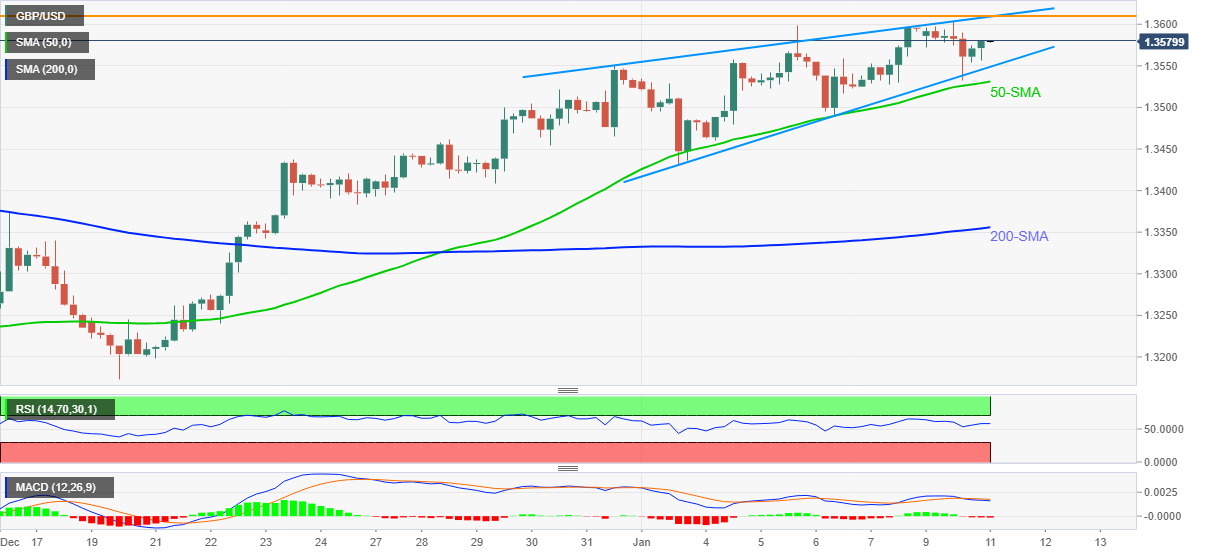
Trend: Pullback expected
© 2000-2024. All rights reserved.
This site is managed by Teletrade D.J. LLC 2351 LLC 2022 (Euro House, Richmond Hill Road, Kingstown, VC0100, St. Vincent and the Grenadines).
The information on this website is for informational purposes only and does not constitute any investment advice.
The company does not serve or provide services to customers who are residents of the US, Canada, Iran, The Democratic People's Republic of Korea, Yemen and FATF blacklisted countries.
Making transactions on financial markets with marginal financial instruments opens up wide possibilities and allows investors who are willing to take risks to earn high profits, carrying a potentially high risk of losses at the same time. Therefore you should responsibly approach the issue of choosing the appropriate investment strategy, taking the available resources into account, before starting trading.
Use of the information: full or partial use of materials from this website must always be referenced to TeleTrade as the source of information. Use of the materials on the Internet must be accompanied by a hyperlink to teletrade.org. Automatic import of materials and information from this website is prohibited.
Please contact our PR department if you have any questions or need assistance at pr@teletrade.global.















